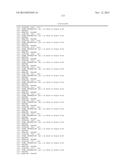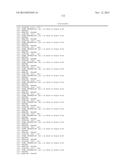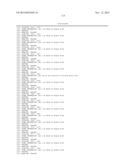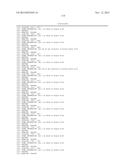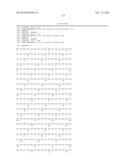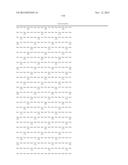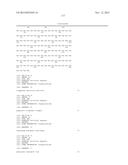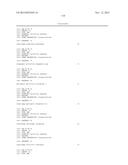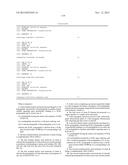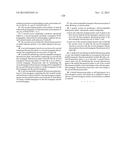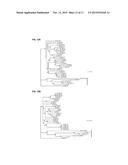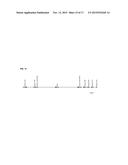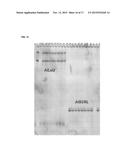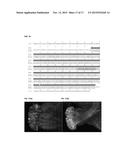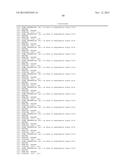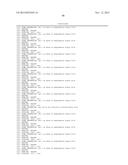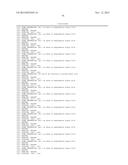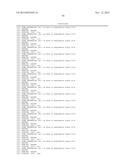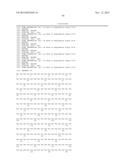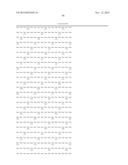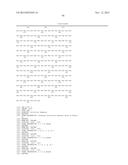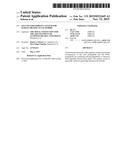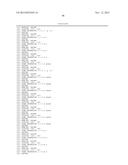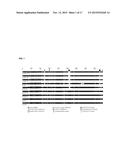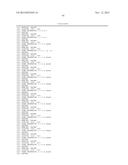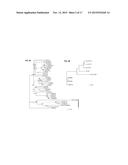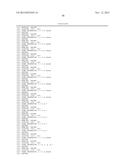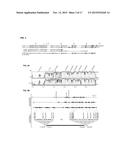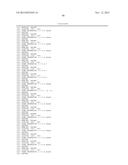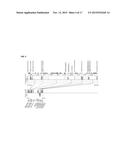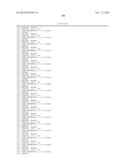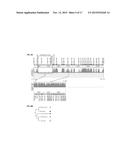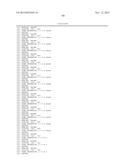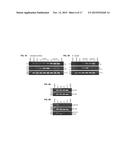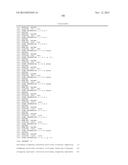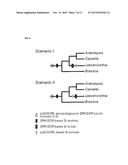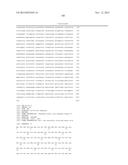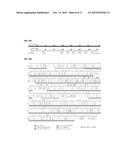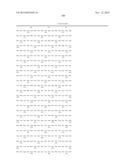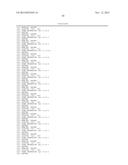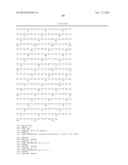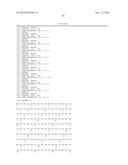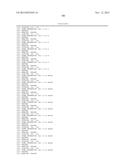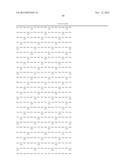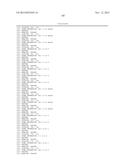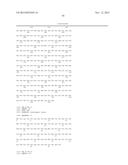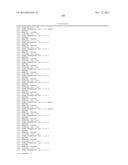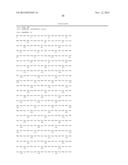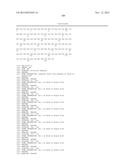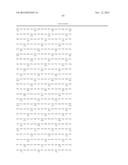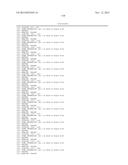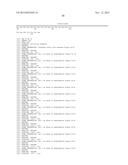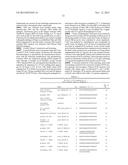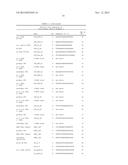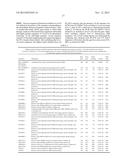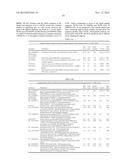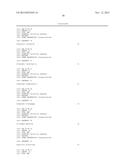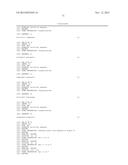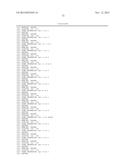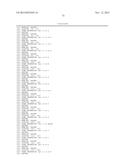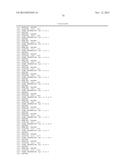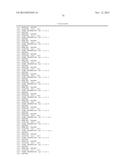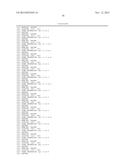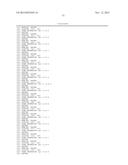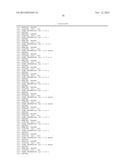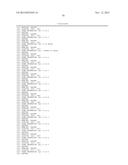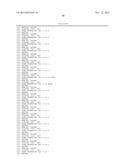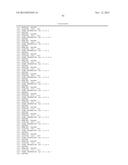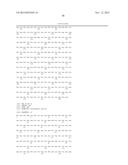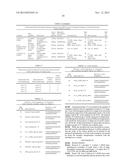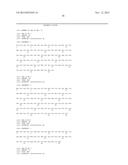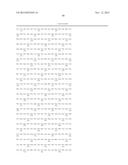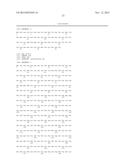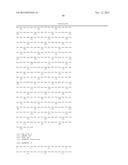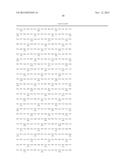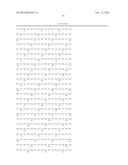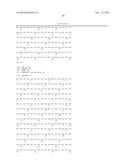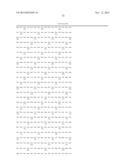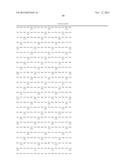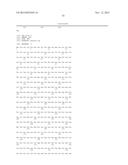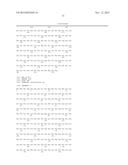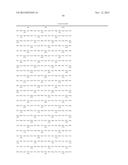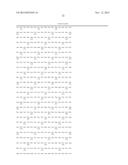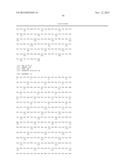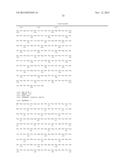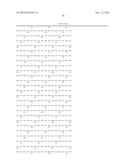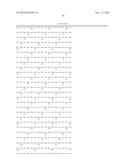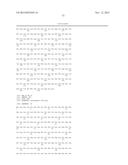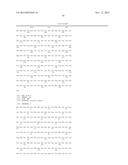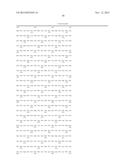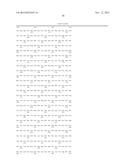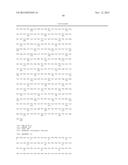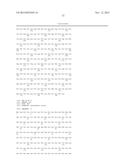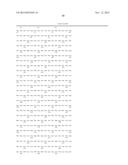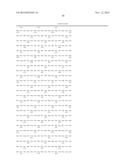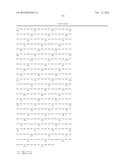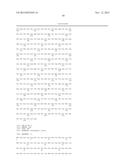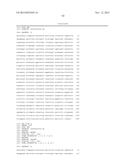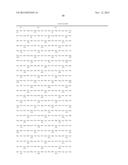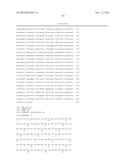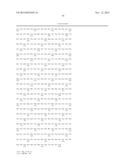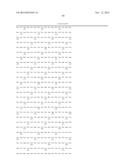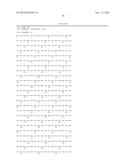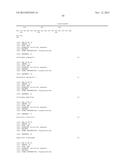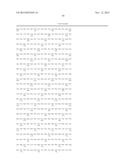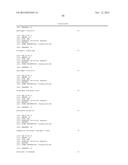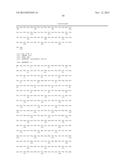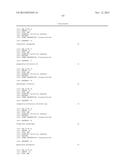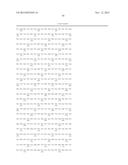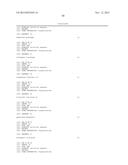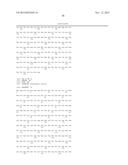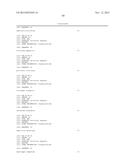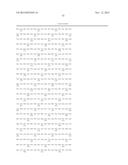Patent application title: SELF-INCOMPATIBILITY SYSTEM FOR MAKING BRASSICACEAE HYBRID
Inventors:
Daniel J. Schoen (St. Lambert, CA)
Sier-Ching Chantha (Montreal, CA)
IPC8 Class: AC12N1582FI
USPC Class:
800260
Class name: Multicellular living organisms and unmodified parts thereof and related processes method of using a plant or plant part in a breeding process which includes a step of sexual hybridization
Publication date: 2015-11-12
Patent application number: 20150322445
Abstract:
The present disclosure provides a genetic system based on the
co-expression of the Lal2 polypeptide and the SCRL polypeptide for
conferring self-incompatibility to otherwise self-compatible Brassicaceae
plants. The genetic system is especially useful for generating
Brassicaceae hybrids.Claims:
1. A first isolated nucleic acid molecule encoding for a Lal2
polypeptide, wherein the Lal2 polypeptide is capable of intracellular
signaling upon specifically binding to a SCRL polypeptide and is at least
one of: (i) a polypeptide having the amino acid sequence of SEQ ID NO:
66, (ii) a polypeptide encoded by a Lal2 gene ortholog, and (iii) a
variant polypeptide of the polypeptide of (i) or (ii) wherein the SCRL
polypeptide is derived from a SCRL gene located within 10 000 bp of a
corresponding Lal2 gene.
2. The first isolated nucleic acid molecule of claim 1 being a complementary DNA (cDNA.)
3. The first isolated nucleic acid molecule of claim 1, wherein the polypeptide of (i) has at least one cysteine residue at positions corresponding to amino acid residues 283, 289, 295, 301, 303, 324, 332, 362, 366, 370, 372 or 387 of SEQ ID NO: 66.
4. The first isolated nucleic acid molecule of claim 1, wherein the polypeptide of (i) has the amino acid sequence of any one of SEQ ID NO: 5 to 7.
5. A first vector comprising a promoter operatively linked to a first transgene encoding a transgenic Lal2 polypeptide, wherein the first transgene comprises the first isolated nucleic acid molecule of claim 1.
6. The first vector of claim 5, wherein the promoter is a stigma-specific or a stigma-active promoter.
7. A first transgenic Agrobacterium host cell, a first transgenic Brassicaceae plant or a first transgenic Brassicaceae cell comprising the first vector of claim 5.
8. A second isolated nucleic acid molecule encoding for a SCRL polypeptide, wherein the SCRL polypeptide is capable of specifically binding to a Lal2 polypeptide so as to allow the Lal2 polypeptide to mediate intracellular signaling and is at least one of: (i) a polypeptide having the amino acid sequence of SEQ ID NO: 72; (ii) a polypeptide encoded by a SCRL gene ortholog; and (iii) a variant polypeptide of the polypeptide of (i) or (ii); wherein the SCRL polypeptide is derived from a SCRL gene located within 10 000 bp of a corresponding Lal2 gene.
9. The second isolated nucleic acid molecule of claim 8 being a complementary DNA (cDNA).
10. The second isolated nucleic acid molecule of claim 8, wherein the polypeptide of (i) has at least one cysteine residue residues at positions corresponding to amino acid residues 56, 65, 69, 80, 89, 91, and 97 of SEQ ID NO: 72.
11. The second isolated nucleic acid molecule of claim 8, wherein the polypeptide of (i) has the amino acid sequence of any one of SEQ ID NO: 1 to 2.
12. A second vector comprising a promoter operatively linked to a second transgene encoding a transgenic SCRL polypeptide, wherein the second transgene comprises the second isolated nucleic acid molecule of claim 8.
13. The second vector of claim 12, wherein the promoter is an anther tapetum-specific or an anther tapetum-active promoter.
14. A second transgenic Agrobacterium host cell, a second transgenic Brassicaceae plant or a second transgenic Brassicaceae cell comprising the second vector of claim 12.
15. A method for producing a self-incompatible transgenic Brassicaceae plant, said method comprising (a) crossing the first transgenic Brassicaceae plant claim 8 with the second transgenic Brassicaceae plant of claim 14 so as to obtain a crossed transgenic Brassicaceae and (b) identifying the crossed transgenic Brassicaceae as being self-incompatible if the crossed Brassicaceae plant is a double-transgenic for the first transgene and the second transgene.
16. A self-incompatible transgenic Brassicaceae plant having (i) a first transgene comprising the first isolated nucleic acid molecule of claim 1 and (ii) a second transgene comprising the second isolated nucleic acid molecule of claim 8 and (ii) being a double-transgenic for the first transgene and the second transgene.
17. The self-incompatible transgenic Brassicaceae plant of claim 16 being a Camelina plant.
18. A genetic system for producing a self-incompatible Brassicaceae plant, said genetic system comprising: at least one of the first isolated nucleic acid of claim 1, the first vector of claim 5, the first transgenic Agrobacterium host cell, the first transgenic Brassicaceae plant or the first transgenic Brassicacea cell of claim 7; and at least one of the second isolated nucleic acid of claim 8, the second vector of claim 12, the second transgenic Agrobacterium host cell, the second transgenic Brassicaceae plant or the second transgenic Brassicacea cell of claim 14.
19. A method for producing an hybrid Brassicaceae plant or cell, said method comprising (a) crossing the self-incompatible transgenic Brassicaceae plant of claim 16 with a second Brassicaceae plant so as to provide a crossed Brassicaceae plant and (b) identifying the crossed Brassicaceae plant as the hybrid Brassicaceae plant or cell if the crossed Brassicaceae exhibits a first trait unique to the self-incompatible transgenic Brassicaceae plant and a first trait unique to the second Brassicaceae plant.
20. A hybrid Brassicaceae plant or cell hemizygous for a first transgenic nucleic acid molecule as defined in claim 1 and for a second transgenic nucleic acid molecule as defined in claim 8.
Description:
CROSS-REFERENCE TO RELATED APPLICATIONS AND DOCUMENTS
[0001] This application claims priority from U.S. provisional patent application 61/989,035 filed on May 6, 2014 which is incorporated herewith in its entirety. This application also contains an electronic version of the sequence listing (USPTOSequencelistingasfiled.txt of 221 Ko) which is incorporated herewith in its entirety.
TECHNOLOGICAL FIELD
[0002] The present disclosure relates to a sporophytic self-incompatibility system for making a transgenic plant of the Brassicaceae family (such as Camelina) suitable for hybridization.
BACKGROUND
[0003] The excessive use of petroleum-derived products has brought about both market-based and environmental concerns, and has spurred interest in the development of alternative sources of oil. One promising alternative is plant-derived oil. One of the possible crops that could serve as a substitute for industrial grade oil is the plant species Camelina sativa, an annual plant of the Brassicaceae family. Apart from its value as a replacement for petroleum in some industrial applications, the oil of this species has numerous desirable nutritional qualities, such as high levels of omega-3 fatty acids, polyunsaturated fats, long-chain fatty acids, vitamin E and antioxidants. Among its advantages to growers are the considerable yields achievable with low levels of input, its adaptability to a wide range of growing conditions (including to lands not normally used to grow other crops), and its seeds that contain a large amount of oil. At present the number of elite varieties of Camelina sativa is quite small, and additional gains in developing this crop into an even more viable oil substitute will benefit from advanced plant breeding.
[0004] Plant breeding typically involves both selection and controlled cross-pollination. For example, crosses are made between different lines, and desirable characteristics are retained by selection of progeny. Following such selective improvement, the bulk production of commercially useful quantities of seed may require cross-pollination, typically on a scale of thousands of plants or more. For instance, synthetic varieties are created by crossing a number of genotypes that possess good combining ability, whereas hybrids are typically created by cross pollination of two (or sometimes three or four) different parental lines. Hybrid and synthetic varieties offer a number of advantages such as precise genotype identification and multiplication, facilitation of combining multiple traits into one variety, profitable seed sales on an annual basis that attracts capital and provides incentives for continuous crop improvement, as well as the prospect of hybrid vigor (or heterosis)--the phenomenon of increased growth in the offspring over the parents achieved in a hybrid cross.
[0005] Because Camelina sativa is a naturally self-fertilizing plant (flowers are normally spontaneously self-pollinated), hybridization can only be achieved if self-pollination is prevented. For small numbers of crosses, removal or destruction of anthers (the pollen-bearing organs) prior to spontaneous self-pollination is possible, but it is not practical for large-scale breeding and seed production. To circumvent this problem in other naturally-self-pollinating crops, breeders have relied upon two types of interventions: (1) cytoplasmic male sterility (CMS), in which one parent in the cross possesses a genetic mutation that prevents the production of fertile pollen; and/or (2) self-incompatibility (SI), in which plants identify and reject their own pollen, and thus only produce seed with the pollen of another genotype. A CMS system has been prophecized for Camelina sativa based on one that exists for Canola (refer to, for example, WO2011/034945 filed on Sep. 15, 2010). Unfortunately, CMS and SI are not present in Camelina sativa populations, and thus there currently exists no simple means by which hybrid and synthetic lines can be produced.
[0006] Self-incompatibility (SI) is a widespread plant reproductive system that prevents inbreeding by facilitating the rejection of self-pollen. It is a major evolutionary feature of the flowering plants. SI is a complex phenotype whose functioning requires co-evolution among several interacting components. It has been proposed that SI evolved several times in the angiosperms, a hypothesis supported by molecular investigations that have also helped pinpoint the genes that control pollen specificity, pollen recognition, and the downstream reactions that mediate cessation of pollen tube growth. The evolutionary loss of SI leading to self-compatibility (SC) and the potential for the shift to self-fertilization is often stated to be irreversible.
[0007] Despite increasing knowledge of the mechanisms that underlie SI, the question remains as to how such a complex system could have evolved independently in many different angiosperm lineages. One answer may lie in the phenomenon of neo-functionalization of genes. It has been noted that the mechanisms that underlie SI share a number of features with another important plant function, namely pathogen recognition and rejection. Moreover, it has become increasingly clear that evolution can reshuffle and reshape functions through exon recruitment and domain swapping and so it is conceivable that SI could have evolved by co-opting genes with receptor and signaling roles that initially functioned in plant defense. Neo-functionalization of genes has been shown to be most likely when there are strong selection pressures. The avoidance of inbreeding and its negative fitness consequences provide one such selective context.
[0008] In the sporophytic type of self-incompatibility (SSI), the pollen and stigma SI phenotypes (or "specificities") are controlled by the diploid genotype of the parent (the sporophyte). SSI is known from 10 families of flowering plants. It has been best characterized in the Brassicaceae family. In Arabidopsis and Brassica (and several other closely related Brassicaceae), the self-incompatibility locus (S locus) contains two tightly linked genes that have been shown to be principally responsible for the SI phenotype. One of these genes, the S-locus receptor kinase (SRK), produces a transmembrane receptor expressed in the stigma. The extracellular domain of this protein can bind to the secreted protein ligand produced by the other S-locus gene, the S-locus cysteine-rich gene (SCR, also known as SP11), which is expressed in the tapetum of anthers, coating pollen with the protein product. When self-pollen recognition occurs, it initiates a signaling cascade that prevents self-pollen hydration and growth of the pollen tube.
[0009] It would be highly desirable to be provided with a genetic system to limit self-fertilization in Brassicaceae plants, such as Camelina, in order to develop hybrids of such plants. In some embodiment, the genetic system is a temporal one and can allow reversal to self-fertilization when necessary. Preferably, the genetic system does not exhibit consequences on overall fitness of the plant comprising such genetic system.
BRIEF SUMMARY
[0010] The present disclosure provides a genetic system for introducing sporophytic self-incompatibility in Brassicaceae plants, including Camelina plants. The genetic system comprises two components: a transgene coding for a Lal2 polypeptide and a transgene coding for a SCRL polypeptide. Plants possessing both transgenes exhibit self-incompatibility and can be used for producing hybrids.
[0011] According to a first aspect, the present disclosure provides a first isolated nucleic acid molecule encoding for a Lal2 polypeptide, wherein the Lal2 polypeptide is capable of intracellular signaling upon specifically binding to a SCRL polypeptide. The Lal2 polypeptide is at least one of: a polypeptide having the amino acid sequence of SEQ ID NO: 66, a polypeptide encoded by a Lal2 gene ortholog, and a variant polypeptide of the polypeptide of (i) or (ii). In an embodiment, the SCRL polypeptide is derived from a SCRL gene that is located within 10,000 base pairs from a corresponding Lal2 gene. In an embodiment, the first isolated nucleic acid molecule is a complementary DNA (cDNA). In another embodiment, the Lal2 polypeptide has at least one cysteine residue at positions corresponding to amino acid residues 283, 289, 295, 301, 303, 324, 332, 362, 366, 370, 372 or 387 of SEQ ID NO: 66. In still another embodiment, the Lal2 polypeptide has the amino acid sequence of any one of SEQ ID NO: 5 to 7.
[0012] According to a second aspect, the present disclosure provides a first vector comprising a promoter operatively linked to a first transgene encoding a transgenic Lal2 polypeptide, wherein the first transgene comprises the first isolated nucleic acid molecule described herein. In an embodiment, the promoter is a stigma-specific or a stigma-active promoter.
[0013] According to a third aspect, the present disclosure provides a first Agrobacterium host cell comprising the first vector described herein.
[0014] According to a fourth aspect, the present disclosure provides a first transgenic Brassicaceae plant or cell comprising the first vector described herein. In an embodiment, the first transgenic Brassicaceae plant or cell is hemizygous or homozygous for the first transgene. In yet another embodiment, the first transgenic Brassicaceae plant or cell is obtained by transforming a Brassicaceae cell with the first Agrobacterium host cell described herein. In yet another embodiment, the first transgenic Brassicaceae plant has a stigma expressing the transgenic Lal2 polypeptide encoded by the first isolated nucleic acid molecule. In still a further embodiment, the first transgenic Brassicaceae plant or cell is a Camelina plant or cell.
[0015] According to a fifth aspect, the present disclosure provides a second isolated nucleic acid molecule encoding for a SCRL polypeptide, wherein the SCRL polypeptide is capable of specifically binding to a Lal2 polypeptide so as to allow the Lal2 polypeptide to mediate intracellular signaling. The SCRL polypeptide is at least one of a polypeptide having the amino acid sequence of SEQ ID NO: 72; a polypeptide encoded by a SCRL gene ortholog; and a variant polypeptide of the SCRL polypeptide described herein. The SCRL polypeptide is derived from a SCRL gene located within 10,000 bp of a corresponding Lal2 gene. In an embodiment, the second isolated nucleic acid is a complementary DNA (cDNA). In another embodiment, the SCRL polypeptide has at least one cysteine residue residues at positions corresponding to amino acid residues 56, 65, 69, 80, 89, 91, and 97 of SEQ ID NO: 72. In still another embodiment, the SCRL polypeptide comprises the amino acid sequence of any one of SEQ ID NO: 1 to 2.
[0016] According to a seventh aspect, the present disclosure provides a second vector comprising a promoter operatively linked to a second transgene encoding a transgenic SCRL polypeptide, wherein the second transgene comprises the second isolated nucleic acid molecule described herein. In an embodiment, the promoter is an anther tapetum-specific or an anther tapetum-active promoter.
[0017] According to an eighth aspect, the present disclosure provides a second Agrobacterium host cell comprising the second vector described herein.
[0018] According to a ninth aspect, the present disclosure provides a second transgenic Brassicaceae plant or cell comprising the second vector described herein. In an embodiment, the second transgenic Brassicaceae plant or cell is hemizygous or homozygous for the second transgene. In yet another embodiment, the second transgenic Brassicaceae plant or cell is obtained by transforming a Brassicaceae cell with the second Agrobacterium host cell described herein. In still a further embodiment, the second transgenic Brassicaceae plant described herein has an anther expressing the second transgene encoded by the second isolated nucleic acid. In yet a further embodiment, the second transgenic Brassicaceae plant or cell is a Camelina plant or cell.
[0019] According to a tenth aspect, the present disclosure provides a method for producing a self-incompatible transgenic Brassicaceae plant, said method comprising (a) crossing the first transgenic Brassicaceae plant described herein with the second transgenic Brassicaceae plant described herein so as to obtain a crossed transgenic Brassicaceae and (b) identifying the crossed transgenic Brassicaceae plant as being self-incompatible if the crossed Brassicaceae plant is a double-transgenic for the first transgene and the second transgene.
[0020] According to an eleventh aspect, the present disclosure provides a self-incompatible transgenic Brassicaceae plant or cell having (i) a first transgene comprising the first isolated nucleic acid molecule described herein, (ii) a second transgene comprising the second isolated nucleic acid molecule described herein and (iii) being a double-transgenic for the first transgene and the second transgene. In an embodiment, the self-incompatible transgenic Brassicaceae plant or cell is obtained by the method described herein. In yet another embodiment, the self-incompatible transgenic Brassicaceae plant or cell is a Camelina plant or cell.
[0021] According to a twelfth aspect, the present disclosure provides a genetic system for producing a self-incompatible Brassicaceae plant. The genetic system comprises (i) at least one of the first isolated nucleic acid described herein, the first vector described herein, the first transgenic Agrobacterium host cell described herein and the first transgenic Brassicaceae plant or cell described herein and (ii) at least one of the second isolated nucleic acid described herein, the second vector described herein, the second transgenic Agrobacterium host cell described and the second transgenic Brassicaceae plant or cell described herein.
[0022] According to a thirteenth aspect, the present disclosure provides a method for producing a hybrid Brassicaceae plant or cell. The method comprises (a) crossing the self-incompatible transgenic Brassicaceae plant described herein with a second Brassicaceae plant so as to provide a crossed Brassicaceae plant and (b) identifying the crossed Brassicaceae plant as an hybrid Brassicaceae if the crossed Brassicaceae exhibits a first trait unique to the self-incompatible transgenic Brassicaceae plant and a first trait unique to the second Brassicaceae plant. In an embodiment, the method further comprises providing self-compatibility to the identified hybrid Brassicaceae.
[0023] According to an fourteenth aspect, the present disclosure provides a hybrid Brassicaceae plant or cell hemizygous or homozygous for the first transgenic nucleic acid molecule as defined herein and for the second transgenic nucleic acid molecule defined herein. In an embodiment, the hybrid Brassicaceae plant or cell is produced by the method described herein. In yet another embodiment, the hybrid Brassicaceae plant or cell is a Camelina plant or cell.
BRIEF DESCRIPTION OF THE DRAWINGS
[0024] Having thus generally described the nature of the invention, reference will now be made to the accompanying drawings, showing by way of illustration, a preferred embodiment thereof, and in which:
[0025] FIG. 1 provides a schematic representation of aligned sequences and protein domain organization of Lal2 alleles and closely related gene family members. The amino acid sequences of Leavenworthia a1-1, a2 and a4 LaLal2 alleles, Arabidopsis lyrata AlLal2 (NCBI Gene ID 930517), A. lyrata SRK14 (a class B SRK allele), Brassica oleracea SRK12, Arabidopsis halleri SRK43, as well as A. thaliana ARK3 and ARK1 were aligned along with their annotated domains. Thick black bars represent amino acid regions and thin lines represent gaps of one or more amino acids introduced to optimize the alignment. Arrows highlight alignment gaps observed specifically in all Lal2 sequences. Circles indicate alignment gap found in region of all Lal2 sequences and in AlSRK14 corresponding to the DUF3660 and DUF3403 domains of all other sequences. Protein domains are represented with patterned boxes and their accession numbers are indicated in parentheses next to corresponding names in the legend.
[0026] FIG. 2A-B provides a phylogenetic reconstruction of the relationships among Lal2, ARK and SRK sequences and among Lal2-like sequences in the Brassicaceae. Bayesian 50% consensus phylogeny for the full coding sequence of Lal2, ARK and SRK sequences. (A) Posterior probabilities for each bifurcation are indicated at the nodes. Lal2 sequences form a clade separate and distinct from ARK and SRK sequences (vertical bar). The phylogeny in (B) was generated in PhyML and used to test for codon-specific positive selection with the branch-site model. Positive selection was allowed in the foreground branches (indicated with dashed lines). Outgroups are identified by their NCBI gene ID numbers.
[0027] FIG. 3 provides an alignment of amino acid sequences of Leavenworthia and A. lyrata SCRL alleles. The A. lyrata AlSCRL sequence corresponds to NCBI Gene ID--9305018 (SEQ ID NO: 67). The a1-1 and a1-2 LaSCRL alleles (respectively SEQ ID NO: 1 and 2) are from the SI race and have full open reading-frames while the a2 and a4 alleles (respectively SEQ ID NO: 3 and 4) are from SC races and encode truncated proteins. In the a1-1 and a1-2 alleles, gray box highlights the predicted signal peptide; arrow indicates conserved position of the intron; arrowhead marks the predicted cleavage site of the a1-1 and a1-2 preproteins. Cysteines found in the predicted mature protein sequences are boxed. Asterisks represent stop codons. Hyphens represent gaps that were introduced to optimize the alignment. Consensus between Leavenworthia alleles a1-1 and a1-2 LaSCRL is shown in SEQ ID NO: 72.
[0028] FIG. 4A-B illustrates the characterization of the S locus genomic region in Leavenworthia. (A) VISTA alignment showing sequence conservation in a selected region of the Leavenworthia a1-1, a2 and a4 S haplotypes. The a4 S haplotype was used as the reference sequence. Arrows indicate genes annotated using the A. thaliana reference genome. (B) Structural gene organization of the Leavenworthia S haplotypes and synteny with a region of A. thaliana chromosome 4. Arrows represent genes in the Leavenworthia S haplotypes (black) and in the syntenic region of A. thaliana (white). Thick gray dashed lines represent unavailable sequences in the a2 and a1-1 S haplotypes. Thin dashed lines indicate orthologous genes within Leavenworthia. For clarity, only syntenic genes were identified above corresponding white arrows in the A. thaliana region and are connected to Leavenworthia orthologous genes by thin gray lines. Vertical arrows indicate the 5' or 3' borders of regions syntenic to A. thaliana chromosome 4.
[0029] FIG. 5 illustrates synteny of a genomic region in Arabidopsis lyrata scaffold 7 and the Lal2 S-locus region of Leavenworthia. Mauve alignment of A. lyrata scaffold 7 region between positions 852,500 and 1,060,200 (from gene AT4G37830/NCBI gene ID 9303002 to AT4G39950/NCBI gene ID 9302972) and a selected region of the a4 fosmid clone sequence. Collinear and homologous regions are represented by blocks connected by a line. In the Leavenworthia sequence, the block located below the thin black line represents an inverted region. Annotated genes are shown above the A. lyrata panel and below the Leavenworthia panel. Genes were annotated with the A. thaliana reference genome and the NCBI Gene ID numbers for A. lyrata genes is also given. Gray arrows represent genes found in both A. thaliana and Leavenworthia syntenic regions; black arrows represent genes found in A. thaliana only. For clarity, only genes found in the syntenic region of Leavenworthia are identified and also NCBI Gene ID 9302985. Underlined are SCRL and LaLal2 genes in the Leavenworthia core S-locus region and their orthologous A. lyrata genes NCBI gene ID--9305018 (AlSCRL) and NCBI gene ID--9305017 (AlLal2).
[0030] FIG. 6A-B illustrates the Arabidopsis S locus in Leavenworthia and S locus positions in Brassicaceae genera. (A) Mauve alignment showing synteny of the A. thaliana chromosome 4 region comprised between positions 11,349,900 bp and 11,492,100 bp (from genes At4g21330 to At4g21620) and a selected region of 64,800 bp of Leavenworthia genome scaffold 1085. Annoted genes are shown above the A. thaliana panel and below the Leavenworthia panel. Black arrows represent genes found in both A. thaliana and Leavenworthia syntenic regions; white arrows represent genes found in A. thaliana only. Boxed area highlights the A. thaliana core S-locus region that corresponds to a large deletion in Leavenworthia. For clarity, only syntenic genes and genes found in A. thaliana core S locus are identified above corresponding arrows. (B) Phylogeny of five Brassicaeae genera for which S locus synteny information is available. Black square denotes that the S locus is found in a region flanked by genes At4g21350 (PUB8) and At4g21380 (ARK3). Black circle denotes that the S locus is found in a region flanked by genes At1g66680 and At1g66690. Black star denotes that the S locus is found in a region flanked by genes At4g37910 and At4g40050.
[0031] FIG. 7A-B provides the expression pattern analysis of Lal2 and SCRL by RT-PCR in vegetative and reproductive tissues. (A) Expression of the LaLal2 and LaSCRL in a Leavenworthia plant homozygous at the a1-1 S haplotype. (B) Expression of AlLal2 and AlSCRL in a self-incompatible A. lyrata plant.
[0032] FIG. 8A-B provides the expression analysis by RT-PCR of LaLal2 and LaSCRL alleles in Leavenworthia SI and SC plants homozygous at the S locus. (A) Expression analysis of LaLal2 alleles in stigmas collected two days before anthesis. Asterisks indicate bands corresponding to an alternatively spliced form of LaLal2 transcripts. The ACTIN gene was used as an internal control. (B) Expression analysis of LaSCRL alleles in anthers collected two days before anthesis. Because of the high sequence divergence between the different SCRL alleles, primer pairs used for amplification were allele-specific except for the a2 and a1-2 alleles, for which the same primer pair was used. The ACTIN gene was used as an internal control. Genomic DNA extracted from the four haplotypes was used to amplify SCRL with their respective primer pairs to show that all the primer pairs used in PCR reactions amplify SCRL.
[0033] FIG. 9 illustrates possible evolutionary scenarios to account for the unique characteristics of the Leavenworthia S locus. Scenario I: Lal2/SCRL pollen protein-receptor function evolves from SRK/SCR paralogs in the Leavenworthia lineage, following the loss of SRK/SCR-based SI in this lineage. Scenario II: Lal2/SCRL pollen protein-receptor function evolves from SRK/SCR paralogs in the Leavenworthia lineage and two separate S loci coexist for a portion of the history of the Leavenworthia lineage, following by eventual loss of SRK/SCR in this lineage.
[0034] FIG. 10A-B provides a sequence analysis of LaLal2. (A) Schematic representation of the alignment of the a4 LaLal2 genomic DNA and cDNA sequences. Exons are represented with white boxes and their sizes in bp are indicated in parenthesis. (B) Alignment of predicted amino acid sequences of the a1-1 (SEQ ID NO: 5), a2 (SEQ ID NO: 6) and a4 (SEQ ID NO: 7) alleles of LaLal2. Amino acid sequences were deduced from cDNA sequences. Consensus sequence (SEQ ID NO: 66) is shown above allele sequences with X representing residues not conserved in the three alleles. Sequences of the predicted protein domains determined by the SMART/Pfam programs for the a1-1 LaLal2 allele are highlighted using the pattern code shown below. Black arrows indicate the twelve conserved cysteine residues in the extracellular domain. The kinase domain possesses the eleven kinase subdomains (I to XI) as established by Hanks et al. (1988).
[0035] FIG. 11A-B provides (A) the amino acid sequence alignment of Lal2 alleles and related sequences. Leavenworthia LaLal2 alleles (a1-1 as shown in SEQ ID NO: 5, a2 as shown in SEQ ID NO: 6 and a4 as shown in SEQ ID NO: 7), A. lyrata AlLal2 (NCBI Gene ID 930517 as shown in SEQ ID NO: 68), Lal2-like sequences from C. rubella (Carubv10025960m as shown in SEQ ID NO: 8), B. rapa (Bra010990 as shown in SEQ ID NO: 9) and, a selection of full-length coding sequences of SRK alleles from A. lyrata (SRK14 as shown in SEQ ID NO: 10, SRK01 as shown in SEQ ID NO: 11, SRK25 as shown in SEQ ID NO: 12), A. halleri (SRK28 as shown in SEQ ID NO: 13, SRK13 as shown in SEQ ID NO: 14, SRK43 as shown in SEQ ID NO: 15), and Brassica sp. (SRK12 as shown in SEQ ID NO: 16, SRK54 as shown in SEQ ID NO: 17, SRK60 as shown in SEQ ID NO: 18) as well as A. thaliana ARK3 (SEQ ID NO: 19) and ARK1 (SEQ ID NO: 20) were aligned. AlSRK14 and AhSRK28 belong to class B SRK alleles. Consensus sequence (SEQ ID NO: 69) is shown above sequences with X representing residues not conserved. The approximate positions of protein domains are indicated bellow the aligned sequences. Dashes represent gaps introduced to optimize the alignment. Black arrows highlight alignment gaps observed specifically in all Lal2 sequences. Black circles indicate alignment gaps found in the regions of all Lal2 sequences and in class B AlSRK14 and AhSRK28 alleles corresponding to the DUF3660 and DUF3403 domains in all other sequences. This figure also provides (B) the amino acid sequence alignment of Lal2 alleles as well as those encoded by Lal2 orthologs. Leavenworthia LaLal2 alleles (a1-1 as shown in SEQ ID NO: 5, a2 as shown in SEQ ID NO: 6 and a4 as shown in SEQ ID NO: 7), A. lyrata AlLal2 (NCBI Gene ID 930517 as shown in SEQ ID NO: 68), Lal2-like sequences from C. rubella (Carubv10025960m as shown in SEQ ID NO: 8), B. rapa (Bra010990 as shown in SEQ ID NO: 9) Consensus sequence (SEQ ID NO: 73) is shown above sequences with X representing residues not conserved.
[0036] FIG. 12A-B provides a phylogenetic reconstruction of the relationships among Lal2, Lal2-like, ARK, and SRK for different portions of the sequence. Bayesian 50% consensus phylogeny for the S-domain (A) and the transmembrane and kinase domains (B) of Lal2, Lal2-like, ARK and SRK sequences. Posterior probabilities for each bifurcation are indicated at the nodes. Lal2 sequences form a clade separate and distinct from ARK and SRK sequences (vertical bars). The outgroup in each tree is identified by its NCBI gene ID number.
[0037] FIG. 13 shows sequence alignment of the ARK3-PUB8 intergenic region in Leavenworthia SC a4 and SI a1-1 plants. Highlighted in light gray are the 3' end of the coding sequence of ARK3 (top, SEQ ID NO: 21) and the 5' end of the PUB8 (bottom, SEQ ID NO: 22) orthologs. The a4 sequence was extracted from Leavenworthia scaffold 1085 (FIG. 6A). The a1-1 sequences were obtained by PCR amplification using primers anchored in the ARK3 and PUB8 coding sequences, followed by end-sequencing of PCR products (size of about 1.5 kb). Note that the a1-1 end sequences obtained do not overlap and the sequence corresponding to a stretch of 45 nucleotides of the a4 sequence (between positions 650 and 696) remains unknown. Dark gray horizontal bars above aligned sequences indicate identity between sequences. The ARK3-PUB8 intergenic regions covered by the a1-1 sequences are 93% identical between a1-1 and a4. Consensus sequence is provided at SEQ ID NO: 70.
[0038] FIG. 14 provides the genomic organization of the S locus in Sisymbrium irio. An SRK gene sequence was identified in a genome region between gene orthologs of A. thaliana PUB8 and ARK3. Genes were annotated using the A. thaliana reference genome.
[0039] FIG. 15 shows a SSCP gel for AlLal2 and AlSCRL from 10 individuals from a single A. lyrata population. The observed banding patterns indicate monomorphism for both loci.
[0040] FIG. 16 provides the alignment of the a2 full-length (SEQ ID NO: 6) and a1-2 partial (SEQ ID NO: 23) LaLal2 amino acid sequences. The a1-2 amino acid sequence was deduced from cDNA sequence obtained by using primers anchored in exon 1 and exon 7 of the gene (see Table 1 for primers sequences) and corresponds to positions 169 to 714 of the a2 LaLal2 aa sequence. Dark gray horizontal bars above aligned sequences represent identity between sequences. Note that the available amino acid sequence of a1-2 is identical to that of a2 except for one amino acid residue located in the intracellular kinase domain. The predicted transmembrane domain is highlighted with a light gray box to delimit the extracellular domain versus the intracellular domain. Consensus sequence is provided at SEQ ID NO: 71.
[0041] FIG. 17A-B illustrates pollen tube growth in a transgenic Camelina line. (A) Incomplete pollen tube growth as observed in an incompatible cross in line 1-15 pistil pollinated with pollen from line 4-21. (B) Abundant pollen tube growth as observed in a compatible cross in line 1-15 pistil pollinated with pollen from line 4-21.
DETAILED DESCRIPTION
[0042] The present disclosure provides a self-incompatibility system that is useful for providing self-incompatible Brassicaceae plants as well as cells derived therefrom. In some embodiments, the genetic system presented herewith is less leaky than existing self-incompatibility loci, does not affect pollen production (attracts pollinators) and/or is not based on a mitochondrial lesion that could affect plant growth (unlike male sterility), and can be applied successfully in plants of the Brassicaceae family. The genetic system described herein was developed based on Leavenworthia's S locus. In the present disclosure, new data on the Leavenworthia S locus gleaned from fosmid cloning, sequencing, expression analysis, comparative genomic, and crossing studies is presented. While sequence characteristics and tissue expression pattern of both the pollen and stigma genes may support the hypothesis that the previously described Lal2 gene forms a portion of the Leavenworthia S locus, comparative synteny studies, along with closer examination of sequence variation at this locus suggest that the Arabidopsis S-locus ortholog was lost in Leavenworthia following the divergence of the group from the common ancestor with other members of the Cardamineae. In addition, phylogenetic analysis of Lal2, SRK, and other gene family members suggest that SI in this genus is based on genes that have diversified separately and are thus likely paralogous to Arabidopsis SRK and SCR. It is also shown that two separate losses of SI in one species of Leavenworthia (L. alabamica) are likely due to independent mutations in the SCR-like gene coding sequence and/or its promoter. Together these results portray SI as a reproductive system that is more evolutionarily plastic than previously believed.
Lal2 Polypeptides and Associated Tools
[0043] The genetic system described herein comprises, as a first component, a nucleic acid coding for the Lal2 polypeptide. In the context of the present disclosure, a "Lal2 polypeptide" refers to polypeptide encoded by the Lal2 gene. The Lal2 polypeptide is a transmembrane receptor expressed in the stigma of a Brassicaceae plant. Upon specific binding to its cognate ligand (e.g., the SCRL polypeptide), self-recognition occurs and Lal2 is capable of initiating intracellular signaling which will ultimately lead to the prevention of self-pollen hydration and growth of the pollen tube. The cognate ligand of the Lal2 polypeptide is encoded by a gene (e.g., the SCRL gene) that is located at most within 10 000 base pairs of the gene encoding a corresponding Lal2 polypeptide. The Lal2 polypeptide has a signal peptide domain, an extracellular domain responsible for specifically binding to the SCRL polypeptide, a transmembrane domain as well as an intracellular domain that can exhibit kinase activity. As shown on FIG. 10 as well as in the amino acid sequence of SEQ ID NO: 66, the signal peptide domain spans from amino acid residues at positions 1 to 25, the extracellular domain spans from amino acid residues at positions 26 to 426 and the intracellular domain spans from amino acid residues at positions 427 to 811. The kinase domain, located inside the intracellular domain, spans from amino acid residues at positions 494 to 778.
[0044] In some embodiments, the Lal2 polypeptide has, consists essentially of or consists of the amino acid consensus sequence of SEQ ID NO: 66. In other embodiments, the Lal2 polypeptide is devoid of a signal peptide and has, consists essentially of or consists of the amino acid sequence located between residues 26 to 811 of SEQ ID NO: 66. Alternatively or in combination, the Lal2 polypeptide can have, consist essentially of or consist of a polypeptide having the residues important for recognizing and binding to the SCRL polypeptide. For example, the Lal2 polypeptide can have, consist essentially of or consist of a polypeptide having at least one, and in some embodiments, at least two, three, four, five, six, seven, eight, nine, ten, eleven or twelve of any one of cysteine residues at positions corresponding to amino acid residues 283, 289, 295, 301, 303, 324, 332, 362, 366, 370, 372 and 387 of SEQ ID NO: 66. In yet further embodiments, the Lal2 polypeptide can have, consist essentially of or consist of the amino acid sequence of any one of SEQ ID NO: 5 to 7. In some further embodiment, the Lal2 polypeptide can have, consist essentially of or consist of the amino acid sequence of SEQ ID NO: 5.
[0045] In other embodiments, the Lal2 polypeptide is encoded by an ortholog of the Lal2 gene (e.g., a Lal2 gene ortholog also referred to as a Lal2 ortholog). In the context of the present disclosure, a "Lal2 gene ortholog" is understood to be a gene in a different plant species that evolved from a common ancestral gene by speciation. Still in the context of the present disclosure, a Lal2 gene ortholog encodes a polypeptide have a biological function similar to the Lal2 polypeptide, e.g. it can act as a transmembrane signaling protein for allowing sporophytic self-incompatibility in Brassicaceae. Lal2 orthologs include, but are not limited to genes encoding the following polypeptides Arabidopsis lyrata ALLal2 (NCBI Gene ID 930517 as shown in SEQ ID NO: 68); Capsella rubella CARUBV10025960M (as shown in SEQ ID NO: 8) and Brassica rapa BRA010990 (as shown in SEQ ID NO: 9). Lal2 orthologs specifically exclude Lal2 paralogs such as, for example, genes encoding the following polypeptides, SRK14 (as shown in SEQ ID NO: 10), SRK01 (as shown in SEQ ID NO: 11), SRK25 (as shown in SEQ ID NO: 12); Arabidopsis halleri SRK28 (as shown in SEQ ID NO: 13), SRK13 (as shown in SEQ ID NO: 14), SRK43 (as shown in SEQ ID NO: 15); Brassica sp. SRK12 (as shown in SEQ ID NO: 16), SRK54 (as shown in SEQ ID NO: 17), SRK60 (as shown in SEQ ID NO: 18); as well as Arabidopsis thaliana ARK3 (as shown in SEQ ID NO: 19) and ARK1 (as shown in SEQ ID NO: 20). In an embodiment, the degree of identity of Lal2 orthologs with respect to the Lal2 polypeptide is at least 37.1%, 45.8%, 46.4% in a MUSCLE (MUltiple Sequence Comparison by Log-Expectation) alignment (when determined on the entire open-reading frame of the Lal2 polypeptide). In another embodiment, the Lal2 ortholog encodes a polypeptide having the amino acid sequence set forth in SEQ ID NO: 73 or as shown on FIG. 11B.
[0046] In yet another embodiment, the Lal2 polypeptides described herein also encompass Lal2 polypeptide variants. In the context of the present disclosure, the "Lal2 polypeptide variants" are polypeptides that vary in of at least one amino acid residue when compared to the Lal2 polypeptide. This variation can be the addition of an amino acid residue, the removal of an amino acid residue or the modification in the identity of an amino acid residue when compared to the Lal2 polypeptide. In some embodiments, the Lal2 polypeptide variant is a function-conservative variant in which a change in one or more nucleotides in a given codon position of the Lal2 gene results in a Lal2 polypeptide sequence in which a given amino acid residue in the polypeptide has been replaced by a conservative amino acid substitution. The Lal2 polypeptide variants encode a polypeptide having the same biological function as the Lal2 polypeptide, e.g. it can act as a transmembrane signaling protein for allowing self-incompatibility in Brassicaceae. In a further embodiment, the Lal2 polypeptide variants include allelic variations of the Lal2 polypeptide (such as, for example, a1-1 and a2 Lal2 polypeptides). In an embodiment, the degree of identity between the amino acid sequence of the Lal2 variant and the Lal2 polypeptide is at least 70%, 71.8%, 75%, 76%, 77%, 78%, 79%, 80%, 85%, 90%, 95%, 96%, 97%, 98% or 99% in a MUSCLE (MUltiple Sequence Comparison by Log-Expectation) alignment (when determined on the entire amino acid sequence frame of the Lal2 polypeptide). In an embodiment, the degree of identity between the Lal2 variants is provided in function of the consensus sequence of SEQ ID NO: 66, SEQ ID NO: 73 or the sequence set forth in any one of SEQ ID NO: 5 to 7.
[0047] In still another embodiment, the Lal2 polypeptides described herein encompass Lal2 polypeptide fragments. In the context of the present disclosure, the "Lal2 polypeptide fragments" are polypeptides that are at least one amino acid residue shorter than the Lal2 polypeptide. For example, one contemplated Lal2 fragment is devoid of a signal peptide and, in some embodiments, can have, consist essentially of or consists of the amino acid residues 26 to 811 of SEQ ID NO: 66 or 31 to 864 of SEQ ID NO: 73. In some embodiments, the deletion can be located at the NH2 terminal of the Lal2 polypeptide or the COOH terminal of the Lal2 polypeptide. The deletion can be between contiguous amino acids or can affect different non-contiguous amino acids (at numerous positions on the Lal2 polypeptide). The Lal2 polypeptide fragments have the same biological function as the Lal2 polypeptide, e.g. it can act as a transmembrane signaling protein for allowing self-incompatibility in Brassicaceae. In an embodiment, the total number of amino acids in the Lal2 fragment is decreased by 1%, 2%, 3%, 4%, 5%, 6%, 7%, 8%, 9% or 10% when compared to the total amino acid number of the Lal2 polypeptide.
[0048] The first nucleic acid molecule of the genetic system described herein can be derived/isolated from a genomic sequence of the Lal2 gene (or the Lal2 ortholog) or a corresponding transcript of such Lal2 gene or Lal2 ortholog. In some embodiments, the Lal2 gene encodes a protein having the amino acid sequence of SEQ ID NO: 66 or 69, for example the amino acid sequence of any one of SEQ ID NO: 5 to 7. In some embodiments, the first nucleic acid molecule is a complementary DNA of a transcript of the Lal2 gene or Lal2 ortholog. In other embodiments, the first nucleic acid molecule is derived from the amplification of the genomic sequence of the Lal2 gene or Lal2 ortholog or of a transcript (for example a messenger RNA transcript) expressed from the Lal2 gene or Lal2 ortholog. In one embodiment, the oligonucleotides used to amplify the genomic sequence of the Lal2 gene or Lal2 ortholog or of a transcript expressed from the Lal2 gene or Lal2 ortholog can be those set forth in Table 1 (for example, Lal-Sdomain5'-F1 & Lal-Sdomain3'-R; LalGenF & LalRcon; TNC_Lal2_Exon1-F & Lal2_Exon7-R1; Lal2-Exon5-F1 & Lal2_Exon7-R1; Lal2_Sdomain5'-F2 & Lal2-Exon7-R1; Al_Lal2_Exon1_F1 & Al_Lal2_Exon7_R2; Al_Lal2_Exon1_F & Al_Lal2_Exon2_R).
[0049] The first nucleic acid molecule of the genetic system can be included in a vector intended to be used to produce a transgenic Brassicaceae plant. For example, the first nucleic acid molecule can be used as a transgene and included in an appropriate vector. In some embodiments, the vector can also comprise a promoter operatively linked to the transgene encoding a transgenic Lal2 polypeptide. The promoter can be constitutive or regulated. In some embodiments, the promoter can allow for the expression of the transgene more preferably (and in some embodiments exclusively) in female organs of a Brassicaceae plant such as a Camelina plant. The promoter of the first nucleic acid molecule can be a stigma and/or a style-specific promoter. Alternatively, the promoter of the first nucleic acid molecule can be active (e.g., drive the expression of downstream nucleic acid molecules) in the stigma and/or the style of a plant. Embodiments of such stigma/style-specific and -active promoters include, but are not limited to Nicotiana tabacum promoters of the STMG-type genes (as described in Example 2 below), corresponding STMG-type promoters in other plants which can be isolated/identified STMG-type genes as a probe, promoters isolated from self-incompatibility genes (such as an S-gene, for example as isolated from Nicotiana alata (McClure et al. (1989) Nature 342, 955-957)), female organ-specific promoters identified using other female organ-specific cDNAs, such as cDNA clone pMON9608 (Gasser et al. (1989) Plant Cell 1, 15)) that hybridizes exclusively with a gene expressed only in the ovules of tomato plants, the STIG1 promoter (Goldman M H et al., EMBO Journal 1994), the STG08 promoter, the STG4B12 promoter, the PSTMG07 promoter, the PSTMG08 promoter, the PSTMG4B12 promoter, the PSTMG3C9 promoter, the SLR1 stigma-specific promoter (Hackett R M et al., Plant physiology 1996) and the Lal2 native promoter. In additional embodiments, when the Lal2 polypeptide does not have a signal peptide, the vector can also include, upstream of the Lal2 transgene, and operatively linked to the Lal2 transgene, a nucleic acid molecule encoding a signal peptide that will direct the expression of the transgenic Lal2 polypeptide at the cytoplasmic surface of the plant cell. Embodiments of such signal peptide include, but are not limited to, the signal peptide of amino acid residues 1 to 26 of SEQ ID NO: 66 and of amino acid residues 1 to 30 of SEQ ID NO: 73. In further embodiments, the vector can also comprise a selection marker or a plurality of selection markers that can allow for the identification of cells (e.g., Agrobacterium cells or plant cells) comprising the vector. In yet another embodiment, the vector can be designed to be partly integratable/integrated into the genome of a recipient cell (such as a Brassicaceae cell). For example, the vector can be designed to be integrated into an Agrobacterium cell as well as partly integretable/integrated in the genome of a plant cell (such as a Brassicaceae cell). In such embodiment, the vector that is to be introduced into the Agrobacterium cell comprises an Agrobacterium selection marker and the part of the vector that is to be integrated in the plant cell comprises a plant selection marker. In additional embodiments, the vector can be designed to be able to replicate independently in a non-plant host cell, such as an Agrobacterium host cell.
[0050] In still another embodiment, the first nucleic acid molecule or the first vector can be operably linked to the second nucleic acid molecule (encoding the SCRL polypeptide or a variant thereof, described below) or the second vector (comprising the second nucleic acid molecule). In some embodiments, the first and the second nucleic acid molecule may be included in a single vector that may be suitable for expansion in Agrobacterium and, in yet other embodiments, for integration in the Brassicaceae plant or cell.
[0051] Although other plant transformation techniques are contemplated, the present disclosure contemplates introducing part of the vector into a Brassicaceae plant cell using Agrobacterium (e.g., Agrobacterium tumefaciens). As such, the present disclosure provides an Agrobacterium host cell capable of transforming a Brassicaceae plant cell (e.g., a Brassicaceae ovule precursor cell for example) and having been transformed to comprise the first nucleic acid molecule described herewith. For example, the first nucleic acid molecule can be provided in the form of a vector as described herein. In some embodiments, the vector comprises a selection marker that allows the selection and expansion of Agrobacterium host cells having the vector and expressing the selection marker. The vector can comprise the first nucleic acid molecule (also referred to as the first transgene) encoding the Lal2 polypeptide. The first nucleic acid molecule is considered transgenic with respect to the Agrobacterium host cell. In the context of the present disclosure, a nucleic acid molecule is considered transgenic with respect to a cell (either in vivo or in vitro) because the nucleic acid molecule has been isolated from an organism that is different from the organism from which the cell is derived or located. In an embodiment, the nucleic acid molecule is considered transgenir with respect to a Brassicaceae plant or cell because it has been isolated or derived from a non-Brassicaceae plant or cell.
[0052] As such, the present disclosure provides a transgenic Brassicaceae plant or cell comprising the first nucleic acid molecule described herein. In the context of the present disclosure, the Brassicaceae plant, prior to its transformation with the first nucleic acid molecule, is self-compatible. In some embodiments, the Brassicaceae plant, prior to its transformation with the first nucleic acid molecule, can either be devoid of a Lal2 gene ortholog or can comprise a non-functional Lal2 gene ortholog (e.g, a Lal2 gene ortholog encoding a Lal2 protein which cannot confer self-sterility). In still other embodiments, the self-compatible Brassicaceae plant can express a functional SCRL polypeptide that will be recognized by the Lal2 protein encoded by the first nucleic acid molecule. Self-compatible Brassicaceae plants include, but are not limited to, Camelina (e.g., Camelina sativa), Canola and self-compatible varieties of cole crops such as cabbage, broccoli, kale, and their near relatives. Still in the context of the present disclosure, the first nucleic acid molecule is considered transgenic with respect to the Brassicaceae plant or cell because the first nucleic acid molecule has been isolated from an organism that is different from the Brassicaceae plant or cell. As indicated above, the first nucleic acid molecule can be introduced into the Brassicaceae plant or cell using the vector described herein or the Agrobacterium host cell described herein. In some embodiments, the first nucleic acid molecule is integrated in the genome of the transgenic Brassicaceae plant or cell. In yet another embodiment, the Brassicaceae plant or cell is homozygous for the first nucleic acid molecule, e.g., it bears two copies of the first nucleic acid molecule at the same genetic locus. In another embodiment, the Brassicaceae plant or cell is heterozygous for the first nucleic acid molecule, e.g., it bears a single of the first nucleic acid molecule at a defined genetic locus. In some embodiment, the Lal2 polypeptide is preferably expressed (and in additional embodiments is exclusively expressed) in the stigma of the transgenic plant. The present disclosure provides transgenic Brassicaceae plants, transgenic Brassicaceae plant parts (e.g., stigma), transgenic Brassicaceae plant cells, transgenic Brassicaceae seeds as well as transgenic Brassicaceae seed cells. The present disclosure also provides plant products (e.g., oil, feedstock) obtained from the processing of transgenic Brassicaceae plants, transgenic Brassicaceae plant parts (e.g., stigma), transgenic Brassicaceae plant cells, transgenic Brassicaceae seeds as well as transgenic Brassicaceae seed cells.
[0053] The genetic engineering of the first nucleic acid in the Brassicaceae plant will not necessarily induce self-sterility in the transgenic plant. If, prior to transformation, the Brassicaceae plant expresses a SCRL polypeptide that is recognized by the transgenic Lal2 polypeptide, then the transgenic Brassicaceae plant will be self-incompatible. However, if, prior to transformation, the Brassicaceae plant does not express a secreted SCRL polypeptide that can be recognized by the transgenic Lal2 polypeptide, then the transgenic Brassicaceae will still be self-compatible and will required to be genetically engineered or crossed to express a SCRL polypeptide that can be recognized by the transgenic Lal2 polypeptide. Examples of Brassicaceae plants that will remain self-compatible even though they express a transgenic Lal2 polypeptide (preferably in their stigma) include plants that are not capable of secreting a SCRL polypeptide, that produce a non-functional SCRL polypeptide (e.g., a truncated from of the SCRL polypeptide), that produce a functional SCRL polypeptide but non-cognate to the Lal2 polypeptide, or that do not express any SCRL polypeptides.
SCRL Polypeptides and Associated Tools
[0054] The genetic system described herein comprises, as a second component, a nucleic acid coding for the SCRL polypeptide. In the context of the present disclosure, the SCRL polypeptide is derived from a SCRL gene that is located at most at 10 000 base pairs from its cognate Lal2 gene encoding a corresponding Lal2 polypeptide. In the context of the present disclosure, a "SCRL polypeptide" refers to a secreted polypeptide encoded by the SCRL gene and being expressed in the inner cell layers of the anther (anther tapetum) and deposited on the surface of pollen in a Brassicaceae plant. Upon specific binding to its cognate receptor Lal2, self-recognition occurs and Lal2 is capable of initiating intracellular signaling that will ultimately lead to the prevention of self-pollen hydration and growth of the pollen tube. The SCRL polypeptide comprises a signal peptide domain and an embodiment of such signal peptide is shown, in the amino acid sequence of SEQ ID NO: 72, between amino acid residues located between location 1 and 33.
[0055] In some embodiments, the SCRL polypeptide has, consists essentially of or consists of the amino acid consensus sequence of SEQ ID NO: 72. In other embodiments, the SCRL polypeptide is devoid of a signal peptide and has, consists essentially of or consists of the amino acid sequence located between residues 34 to 107 of SEQ ID NO: 72. Alternatively or in combination, the SCRL polypeptide can have, consist essentially of or consist of a polypeptide having the amino acid residues important for recognizing and binding to the Lal2 polypeptide. For example, the SCRL polypeptide can have, consist essentially of or consist of a polypeptide having at least one, and in some embodiments, two, three, four, five, six, seven or eight of any one of cysteine residues at positions corresponding to amino acid residues 56, 65, 69, 80, 89, 91, 97 SEQ ID NO: 72. These cysteine residues are characteristic of proteins belonging to the defensins gene family, a group of small secreted proteins generally involved in immunity and self-defense, and they maintain the protein structure through their difulfite bonds. In yet further embodiments, the SCRL polypeptide can have, consist essentially of or consist of the amino acid sequence of any one of SEQ ID NO: 1 and 2. In the context of the present disclosure, the polypeptides set forth in SEQ ID NO: 3 and 4 are not considered to be SCRL polypeptides.
[0056] In other embodiments, the SCRL polypeptide is encoded by an ortholog of the SCRL gene (e.g., a SCRL gene ortholog also referred to as a SCRL ortholog). In the context of the present disclosure, a "SCRL gene ortholog" is understood to be a gene in a different plant species that evolved from a common ancestral gene by speciation. Still in the context of the present disclosure, a SCRL gene ortholog encodes a polypeptide having a biological function similar to the SCRL polypeptide, e.g. it can act as a secreted protein on pollen allowing self-incompatibility in Brassicaceae. SCRL orthologs are located within 10 000 base pairs of their cognate Lal2 genes. SCRL orthologs include, but are not limited to genes encoding the polypeptides having the following GenBank Accession Number: NCBI_Gene_ID--9305018 (also called AlLal2 or SEQ ID NO: 67). In the context of the present disclosure, SCRL orthologs exclude SCRL paralogs encoding polypeptides having any one of the following Genbank of EMBL Accession Numbers CCI61481.1, CCI61490.1, CCI61491.1, CCI61492.1, ADG01814.1, ACN63521.1, ADQ37355.1, ADQ37361.1, EFH53838.1, EFH59713.1, EFH59715.1, EFH59946.1, EFH60431.1, EFH62083.1, EFH62845.1, NP--564768.1, NP--974058.1, NP--974556.1, NP--001030751.1, NP--001030752.1, NP--001030783.1, NP--001031003.1, NP--001031212.1, NP--001031213.1, NP--001031214.1, NP--001031236.1, NP--001031324.1, NP--001031326.1, NP--001031342.1, EFH69052.1, EFH52506.1, XP--002876247.1, XP--002877579.1, XP--002883454.1, XP--002883456.1, XP--002883687.1, XP--002884172.1, XP--002885824.1, XP--002886586.1, XP--002892793.1, NP--171880.1, NP--190990.1, NP--197752.1, NP--683589.1, NP--195935.2, NP--001030951.1, NP--001031354.1, NP--001031414.1, NP--001031608.1, NP--001031611.1, NP--001031616.1, NP--001031643.1, NP--001031648.1, NP--001031693.1, NP--001031694.1, NP--001031775.1, NP--001031776.1, NP--001031783.1, NP--001032016.1, ABV21220.1, AEC05895.1, AEC05918.1, AEC06027.1, AEC06296.1, AEC07735.1, AED90561.1, AED93192.1, AED95310.1, AEE27620.1, AEE27621.1, AEE28335.1, AEE33756.1, AEE33757.1, AEE33758.1, AEE33759.1, AEE33763.1, AEE34332.1, AEE76805.1, AEE76806.1, AEE76876.1, AEE77331.1, AEE79200.1, AEE82843.1, AEE82885.1, AEE82926.1, AEE83498.1, AEE83642.1, AEE83643.1, AEE84550.1, AEE84553.1, AEE86107.1, AEE86108.1, AEE86228.1, CCO14089.1, CBK21749.2, ACN52011.1, ACN52012.1, ACN52013.1, ACN52014.1, ACN52015.1, ACN52016.1, ACN52017.1, ACN52018.1, ACN52019.1, ACN52020.1, ACN52021.1, ACN52022.1, ACN52023.1, ACN52024.1, ACN52025.1, ACN52026.1, ACN52027.1, ACN52028.1, ACN52029.1, ACN52030.1, ACN52031.1, ACN52032.1, ACN52033.1, ACN52034.1, ACN52035.1, ACN52036.1, ACN52037.1, ACN52038.1, ACN52039.1, ACN52040.1, ACN52041.1, ACN52042.1, ACN52043.1, ACN52044.1, ACN52045.1, ACN52046.1, ACN52047.1, ACN52048.1, ACN52049.1, ACN52050.1, ACN52051.1, ACN52052.1, ACN52053.1, ACN52054.1, ACN52055.1, ACN52056.1, ACN52057.1, ACN52058.1, ACN52059.1, ACN52060.1, ACN52061.1, ACN52062.1, AAF17503.1, AAF17504.1, CAC19879.1, BAC24040.1, BAC24041.1, BAC24042.1, BAC24043.1, BAC24044.1, BAC24045.1, BAC24046.1, BAC24047.1, BAC24048.1, BAC24049.1, BAC24050.1, BAC24051.1, BAC24052.1, BAC24053.1, BAC24054.1, BAC24055.1, BAC24056.1, BAC24057.1, BAC24058.1, BAC24059.1, BAC24060.1, BAC24061.1, BAC24062.1, BAC24063.1, BAC24064.1, BAC24065.1, BAC24066.1, BAC24067.1, BAC24068.1, BAC24069.1, BAC24070.1, BAC24071.1, BAC24072.1, BAC24073.1, BAC24074.1, BAC24075.1, BAC24076.1, BAC24077.1, BAC24078.1, BAC24079.1, BAC24080.1, BAC24081.1, BAC24082.1, BAC24083.1, BAC24084.1, BAC24085.1, ABQ52684.1, BAC24025.1, BAC24026.1 and BAC24027.1. In an embodiment, the degree of identity of SCRL gene ortholog with respect to the SCRL polypeptide is at least 28.3% in a MUSCLE (MUltiple Sequence Comparison by Log-Expectation) alignment (when determined on the entire open-reading frame of the SCRL gene). In another embodiment, the SCRL ortholog encodes a polypeptide having the amino acid sequence set forth in SEQ ID NO: 72.
[0057] In yet another embodiment, the SCRL polypeptides described herein also encompass SCRL polypeptide variants. In the context of the present disclosure, the "SCRL polypeptide variants" are polypeptides that vary in at least one amino acid residue when compared to the SCRL polypeptide. This variation can be the addition of an amino acid residue, the removal of an amino acid residue or the modification in the identity of an amino acid residue when compared to the SCRL polypeptide. In some embodiments, the SCRL polypeptide variant is a function-conservative variant in which a change in one or more nucleotides in a given codon position of the SCRL gene results in a SCRL polypeptide sequence in which a given amino acid residue in the polypeptide has been replaced by a conservative amino acid substitution. The SCRL polypeptide variants encode a polypeptide having the same biological function as the SCRL polypeptide, e.g. it can act as a ligand for the Lal2 receptor and allow self-incompatibility in a Brassicaceae plant. In an embodiment, the degree of identity between the amino acid sequence of the SCRL variant and the SCRL polypeptide is of 44.9% in a MUSCLE (MUltiple Sequence Comparison by Log-Expectation) alignment (when determined on the entire amino acid sequence frame of the SCRL polypeptide). Because of the nature of their role in self-recognition, the variants are expected to share a low degree of sequence identity and the classification of a sequence as being a SCRL variant can be confirmed with certainty only by determining their genomic location.
[0058] In still another embodiment, the SCRL polypeptides described herein encompass SCRL polypeptide fragments. In the context of the present disclosure, the "SCRL polypeptide fragments" are polypeptides that are at least one amino acid residue shorter than the SCRL polypeptide. For example, one contemplated SCRL fragment is devoid of a signal peptide and, in some embodiments, can have, consist essentially of or consists of the amino acid residues 34 to 107 of SEQ ID NO: 72. In some embodiments, the deletion can be located at the NH2 terminal of the SCRL polypeptide or the COOH terminal of the SCRL polypeptide. The deletion can be between contiguous amino acids or can affect different non-contiguous amino acids. The SCRL fragments of the present disclosure do not include those presented in SEQ ID NO: 3 or 4. The SCRL polypeptide fragments have the same biological function as the SCRL polypeptide, e.g. it can act as a ligand for the Lal2 receptor. In an embodiment, the total number of amino acids in the SCRL fragment is decreased by 1%, 2%, 3%, 4%, 5%, 6%, 7%, 8%, 9% or 10% when compared to the total amino acid number of the SCRL polypeptide.
[0059] The second nucleic acid molecule of the genetic system can be derived/isolated from a genomic sequence of the SCRL gene (or the SCRL ortholog) or a corresponding transcript of such SCRL gene or SCRL ortholog. In some embodiment, the SCRL gene encodes a protein having the amino acid sequence of SEQ ID NO: 71, for example the amino acid sequence of any one of SEQ ID NO: 1 or 2. In some embodiment, the second nucleic acid molecule is a complementary DNA of a transcript of the SCRL gene or SCRL ortholog. In other embodiments, the second nucleic acid molecule is derived from the amplification of the genomic sequence of the SCRL gene or SCRL ortholog or of a transcript (for example a messenger RNA transcript) expressed from the SCRL gene or SCRL ortholog. In one embodiment, the oligonucleotides used to amplify the genomic sequence of the SCRL gene or SCRL ortholog or of a transcript expressed from the SCRL gene or SCRL ortholog can be those set forth in Table 1 (for example, a1-1 SCRL variant: SCR_TNC_F1 & SCR_TNC_R1; a1-2 and a2 SCRL variants: SCR_A2_F3 & SCR_A2_R3, A2_gSCR_F1 & A2_gSCR_R3; a4 variant: SCR_Rus--2F & SCR_Rus--2R; Al_SCRL_Exon1_F & Al_SCRL_Exon2_R).
[0060] The second nucleic acid molecule of the genetic system can be included in a vector intended to be used to produce a transgenic Brassicaceae. For example, the second nucleic acid molecule can be used as a transgene and included in an appropriate vector. In some embodiment, the vector can also comprise a promoter operatively linked to the transgene encoding the transgenic SCRL polypeptide. The promoter can be constitutive or regulated. In some embodiment, the promoter can allow for the expression of the transgene more preferably (and in some embodiments exclusively) in the anther of a Brassicaceae plant or a Camelina plant. Alternatively, the promoter is active in the anther tapetum, e.g., it allows for the expression of genes in the anther tapetum. Such anther-specific and anther-active promoters include, but are not limited to the ATA7 anther-specific promoter (Tsuchimatsu T. et al., Nature 2010) and the SCRL variant native promoter, the TA29 promoter, the tapetum-specific A6 promoter, the A. thaliana tapetum-specific A9, the Sta 41-2 and Sta 41-9 promoters (renamed BnOlnB; 3 and BnOlnB; 4 respectively, Hong, H. P. et al., Plant Mol. Biol. 34:549-555 (1997b)), the putG1, atgrp-6, -7 and -8 promoters (renamed AtOlnB; 1, 2, 3 and 4, de Oliveira, D. E. et al., Plant J 3:495-507 (1993)), the 13 promoter (renamed BnOlnB; 1 Roberts, M. R. et al., Plant Mol. Biol. 17:295-299 (1991)), the C98 promoter (renamed BnOlnB; 2, Hodge, R. et al., Plant J 2:257-260 (1992)), the Pol3 promoter (renamed BnOlnB; 5, Roberts, M. R. et al., Planta 195:469-470 (1995)), the bopc4 promoter (renamed BoOlnB; 1, Ruiter, R. K. et al., Plant Cell 9:1621-1631 (1997)), the BrOlnB1, 2, 3, 4 and 5 promoters (Lim et al. (1994) EMBL Acc. No. L33510, L33543, L33564, L33603, L33618), the BnOlnB; 6, 7, 8, 9, 10, 11 and 12 promoters (Ross, J. H. E. & Murphy, D. J., Plant J. 9:625-637 (1996)), the LeFRK4 promoter, the Bnml promoter, the tapetum-specific promoter hybridizable to TA29, TA26 or TA13. In additional embodiments, when the SCRL polypeptide does not have a signal peptide, the vector can also include, upstream of the SCRL transgene, and operatively linked to the SCRL transgene, a nucleic acid molecule encoding a signal peptide which lead to the secretion of the transgenic SCRL polypeptide on the surface of inner cell layers of the anther (anther tapetum). Embodiments of such signal peptide include, but are not limited to, the signal peptide of amino acid residues 1 to 33 of SEQ ID NO: 72. In further embodiments, the vector can also comprise a selection marker that can allow for the identification of cells (e.g., Agrobacterium cells or plant cells) comprising the vector or part of the vector. In yet another embodiment, the vector can be designed to be partly integratable into the genome of a recipient cell (such as a Brassicaceae cell). For example, the vector can be designed to be partly integrated into an Agrobacterium cell as well as partly integretable/integrated in the genome of a plant cell (such as a Brassicaceae cell). In such embodiment, the vector that is to be introduced into the Agrobacterium cell comprises an Agrobacterium selection marker and the part of the vector that is to be integrated in the plant cell comprises a plant selection marker. In additional embodiments, the vector can be designed to be able to replicate independently in an Agrobacterium host cell.
[0061] In still another embodiment, the second nucleic acid molecule or the second vector can be operably linked to the first nucleic acid molecule (encoding the Lal2 polypeptide or a variant thereof, described below) or the first vector (comprising the second nucleic acid molecule). In some embodiments, the first and the second nucleic acid molecule may be included in a single vector that may be suitable for expansion in Agrobacterium and, in yet other embodiments, for integration in the Brassicaceae plant or cell.
[0062] Although other plant transformation techniques are contemplated, the present disclosure contemplates introducing part of the vector into a Brassicaceae plant cell using Agrobacterium (e.g., Agrobacterium tumefaciens). As such, the present disclosure provides an Agrobacterium host cell capable of transforming a Brassicaceae plant cell (e.g., a Brassicaceae ovule precursor cell) and having been transformed to comprise the second nucleic acid molecule described herewith. For example, the second nucleic acid molecule can be provided in the form of a vector as described herein. In some embodiments, the vector comprises a selection marker that allows the selection and expansion of Agrobacterium host cells having the vector and expressing the selection marker. The vector can comprise the second nucleic acid molecule (also referred to as the second transgene) encoding the SCRL polypeptide. The second nucleic acid molecule is considered transgenic with respect to the Agrobacterium host cell. In the context of the present disclosure, a nucleic acid molecule is considered transgenic with respect to a cell (either in vivo or in vitro) because the nucleic acid molecule has been isolated from an organism that is different from the organism from which the cell is derived or located.
[0063] As such, the present disclosure provides a transgenic Brassicaceae plant or cell comprising the second nucleic acid molecule described herein. In the context of the present disclosure, the Brassicaceae plant or cell, prior to its transformation with the second nucleic acid molecule, is self-compatible. In some embodiments, the Brassicaceae plant, prior to its transformation with the second nucleic acid molecule, can either be devoid of a SCRL gene ortholog or can comprise a non-functional SCRL gene ortholog (e.g., a SCRL gene ortholog encoding a SCRL protein which cannot confer self-sterility). In yet another embodiment, the Brassicacea plant can express a Lal2 polypeptide or a variant thereof as described above. Self-compatible Brassicaceae plants include, but are not limited to, Camelina (e.g., Camelina sativa), Canola and self-compatible varieties of cole crops such as cabbage, broccoli, kale, and their near relatives. Still in the context of the present disclosure, the second nucleic acid molecule is considered transgenic with respect to the Brassicaceae plant or cell because the second nucleic acid molecule has been isolated from an organism that is different from the Brassicaceae plant or cell. As indicated above, the second nucleic acid molecule can be introduced into the Brassicaceae plant or cell using the vector described herein or the Agrobacterium host cell described herein. In some embodiment, the second nucleic acid molecule is integrated in the genome of the transgenic Brassicaceae plant or cell. In yet another embodiment, the Brassicaceae plant or cell is homozygous for the second nucleic acid molecule, e.g., it bears two copies of the second nucleic acid molecule at the same genetic locus. In yet another embodiment, the Brassicaceae plant or cell is heterozygous for the second nucleic acid molecule, e.g., it bears a single copy of the second nucleic acid molecule at a defined genetic locus. In some embodiments, the SCRL polypeptide is preferably expressed (and in additional embodiments is exclusively expressed) in the anther tapetum of the transgenic plant and is secreted on the pollen of the transgenic plant. The present disclosure provides transgenic Brassicaceae plant, transgenic Brassicaceae plant parts (e.g., anther), transgenic Brassicaceae plant cell, transgenic Brassicaceae seed as well as transgenic Brassicaceae seed cells. The present disclosure also provides plant products (e.g., oil, feedstock) obtained from the processing of transgenic Brassicaceae plants, transgenic Brassicaceae plant parts (e.g., anther), transgenic Brassicaceae plant cells, transgenic Brassicaceae seeds as well as transgenic Brassicaceae seed cells.
[0064] The genetic engineering of the second nucleic acid in the Brassicaceae plant will not necessarily induce self-incompatibility in the transgenic plant. If, prior to transformation, the Brassicaceae plant expresses a Lal2 polypeptide that recognizes the transgenic SCRL polypeptide, then the transgenic Brassicaceae plant will be self-incompatible. However, if, prior to transformation, the Brassicaceae plant does not express a Lal2 polypeptide that can recognize the transgenic SCRL polypeptide, then the transgenic Brassicaceae will still be self-compatible and will require to be genetically engineered or crossed to express a Lal2 polypeptide that recognizes the transgenic SCRL polypeptide. Examples of Brassicaceae plants which will remain self-compatible even though they express a transgenic SCRL polypeptide (preferably in their anthers) include plants that are not capable of localizing a Lal2 polypeptide on the stigma surface, that produce a non-functional Lal2 polypeptide, that produce a functional Lal2 polypeptide but non-cognate to the SCRL polypeptide, or that do not express any Lal2 polypeptides.
Genetic System and Methods for Providing Self-Incompatibility
[0065] The present disclosure provides methods as well as associated genetic systems to introduce sporophytic self-incompatibility in a Brassicaceae plant that is otherwise self-compatible. In order to achieve this goal, the self-compatible Brassicaceae plants must be genetically engineered (and optionally crossed) to express a functional Lal2 polypeptide and a functional corresponding SCRL polypeptide and to exhibit rejection of self-pollen. Initially, and optionally, the method can comprise selecting a self-compatible Brassicaceae plant and characterizing the S locus (at the DNA, RNA or polypeptide level) to determine if the selected plant has a Lal2 gene (or Lal2 gene ortholog) and/or expresses a functional Lal2 polypeptide (which, upon binding to its corresponding SCRL polypeptide can induce self-incompatibility), has a SCRL gene (or a SCRL gene ortholog) and/or expresses a functional SCRL polypeptide (which is secreted and can bind its corresponding Lal2 polypeptide to ultimately induce the self-incompatibility response). This initial characterization may guide the further manipulations that will be required to induce self-sterility in the selected plants. For example, if it is determined that the selected Brassicaceae plant has a Lal2 gene (or Lal2 gene ortholog) and expresses a functional Lal2 polypeptide but lacks a SCRL gene (or a SCRL gene ortholog) or does not express a functional SCRL polypeptide, then it is concluded that the introduction of a transgenic cognate SCRL-encoding nucleic acid is required to provide self-incompatibility. On the other hand, if it is determined that the selected Brassicaceae plant does not have a Lal2 gene (or Lal2 gene ortholog) nor express a functional Lal2 polypeptide but has a SCRL gene (or a SCRL gene ortholog) or expresses a functional SCRL polypeptide, then it is concluded that the introduction of a transgenic cognate Lal2-encoding nucleic acid is required to provide self-incompatibility. In yet another example, if it is determined that the selected Brassicaceae plant does not have a Lal2 gene (or Lal2 gene ortholog) or a SCRL gene (or a SCRL gene ortholog) nor express a functional Lal2 polypeptide or a functional SCRL polypeptide, then it is concluded that the introduction of a first transgenic Lal2-encoding nucleic acid and a cognate second transgenic SCRL-encoding nucleic acid are required to provide self-incompatibility.
[0066] In a preliminary step, the method can comprise making two different sets of independent transgenic plants out of self-compatible Brassicaceae individuals. The first set of transgenic plants comprises the first nucleic acid molecule described herein and expresses a transgenic Lal2 polypeptide at least in the stigmas. The second set of independent transgenic plants comprises the second nucleic acid molecule described herein and expresses a transgenic SCRL polypeptide at least in the anthers. Care should be taken in selecting the variants of Lal2 and SCRL polypeptides that are being introduced in the Brassicaceae plants so that the selected variants of Lal2 and SCRL can specifically bind to one another and allow signaling (e.g., phosphorylation) through the Lal2 polypeptide leading to self-incompatibility. The nucleic acid molecule encoding the Lal2 and/or SCRL polypeptides can be of any origin and can be derived from genomic DNA or a transcript of the genomic DNA (cDNA for example).
[0067] Alternatively, the method can comprise making a single independent transgenic and self-incompatible Brassicaceae plant by introducing a single nucleic acid molecule encoding both the Lal2 and the SCRL polypeptides. The transgenic plant expresses a transgenic Lal2 polypeptide at least in the stigmas and a transgenic SCRL polypeptide at least in the anthers. Care should be taken in selecting the variants of Lal2 and SCRL polypeptides that are being introduced in the Brassicaceae plants so that the selected variants of Lal2 and SCRL can specifically bind to one another and allow signaling (e.g., phosphorylation) through the Lal2 polypeptide leading to self-incompatibility. The nucleic acid molecule encoding the Lal2 and/or SCRL polypeptides can be of any origin and can be derived from genomic DNA or a transcript of the genomic DNA (cDNA for example).
[0068] In the embodiments in which it was determined or decided to introduce a first transgenic Lal2-encoding nucleic acid and a second transgenic SCRL-encoding nucleic acid in the selected Brassicaceae plant to provide self-incompatibility, the method comprises providing and crossing two transgenic Brassicaceae plants. The first transgenic Brassicaceae plants are either hemizygous for the Lal2 transgene (to use in crosses to test for the self-incompatibility response) or homozygous for the Lal2 transgene (to allow the transmission of the Lal2 transgene to all their progeny when generating double-transgenic Brassicaceae lines (see below)). Embodiments of the first transgenic Brassicaceae plants expressing a transgenic Lal2 polypeptide are provided herein. The second transgenic Brassicaceae plants are either hemizygous for the SCRL transgene (to use in crosses to test for the self-incompatibility response) or homozygous for the SCRL transgene (to allow the transmission of the SCRL transgene to all their progeny when generating double-transgenic Brassicaceae lines (see below). Embodiments of the second transgenic Brassicaceae plants expressing a transgenic SCRL polypeptide are provided herein. Crosses are conducted between the first hemizygous/homozygous transgenic lines, as pollen recipient parents, and the second hemizygous/homozygous transgenic lines, as pollen donor parents, in all possible pairwise combinations. The pairwise combinations giving the highest levels of self-incompatibility response (expected 100% or near 100% self-incompatibility) will be used to generate self-incompatible double-transgenic Brassicaceae plants. First, transgenic Brassicaceae hemizygous/homozygous for Lal2 or SCRL transgenes will be obtained from the aforementioned selected hemizygous transgenic lines by selecting among the seeds obtained from self-fertilization. Then, Brassicaceae plants double-transgenics for the transgenic Lal2 polypeptide and the transgenic SCRL polypeptide can be obtained by crossing the selected homozygous transgenic Lal2 plants, used as pollen donor parents, and the selected homozygous transgenic SCRL plants, used as pollen recipient parents (the reverse cross being expected to be self-incompatible). All the Brassicaceae seeds obtained from these crosses are expected to bear a seedling hemizygous for both the transgenic Lal2 polypeptide and the transgenic SCRL polypeptide. Once the crosses have been made, the method also comprises identifying the crossed transgenic Brassicaceae as being self-incompatible. Such identification can be made at the nucleic acid, the polypeptide level or the functional level. When the identification is made at the nucleic acid level, this step can include determining if the crossed Brassicaceae carries the first transgene (e.g., first nucleic acid encoding the Lal2 polypeptide) and the second transgene (e.g., second nucleic acid encoding the SCRL polypeptide). When the identification is made at the polypeptide level, this step can include determining if the transgenic Lal2 and the transgenic SCRL are expressed in the double-transgenic Brassicaceae and optionally where the Lal2 polypeptide and the SCRL polypeptide are expected to be expressed in the plant (stigma for the transgenic Lal2 and anther for the transgenic SCRL). When the identification is made at the functional level, this step can include determining the level of self-compatibility or self-incompatibility in the double-transgenic Brassicaceae plants.
[0069] The present disclosure thus also provide a self-incompatible transgenic Brassicaceae plant or cell derived therefrom having a first transgene comprising the first isolated nucleic acid molecule encoding the Lal2 polypeptide and a second transgene comprising the second isolated nucleic acid molecule encoding the SCRL polypeptide. The transgenic Brassicaceae plant can be hemizygous or homozygous for the first Lal2 transgene and the second SCRL transgene. The present disclosure also provides Brassicaceae plant parts (e.g., anther, stigma, pollen, etc.), transgenic Brassicaceae plant cells, transgenic Brassicaceae seeds as well as transgenic Brassicaceae seed cells. The present disclosure also provides plant products (e.g., oil, feedstock) obtained from the processing of transgenic Brassicaceae plants, transgenic Brassicaceae plant parts, transgenic Brassicaceae plant cells, transgenic Brassicaceae seeds as well as transgenic Brassicaceae seed cells. The transgenic Brassicaceae plant can be from any Brassicaceae species and specifically includes Camelina plants.
[0070] In order to perform such methods, the present disclosure also provides a genetic system with tools that may be required to obtain the self-incompatible Brassicaceae plant. The genetic system comprises at least one transgenic Lal2 element and/or at least one transgenic SCRL element. Care should be taken in selecting the variants of Lal2 and SCRL polypeptides encoded or expressed by the Lal2 or SCRL elements so that the selected variants of Lal2 and SCRL can specifically bind to one another and allow signaling (e.g., phosphorylation) through the Lal2 polypeptide. Contemplated transgenic Lal2 elements include, but are not limited to the first isolated nucleic acid (encoding the Lal2 polypeptide) described herein, the first vector comprising the first isolated nucleic acid (encoding the Lal2 polypeptide) described herein, the first transgenic Agrobacterium host cell comprising the first isolated nucleic acid or the first vector, and the first transgenic Brassicaceae plant or cell (expressing the transgenic Lal2 polypeptide) described herein. A single Lal2 element or any combinations of Lal2 elements can be provided in the genetic system.
[0071] Contemplated SCRL elements include, but are not limited to, the second isolated nucleic acid (encoding the SCRL polypeptide) described herein, the second vector comprising the second isolated nucleic acid molecule (encoding the SCRL polypeptide) described herein, the second transgenic Agrobacterium host cell comprising the second isolated nucleic acid molecule or the second vector described herein and the second transgenic Brassicaceae plant or cell (expressing the SCRL polypeptide) described herein. A single SCRL element or any combinations of SCRL elements can be provided in the genetic system. The genetic system described herein can also comprise any combination of at least one Lal2 element with at least one SCRL element. For example, the genetic system can comprise a vector encoding the transgenic Lal2 polypeptide and a transgenic Brassicaceae cell expressing the SCRL polypeptide. The genetic system can also comprise instructions on how to use the Lal2 elements and/or the SCRL elements to provide a self-incompatible Brassicaceae plant.
Methods for Producing Brassicaceae Hybrids
[0072] Once a self-incompatible Brassicaceae plant has been obtained it can be used as a pollen recipient parent to produce a Brassicaceae hybrid. As indicated herein, producing hybrid from self-compatible Brassicaceae plants can be tedious and cannot be scaled-up. As such, in order to produce a Brassicaceae hybrid from a Brassicaceae self-compatible variety, it is advantageous to use the isolated nucleic acids (as well as the related products), the genetic system and the methods described herewith.
[0073] In order to produce a hybrid Brassicaceae, the method first involves crossing the self-incompatible transgenic Brassicaceae plant, used as a pollen recipient parent, with a second Brassicaceae plant (of a variety different from the self-incompatible transgenic Brassicaceae plant), used as a pollen donor parent, so as to provide a hybrid Brassicaceae plant. The second Brassicaceae plant can be self-compatible and can effectively fertilize or be fertilized by the self-incompatible transgenic Brassicaceae plant. Once a hybrid Brassicaceae plant has been obtain, the present method also comprises identifying it as a hybrid Brassicaceae. For example, the hybrid Brassicaceae plant could be identified as exhibiting traits unique to each parent.
[0074] The method can also comprise restoring self-compatibility in the hybrid plant by inhibiting or down regulating the expression of the SCRL and/or the Lal2 polypeptides. Such inhibition can be achieved, for example, by introducing in the pollen donor parental variety, a silencing RNA (siRNA) construct to specifically target the silencing of the SCRL and/or Lal2 variants introduced in the double-transgenic self-incompatible Brassicaceae plant mentioned above, the latter being used as the pollen recipient parental line. The siRNA construct, for example, consists of a fragment of the Lal2 and/or SCRL sequence(s) variants (such as those described in Table 1) cloned as inverted repeats separated by a short DNA spacer and operationally linked to a stigma and/or an anther tapetum active promoter(s). The siRNA construct is in the homozygous state in the pollen donor parental line and is as such transmitted by the pollen to all the hybrid progeny. By silencing the expression of Lal2 and/or SCRL, self-fertility is restored in the hybrid individuals that inherited both the Lal2 and the SCRL transgenes from the pollen recipient parental line.
[0075] The present disclosure further provides a hybrid Brassicaceae plant or cell as described herein. In some embodiment, the hybrid Brassicaceae plant is a Camelina plant. The hybrid Brassicaceae plant can be transgenic for the nucleic acid molecules encoding the Lal2 and the SCRL polypeptides. In some embodiments, the hybrid Brassicaceae plant can be produced by the method described herein. The present disclosure provides for hybrid Brassicaceae plants, hybrid Brassicaceae plant parts, hybrid Brassicaceae plant cells, hybrid Brassicaceae seeds as well as hybrid Brassicaceae seed cells. The present disclosure also provides plant products (e.g., oil, feedstock) obtained from the processing of hybrid Brassicaceae plants, hybrid Brassicaceae plant parts, hybrid Brassicaceae plant cells, hybrid Brassicaceae seeds as well as hybrid Brassicaceae seed cells.
[0076] The present invention will be more readily understood by referring to the following examples that are given to illustrate the invention rather than to limit its scope.
Example I
Cloning and Characterization of Leavenworthia Lal2 and SCRL Genes
[0077] Plant material and growth conditions. Leavenworthia alabamica seed was sown in a 1:1 mixture of PRO-MIX BX® (Quebec, Canada) and sand. Plants used for expression analyses, genome sequencing and fosmid cloning were grown in a Conviron PGW36 growth chamber under 14 h days at 22° C. with a nighttime temperature of 18° C. Plants used for crossing were grown in a greenhouse at a minimum daytime temperature of 20° C. and 18° C. at night. Supplemental lighting was provided as needed to achieve a minimum day length of 12 h.
[0078] When generating plants for expression analyses and crossing, plants homozygous for functional S-locus haplotypes (a1-1 and a1-2) were generated through self-pollination using a saline treatment modified from Carafa et al. (1997). The stigma of the plant to be selfed was hydrated with 0.5 M NaCl. After 1 hr the stigma was then pollinated with self-pollen, either from an anther from the same flower or from another open flower of the same plant. The resulting progeny were screened for homozygosity for the allele of interest. Plants from the a2 and a4 races of L. alabamica are homozygous for the a2 and a4 LaLal2 S haplotypes, respectively. Crosses and pollen tube staining were conducted according to previously published methods Busch et al. (2008). Pollinations were considered compatible when more than 5 pollen tubes were visible in the style of the maternal parent or >1 seed was produced in the mature silique.
[0079] The Arabidopsis lyrata plant used in AlLal2 and AlSCRL expression analysis was obtained from a seed collected in KivimaKi et al. (2007) and was grown in a Conviron growth chamber in the same condition as stated above but with a 16 h period of light.
[0080] Nuclei purification and DNA extraction. Genomic DNA samples of plants containing the a1-1, a2 and a4 S haplotypes used in fosmid library construction were extracted from purified nuclei. Nuclei were purified from fresh or frozen plant tissues. Tissues were grinded in liquid nitrogen using a mortar and pestle. Powdered tissues were added to freshly made and ice-cold nuclei extraction buffer [10 mM Tris HCl (pH 9.5); 10 mM EDTA (pH 8.0); 100 mM KCl; 500 mM sucrose; 4 mM spermidine; 1 mM spermine; 0.1% β-mercaptoethanol] in a ratio of 20 ml of buffer per gram of tissue. Solution with added tissue was stirred using a magnetic stir bar for 10 min and then filtered through two layers of cheesecloth combined to one layer of Miracloth into a clean beaker. Cold lysis buffer (nuclei extraction buffer with 10% Triton X-100) was added at a ratio of 2 ml per 20 ml of nuclei extraction buffer. Solution was stirred for 2 min before pouring into cold 50 ml polyethylene tubes followed by centrifugation at 2000 g for 10 minutes at 4° C. to pellet nuclei. Supernatant was poured off and remaining supernatant was removed with a micropipette after a quick-spin.
[0081] DNA was extracted from purified nuclei using Genomic-tips 20/G and the Genomic DNA Buffer Set (Qiagen). Instructions given in the Qiagen Genomic DNA Handbook (August 2001) for Yeast starting at p. 37, step 8 were used except for this following modification: at step 9, Proteinase K was added and incubation was carried overnight with gentle shaking at 50 rpm on an MixMate Plate and Tube Mixer (Eppendorf) to lyse the nuclei. Genomic DNA used in standard DNA analysis was extracted with DNeasy Plant Mini Kit (Qiagen).
[0082] Fosmid Library Construction and Screening.
[0083] Fosmid libraries were constructed using the CopyControl® HTP Fosmid Library Production Kit (Epicentre Biotechnologies) as specified by the manufacturers instructions with the following modifications and specifications. Genomic DNA was sheared by passing gDNA samples 35 times through a Gastight 10 μl Hamilton syringe (model 1701). Sheared DNA was end-repaired and submitted to size separation by migration on a 1% low melting point agarose gel for 36 hours at 35V in 0.5× TBE buffer. Insert DNA ranging from 23 to 40 kb was recovered from the gel matrix using GELase. 250 μg of purified DNA was used for ligation into the pCC2FOS® Vector. After titering the packaged fosmid clones, cells were grown overnight at 37° C. in liquid gel pools Elsaesser et al. (2004), Hrvatin (2007) in 96-deep-well plates at a density of either 100 or 250 cfu per pool in 200 μl of LB SeaPrep® Agarose (Lonza Rockland Inc.) supplemented with 12.5 μg/ml chloramphenicol (Cam).
[0084] Clones containing the Lalal2 gene were isolated by doing successive rounds of PCR screening on library pools of decreasing number of clones. In the first round, an aliquot of several library pools were combined to create superpools. Cells were pelleted by centrifugation and resuspended in sterile water. An aliquot of 0.5 μl each of resuspended cells was used in standard PCR reactions. In the second round, pools from the obtained positive superpools were screened. In the third round, positive pools were plated on LB agar plates supplemented with 12.5 μg/ml Cam to get isolated colonies. Colonies were individually picked and combined into pools of ten colonies for PCR screening. Final screening round was carried on individual colonies grown on LB agar containing 12.5 μg/ml choramphenicol from positive pools of ten.
[0085] To increase sensitivity of the screening, each round of screening consisted of two successive rounds of PCR reaction (primary and secondary). Primary PCR reactions were carried with primer pair Lal-Sdomain5'-F and Lal-Sdomain3'-R. Secondary PCR reaction used nested primer pair LalGenF and LalRcon (See Table 1 for primer sequences).
TABLE-US-00001 TABLE 1 Nucleic acid sequences of the primers used in Example I SEQ ID Name Dir. Sequence (5'-3') NO.: LaI2 fosmid LaI-Sdomain5'-F1 F ACCTTTGGTGGCAGAGCTTC 24 library screen primary PCR LaI-Sdomain3'-R R AATGCTGTACAGTTGCAATTC 25 LaI2 fosmid LaIGenF F TTCTATGGCAGAGCTTTGA 26 library screen secondary LaIRcon R ACYTCTTCTCRCATTCTTCC 27 nested PCR a1-1_LaLaI2 TNC_LaI2_Exon1-F F AAGTTACAACACCGATGAGG 28 RT-PCR expression pattern LaI2_Exon7-R1 R AGTACAGGATCTACTATCTC 29 LaLaI2 RT-PCR LaI2-Exon5-F1 F ACCAAGATTCTCGGTTTAGG 30 Stigma (-2) LaI2-Exon7-R1 R AGTACAGGATCTACTATCTC 31 expression LaLaI2 5' RACE 5'RACE outer F GCTGATGGCGATGAATGAACACTG 32 primary PCR LaI2_5'RACE_R1 R AGCACGAAATTGCCGTTATC 33 LaLaI2 5' RACE 5'RACE inner F CGCGGATCCGAACACTGC 34 GTTTGCTGGCTTTGATG secondary PCR LaI2_5'RACE_R2 R AATTGCCGTTATCCAGAAGC 35 LaLaI2 3' RACE LaI2_Exon6_F F TTGAAATTGTCAGTGGCAAG 36 primary PCR 3'RACE outer R GCGAGCACAGAATTAATACGACT 37 LaLaI2 3' RACE LaI2_Exon7_F F AGATAGTAGATCCTGTACTC 38 secondary PCR 3'RACE inner R CGCGGATCCGAATTAATACG 39 ACTCACTATAGG a1-1 SCRL SCR_TNC_F1 F AATGGCCAAAAGTGTATGGC 40 RT-PCR SCR_TNC_R1 R GGAAACATGAGATGAGCAAC 41 a1-2 and a2 SCRL SCR_A2_F3 F ATGGCTAAAAGTGTAAGGC 42 RT-PCR SCR_A2_R3 R TTATAGAGCACCAACAAAGG 43 a4 SCRL RT-PCR SCR_Rus_2F F AACAGGTAAGTCTTGTTAACTTC 44 SCR_Rus_2R R TTCCAACAATTTACTCTAAAGC 45 a1-1 SCRL 5'RACE outer F see above 32 5' RACE primary PCR SCR_TNC_R1 R GGAAACATGAGATGAGCAAC 46 a1-1 SCRL 5'RACE inner F see above 34 5' RACE secondary PCR SCR_TNC_R2 R AACAAGGCCTTACTCTGCAG 47 a1-1 SCRL SCR_TNC_F1 F see above 40 3' RACE primary PCR 3'RACE outer R see above 37 a1-1 SCRL SCR_TNC_F2 F TGGCTTACTAGTTTCATCAG 48 3' RACE secondary PCR 3'RACE inner R see above 39 a1-2 & a2 SCRL 5'RACE outer F see above 32 5' RACE primary PCR SCR_A2_R3 R see above 43 a1-2 & a2 SCRL 5'RACE inner F see above 34 5' RACE secondary PCR SCR_A2_R4 R TTTCCTTGTGGGGAACTTTC 49 a1-2 & a2 SCRL SCR_A2_F3 F see above 42 3' RACE primary PCR 3'RACE outer R see above 37 a1-2 & a2 SCRL SCR_A2_F4 F GCTTCATCATCTATCTAACG 50 3' RACE secondary PCR 3'RACE inner R see above 39 ARK3-Ubox region ARK3_2eF F CTCCAAAGATCTCGGATTTC 51 primary PCR PUB8_2eR R CGTTAACAGAGTAGCAGCAA 52 ARK3-Ubox region ARK3_3eF F TGGTCTCTTGTGTGTTCAAG 53 secondary PUB8_3eR R AAGCTTGGGATAGAGACTGA 54 nested PCR Actin RT-PCR Actin F F TATGCACTTCCACATGCTAT 55 Actin R R CTTTGCGATCCACATCTGCTG 56 a1-2 SCRL allele A2_gSCR_F1 F TTGTGTTGACATGGTTGCAGG 57 A2_gSCR_R3 R TTGTGTTGTTATTAAGAGGG 58 a1-2 LaI2 allele LaI2_Sdomain5'-F2 F TTCTATGGCAGAGCTTTG 59 LaI2-Exon7-R1 R see above 29 A. lyrata SCRL AI_SCRL_Exon1_F F TAGCTTCTTCATCACTTTGG 60 RT-PCR & polymorphism AI_SCRL_Exon2_R R TATCTTCCTTTCGGAGTAGC 61 A. lyrata LaI2 AI_LaI2_Exon1_F1 F TTCCAGCCTTGACACGTATC 62 RT-PCR AI_LaI2_Exon7_R2 R TAAGCCGATCTGTACGCATC 63 A. lyrata LaI2 AI_LaI2_Exon1_F F TTCTTCAAACCTGCAACGAG 64 polymorphism AI_LaI2_Exon2_R R ACAAGTAACAAACAGCCTCC 65
[0086] RNA Extraction and Expression Analysis.
[0087] Total RNA samples were extracted from plant tissues by using the RNeasy® Plant Mini Kit (Qiagen). RNA samples were purified from DNA contamination by carrying an on-column treatment with DNase as specified in the manufacturers instruction manual. For expression analysis of Lal2 and SCRL by RT-PCR, 1 ug of total RNA was used in reverse transcription reactions with the SuperScript II Reverse Transcriptase (Invitrogen, Burlington, ON) and Oligo(dT)12-18 as primer. The 5'/3' RACE reactions were carried with the FirstChoice® RLM-RACE Kit (Invitrogen) using 2 ug of total RNA. The 5' adapter-ligated RNA was reverse transcribed with the M-MLV Reverse transcriptase provided with the kit and using either random decamers or the 3' RACE adapter as primers. PCR amplifications on reverse-transcribed products were carried using the following conditions: 1 μl RT products; 1× PCR buffer; 0.2 mM dNTP mix; 2 mM MgCl2; 0.4 μM forward primer; 0.4 μM reverse primer; 0.75 U Taq Polymerase (Invitrogen), in a final volume of 20 μl. PCR cycling was done on a C1000 thermal cycler (Bio-Rad) using the following program: initial denaturation at 94° C., 5 min. followed by 35 cycles at 94° C., 30 sec; 58° C., 30 sec.; 72° C., 1 min. and a final elongation step at 72° C., 5 min (See Table 1 for primer sequences).
[0088] Illumina RNAseq reads from A. lyrata seedlings, roots, and stage 12 flowerbuds obtained courtesy (Dr. Richard Clark and Joshua Steffen) were obtained using methods described in Gan et al. (2011). RNAseq reads were aligned to the A. lyrata reference genome (strain MN47: JGI) using both novoalign (Novocraft) and spliceMap (PMID: 20371516). Novoalign was used in read quality re-calibration mode with a low level of mismatch permitted (t=50) between read and reference. Independently spliceMap was used to map reads spanning exon junctions. For each gene model an expression level was determined by adjusting the read-count per gene by the exon-length and total reads in the respective sequencing libraries.
[0089] DNA Sequencing and Sequence Analysis.
[0090] Sanger, Illumina and 454 sequencing were performed at the McGill University and Genome Quebec Innovation Centre. The genomes of Leavenworthia alabamica, Sisymbrium irio, and the Leavenworthia short read data were gathered as part of an ongoing comparative genomics investigation involving these and other Brassicaceae species (unpublished data). The genomes of the a2 and a4 fosmids were also assembled from 454 data. In the case of the genomes, reads were generated in accordance with the Illumina protocols, with special attention paid to gentle shearing of mate-pair circular DNA to ensure >500 nt fragments, thereby reducing the probability of a read fragment-join chimera. Paired end (2×105, nominal 64 nt gap) Illumina reads were generated to a depth of 80× for each genome, trimmed for quality (3' trimming where Q<32) and assembled with the Ray assembler Boisvert et al. (2010) using automatic coverage depth profiling and a Kmer of 31. Scaffolding of Ray contigs was then undertaken with the SOAPdeNovo (BGI) assembler using a combination of 5 and 10K Base mate pair reads (unpublished data). Assembly of the fosmid sequences was undertaken in batches of pooled barcoded libraries covered by 1/8 of a flowcell of 454 sequencing (200× coverage). After stripping vector contaminants Newbler (Roche) was used to assemble the reads into ˜40 Kbase contigs using essentially default assembly parameters. Comparison of targeted fomsmid assemblies (454) and short read whole genome assemblies (Illumina-Ray) from Russelville demonstrated high levels of concordance.
[0091] Standard sequence analyses were done using the Geneious v. 5.4.6 software (Auckland, NZ) Drummond et al. (2011). Amino acid and nucleotide sequences were aligned with MUSCLE [76]. Fosmid sequences were aligned using VISTA Frazer et al. (2004)]. Annotation of fosmid sequences was done by sequence blast against the Arabidopsis thaliana genome. Because of the high sequence diversity of LaSCRL, this gene could not be detected by blast search but was found by eye examination of short ORFs obtained from different translation frames for the presence of eight cysteines. The Mauve Genome Alignment software v. 2.2.0 Darling et al. (2010) was used to compare the S locus of A. thaliana with syntenic genome region of Leavenworthia and the S locus of Leavenworthia with syntenic genome region of A. lyrata. Protein domains were determined by submitting the Lal2 and SRK amino acid sequences to the SMART/Pfam prediction tools Letunic et al. (2011).
Phylogenetic Analyses.
[0092] In addition to the a1-1, a2 and a4 LaLal2 sequences, full-length coding SRK were selected, and the closely related receptor-like kinase genes ARK1, ARK2, and ARK3 sequences from several Brassicaceae taxa. The coding sequence of AlLal2 (NCBI gene ID 9305017) was included, the A. lyrata gene showing apparent orthology to LaLal2 as based on sequence similarity and conserved synteny (see above). Sequences homologous to Lal2 were identified in Capsella rubella (Carubv10025960m) and Brassica rapa (Bra010990). This was done as follows. First, pairwise alignments were generated between A. lyrata and L. alabamica, C. rubella, and Brassica rapa genomes, using lastz Harris (2007) in gapped, gfextend mode. These alignments were then chained Kuhn et al. (2012) to generate extended sets of alignments split by gaps of less than 100K Base. Low scoring chains were rejected and a subset of the highest scoring chains were annotated as candidate orthologous alignments between pairs of genomes. For the L. alabamica and B. rapa genomes, up to three orthologous chains were permitted for each region of the A. lyrata genome to represent orthology between the diploid and hexaploid contexts. The remaining chains were annotated as candidate homologous alignments. These alignment chains were used to identify candidate orthologs and homologs. The AlLal2 (NCBI gene ID 9305017), Carubv10025960, and Bra010990 predicted coding sequences were edited by sequence alignment of their genomic sequences with the Leavenworthia and A. lyrata Lal2 cDNA sequences obtained by sequencing. The outgroup for the analysis was selected from the sequences on the basis of closeness in evolutionary distance to the ingroup sequences as suggested by Lyons-Weiler et al. (1998), from the Brassicaceae family RLK sequences examined in Zhang et al. (2011).
[0093] The sequences were aligned using the default settings in Clustal Omega v. 1.1.0 Sievers et al. (2011) and the best-fit nucleotide substitution model for the alignment was determined by the Aikake Information Criterion as implemented in jModeltest v.0.1.1 [83,84]. MrBayes v. 3.1.2 Huelsenbeck et al. (2001) was used to carry out Bayesian phylogenetic inference under the GTR+I+.right brkt-bot. substitution model. All parameters were estimated during two independent runs of six Markov Monte Carlo chains, both of which were run for 4,000,000 generations (longer runs gave identical results). Phylogenetic trees were sampled every 4000th generation and a consensus phylogeny was built from the 751 trees remaining after the first 250 were discarded as burn-in.
[0094] The branch-site model test for positive selection Zhang et al. (2005) at codon sites was carried out using the CODEML program in the PAML 4.4 package Yang (2007). The tree (FIG. 2B) was obtained using the PHYML Guindon et al. (2003) with default settings as implemented in Geneious v. 5.4.6 Drummond et al. (2011). Foreground branches for the branch-site model were assumed to be those in which LaLal2 evolved separately from related sequences in FIG. 2B.
[0095] Analysis of Synonymous and Non-Synonymous Substitution.
[0096] To determine whether sequence evolution of Lal2 associated with S locus evolution in this group was concentrated into particular protein domains, the sequence of the a1-1 haplotype was compared with that of the phylogenetically closest SRK sequence (allele SRK15 from Arabidopsis halleri). Estimates of synonymous and non-synonymous substitution and their ratios were obtained by maximum likelihood using the program CODEML in the PAML package Yang (2007). Estimated parameters for each major protein domain were compared by constraining them to be equal and carrying out the log likelihood ratio test.
[0097] Polymorphism Analysis of AlLal2 and AlSCR.
[0098] We amplified portions of AlLal2 and AlSCR from 10 individuals from the IND population of A. lyrata. Polymorphism data of genes unlinked to the S locus were obtained from Haudry et al. (2012). PCR primers are reported in Table 1 and PCR reaction protocols were identical to those reported above for RT-PCR. Amplicons were run on single-strand conformational polymorphism (SSCP) gels, as described in Herman et al. (2012), Busch et al. (2010). Bands corresponding to single-stranded products of AlLal2 and AlSCRL were cut from the gel, re-amplified and sent for Sanger sequencing at the McGill University and Genome Quebec Innovation Centre (Montreal, Canada). Sequence trace files were edited by eye in Geneious v. 5.4.6 [75] and aligned to the reference copies of AlLal2 and AlSCRL, to which they were found to be identical.
[0099] Fosmid and PCR Cloning of the Lal2 Region in Different Races of Leavenworthia alabamica.
[0100] Leavenworthia alabamica includes several races that differ in floral characteristics and mating system. The L. alabamica populations studied here belong to three races. The a1 race consists of SI plants with large, strongly scented flowers, and outwardly dehiscing anthers. Plants of race a2 are SC, with large but weakly scented flowers, and partially inward dehiscing anthers, while a4 plants are also SC, but with small flowers lacking scent, and fully inward dehiscing anthers.
[0101] To better characterize the Leavenworthia alabamica Lal2 (LaLal2) gene and gain knowledge about its genomic context, fosmid libraries were constructed from single individuals of all three races. Clones containing LaLal2 were isolated after screening the libraries by PCR, and their sequences were obtained using 454 sequencing technology. The a1 race plant was heterozygous at LaLal2, whereas the a2 and a4 race plants were each homozygous for different LaLal2 alleles (whose S-domain sequences match those previously reported in these races). One LaLal2-containing clone was obtained from each of the a1 race and a2 race libraries (35,750 bp and 39,236 bp, respectively). From the a4 race library, two overlapping LaLal2 clones were isolated; these assembled into one long contig of 64,895 bp. The assembled sequences from the different L. alabamica races cover a similar genomic region, and they share a number of structural features characteristic of other Brassicaceae SRK/SCR S loci. They are referred below as Leavenworthia S haplotypes. Also included in our analysis are partial sequences, obtained by PCR amplification, of an additional S haplotype found in a population of fully SI plants belonging to the a1 race. This S haplotype contains a LaLal2 S-domain sequence identical to that of the SC race a2. To distinguish between the a1 haplotype from the a1 fosmid clone and this second a1 haplotype, they are referred to below as a1-1 and a1-2, respectively.
[0102] The Leavenworthia alabamica Lal2 Gene Encodes a Putative Receptor Kinase that Shares Highest Homology with a Paralog of SRK in A. lyrata.
[0103] Previous sequence information available for LaLal2 was limited to the portion of the sequence corresponding to the extracellular domain of members of the S-domain 1 (SD-1) receptor-like kinase (RLK) gene family to which SRK belongs. Analysis of the fosmid clones sequences allowed the full-length genomic sequence of LaLal2 to be determined. Homology of the full-length genomic LaLal2 sequence extends over the entire length expected for genes belonging to the SD-1 receptor kinase family. After excluding other Leavenworthia sequences, the highest match obtained from our BLASTn searches with the genomic LaLal2 sequence was NCBI Gene ID 9305017 from Arabidopsis lyrata (coverage 41%, E value 2e-106), which has no characterized function (Table 2). For brevity the NCBI Gene ID 9305017 will be referred to as Arabidopsis lyrata Lal2 (AlLal2) gene. Other, lower similarity matches were to Brassicaceae SRK sequences. The LaLal2 coding regions were determined by combining data obtained from RT-PCR and 5'/3' RACE sequences, which show that the gene has seven exons (FIG. 10A), as observed in SRK.
TABLE-US-00002 TABLE 2 Highest matches obtained in BLASTn searches using the full-length genomic sequence of the a1-1 Lal2 allele. Results were obtained in June 2012 using the a1-1 LaLal2 full-length genomic as a query in searches performed in the NCBI nucleotide collection (nr/nt) database with Leavenworthia sequences excluded in the search parameters. Max Total Query Max Accession Description score score coverage E value ident XM_002868900.1 Arabidopsis lyrata subsp. lyrata predicted protein, mRNA 398 544 41% ###### 75% (NCBI Gene ID_9305017) XM_002866851.1 Arabidopsis lyrata subsp. lyrata predicted protein, mRNA 159 224 9% 9.00E-35 80% FJ670494.1 Brassica cretica haplotype Bcr204c SRK protein gene, exons 4 through 7 and 143 215 7% 7.00E-30 84% partial cds FJ670493.1 Brassica cretica haplotype Bcr204b SRK protein gene, exons 4 through 7 and 143 215 7% 7.00E-30 84% partial cds FJ670492.1 Brassica cretica haplotype Bcr204a SRK protein gene, exons 4 through 7 and 143 215 7% 7.00E-30 84% partial cds FJ670491.1 Brassica cretica haplotype Bcr203d SRK protein gene, exons 4 through 7 and 143 215 7% 7.00E-30 84% partial cds FJ670490.1 Brassica cretica haplotype Bcr203c SRK protein gene, exons 4 through 7 and 143 263 11% 7.00E-30 84% partial cds FJ670489.1 Brassica cretica haplotype Bcr203b SRK protein gene, exons 4 through 7 and 143 215 7% 7.00E-30 84% partial cds FJ670488.1 Brassica cretica haplotype Bcr203a SRK protein gene, exons 4 through 7 and 143 263 11% 7.00E-30 84% partial cds FJ670485.1 Brassica cretica haplotype Bcr201b SRK protein gene, exons 4 through 7 and 143 211 7% 7.00E-30 82% partial cds FJ670484.1 Brassica cretica haplotype Bcr201a SRK protein gene, exons 4 through 7 and 143 263 11% 7.00E-30 82% partial cds AB298880.1 Brassica rapa SRK-40 mRNA for S-locus receptor kinase, partial cds 143 320 14% 7.00E-30 84% AB211197.1 Brassica rapa SRK40 mRNA for S-receptor kinase, complete cds 143 456 33% 7.00E-30 84% AB024416.1 Brassica oleracea SRK2-b mRNA, complete cds 143 445 23% 7.00E-30 84% EU075136.1 Arabidopsis halleri S-receptor kinase (SRK) gene, SRK-AhSRK15 allele, exon 141 141 6% 2.00E-29 76% 1 and partial cds HQ379631.1 Arabidopsis lyrata haplotype Aly-S50 S-locus region genomic sequence 138 897 33% 3.00E-28 77% GQ351355.1 Arabidopsis lyrata S-locus receptor kinase 25 (SRK25) gene, complete cds 138 450 27% 3.00E-28 87% FJ670497.1 Brassica cretica haplotype Bcr206b SRK protein gene, exons 4 through 7 and 138 209 7% 3.00E-28 84% partial cds FJ670496.1 Brassica cretica haplotype Bcr206a SRK protein gene, exons 4 through 7 and 138 209 7% 3.00E-28 84% partial cds FJ670495.1 Brassica cretica haplotype Bcr205 SRK protein gene, exons 4 through 7 and 138 209 7% 3.00E-28 84% partial cds FJ670487.1 Brassica cretica haplotype Bcr202b SRK protein gene, exons 4 through 6 and 138 209 7% 3.00E-28 84% partial cds FJ670486.1 Brassica cretica haplotype Bcr202a SRK protein gene, exons 5 through 7 and 138 258 11% 3.00E-28 84% partial cds AB298882.1 Brassica rapa SRK-44 mRNA for S-locus receptor kinase (kinase domain), 138 322 14% 3.00E-28 84% partial cds AB270772.1 Brassica napus BnSRK-6 gene for S receptor kinase, complete cds 138 445 28% 3.00E-28 84% AB270768.1 Brassica napus BnSRK-6 mRNA for S receptor kinase, partial cds 138 435 28% 3.00E-28 84% AB180903.1 Brassica oleracea S-15 SRK gene for S-locus receptor kinase, complete cds 138 445 28% 3.00E-28 84% AB211198.1 Brassica rapa SRK44 mRNA for S-receptor kinase, complete cds 138 395 24% 3.00E-28 84% Y18260.1 Brassica oleracea mRNA for SRK15 protein, partial 138 435 28% 3.00E-28 84% Y18259.1 Brassica oleracea mRNA for SRK5 protein, partial 138 442 30% 3.00E-28 84%
[0104] The predicted amino acid sequences of LaLal2 and AlLal2 have signal peptide and transmembrane domain signature sequences, as expected for a transmembrane receptor coding sequence (FIGS. 1 and 10B). Domain organization of LaLal2 and AlLal2 proteins predicted by the SMART/Pfam online program Letunic et al. (2011) is as follows: two overlapping B-Lectin domains, an S_locus_glycoprotein domain and a PAN_APPLE domain in their extracellular domain, and an intracellular catalytic kinase domain, the latter being made up of the eleven subdomains described for protein kinases (FIGS. 1 and 10B). In addition to these domains, most of the known SRK alleles as well as their most closely related SD-1 RLK gene family members, ARK1 and ARK3, also possess DUF3660 and DUF3403 domains (FIG. 1). Alignment of amino acid sequences of LaLal2 and AlLal2 to those of Brassicaceae SRK alleles (e.g. AlSRK14, BoSRK12, and AhSRK43) as well as to those of A. thaliana ARK1 and ARK3 produced gaps in Lal2 sequences in regions corresponding to the DUF3660 and DUF3403 domains. Although A. lyrata and A. halleri SRK sequences belonging to the class B SRK alleles also lack these two predicted domains (e.g. AlSRK14 and AhSRK28) their sequences cluster phylogenetically within the clade of SRK alleles and not with the Lal2 sequences (FIGS. 1, 11 and 2). Moreover, upon closer examination of the regions around the deletions of DUF3660 and DUF3403 in class B SRK alleles (around residues 535 and 870, respectively), the amino acid residues flanking the deletions are seen to be more similar to SRK and ARK then to Lal2 (FIG. 11). There are also a number of alignment gaps that were found to be specific to all LaLal2 and AlLal2 sequences (FIGS. 1 and 11). Altogether, LaLal2 and AlLal2 appear to be gene orthologs that code for a type of SD-1 receptor kinase that is closely related to but distinct from SRK sequences.
[0105] Phylogenetic Analyses of the Leavenworthia Lal2 Gene and Related Sequences.
[0106] Lal2-like sequences were found in Brassica rapa (Bra010990) and Capsella rubella (Carubv10025960), though in genomic regions not syntenic with Leavenworthia and A. lyrata Lal2. Phylogenetic analysis of the full-length coding sequence of LaLal2 alleles, AlLal2, and these Lal2-like sequences from C. rubella, and B. rapa, together with that of SRK and the SRK-related sequences (e.g., ARK2 and ARK3) of other Brassicaceae species showed that the Lal2 group and the SRK-ARK group form two separate clades which appear to have diverged before the onset of the strong allelic diversification of SRK (FIG. 2A). Lal2-like sequences from C. rubella, and B. rapa also form part of this clade, and show the topological relationship in the tree expected from species relationships, as do the ARK3 sequences within the SRK-ARK clade. Similar results were obtained when phylogenetic analysis is based only on the S-domain portion of the sequence, or on the transmembrane and kinase domain portions (FIGS. 12A and 12B), which suggests that the phylogenetic pattern of separate diversification of Lal2 is unlikely to be due to a domain-swapping event that may have modified a hypothetical duplicate of SRK. Synonymous and non-synonymous substitutions differentiating LaLal2 and SRK sequences do not appear to be concentrated in any one portion of the gene (Table 3).
TABLE-US-00003 TABLE 3 Estimates of the ratio and rates of non-synonymous and synonymous substitution per site for four major protein domains in a comparison of Lal2 and SRK coding sequences. Sequences compared are LaLal2 (a1-1 haplotype) and Arabidopsis halleri SRK15. Maximum likelihood estimates of parameters obtained using the PAML package program CODEML Yang (2007). In the matrix portion of the table (below the estimates), the upper diagonal gives the log likelihood ratio test statistic value when dN/dS ratios are constrained to be equal for the comparison denoted in each cell. The lower diagonal gives the absolute value of the difference between the dN/dS ratios for the comparison denoted in each cell. The test statistic is distributed as Chi square with 1 degree of freedom. None of the pairwise comparisons are statistically significant. Domain dN/dS dN dS Nucleotides B-lectin 0.3293 0.3726 1.1312 450 S_locus_glycoprotein 0.2581 0.6138 2.3781 291 Pan_Apple 0.2062 0.2413 1.1701 240 Kinase 0.2106 0.3368 1.5989 849 S-locus Domain B-lectin glycoprotein Pan-Apple Kinase B-lectin -- 0.9724 3.3746 3.0970 S_locus_glycoprotein 0.07129 -- 0.2293 0.1911 Pan_Apple 0.12317 0.0518 -- 0.0032 Kinase 0.11875 0.0475 0.0044 --
[0107] The branch-site model test Zhang et al. 2005) was applied to detect positive selection at individual codon sites in LaLal2 sequences following their divergence from the most closely related sequences in the phylogeny (FIG. 2B). The test rejects the null hypothesis of no selection, and indicates that at least one codon (located in the hypervariable region of the S-domain described in Busch et al. (2008)) has undergone positive selection (Likelihood ratio test statistic=8.426, P<0.005) following divergence from the other sequences.
[0108] A Defensin-Like Encoding Gene is Located in the Genomic Vicinity of LaLal2.
[0109] It has been noted that the SCR gene in previously characterized Brassicaceae S-locus haplotypes has the structure of a plant defensin. In the three fosmid clones sequenced, a gene exhibiting characteristics of a plant defensin was found ca. 2 000-10 000 bp upstream of LaLal2. This gene is referred to below as SCR-like (SCRL). The LaSCRL alleles of the a1-1 and a1-2 haplotypes contain full open reading frames and were used for further sequence analysis of the gene. Based on their cDNA sequences, it was established that the SCRL gene consists of two exons, a characteristic common to the majority of plant defensin encoding genes. Analysis with the SignalP online tool predicts that the coding sequences of a1-1 and a1-2 LaSCRL translate into preproteins composed of an N-terminal signal peptide, required for protein secretion, and a small hydrophilic mature protein (FIG. 3). The cleavage site of the signal peptide is predicted to be located after amino acid 25 in both a1-1 and a1-2 LaSCRL, generating mature proteins of 67 amino acids (aa) and 70 aa respectively. While the signal peptide sequences of a1-1 and a1-2 LaSCRL are partially conserved (72% aa identity), the mature protein sequences are highly variable (32% identity), though like SCR, they contain eight cysteine residues (although their positions are not well conserved in the two sequences). Protein structure prediction using the modeling packages I-TASSER and DiANNA suggests that the LaSCRL product has a compact tertiary structure formed by disulfide bridges between a number of the cysteine residues, as seen in the SCR's of other Brassicaceae.
[0110] BLAST searches with the cDNA sequence or the amino acid sequence of a1-1 LaSCRL found only a limited number of significant hits. As with LaLal2, however, the genes with highest similarity are found in A. lyrata: genes NCBI Gene ID 9302985 and NCBI Gene ID 9305018 (Table 4), neither of which has known functions. Sequence similarity with the two A. lyrata genes is mainly restricted to exon 1 of SCRL, which corresponds to most of the signal peptide sequence. NCBI Gene ID 9302985 and NCBI Gene ID 9305018 (FIG. 3) are predicted to also encode mature proteins containing eight cysteine residues and that show low sequence identity with LaSCRL. Phylogenetic analysis was not possible with SCRL and SCR sequences due to difficulties in aligning the regions.
TABLE-US-00004 TABLE 4A Highest matches obtained in BLASTn searches using the cDNA sequences of the a1-1 SCRL allele. Max Total Query Max Accession Description score score coverage E value ident XM_002866867.1 Arabidopsis lyrata subsp. lyrata hypothetical protein, mRNA 66.2 66.2 22% 1.00E-07 83% (NCBI Gene ID_9302985) CP001560.1 Escherichia blattae DSM 4481, complete genome 46.4 46.4 17% 1.00E-01 82% AC120985.3 Oryza sativa Japonica Group chromosome 5 clone OJ1532_D06, 44.6 44.6 11% 3.50E-01 91% complete sequence JN730534.1 Cyprinus carpio clone 292821 microsatellite sequence 41 41 11% ##### 88% HE601624.1 Schistosoma mansoni strain Puerto Rico chromosome 1, complete 41 41 8% ##### 96% genome HQ664953.1 Human parvovirus B19 strain DRK1 NS1 gene, partial cds; and 41 41 9% ##### 93% VP1/2 gene, complete cds
TABLE-US-00005 TABLE 4B Highest matches obtained in BLASTn searches using the the amino acid sequences of the a1-1 SCRL allele. Max Total Query Max Accession Description score score coverage E value ident XP_002866915.1 hypothetical protein ARALYDRAFT_912515 [Arabidopsis lyrata 47 47 82% 2.00E-05 38% (NCBI Gene subsp. lyrata] >gb|EFH43174.1|hypothetical protein ID_9305018) ARALYDRAFT_912515 [Arabidopsis lyrata subsp. lyrata] XP_002866913.1 hypothetical protein ARALYDRAFT_912510 [Arabidopsis lyrata 44.3 44.3 82% 2.00E-04 33% (NCBI Gene subsp. lyrata] >gb|EFH43172.1|hypothetical protein ID_9302985) ARALYDRAFT_912510 [Arabidopsis lyrata subsp. lyrata] XP_002878772.1 hypothetical protein ARALYDRAFT_320269 [Arabidopsis lyrata 35.8 35.8 70% 0.18 36% subsp. lyrata] >gb|EFH55031.1|hypothetical protein ARALYDRAFT_320269 [Arabidopsis lyrata subsp. lyrata] P0CAY1.1 RecName: Full = Putative defensin-like protein 42 35.4 35.4 64% 0.2 36% NP_001031408.1 putative defensin-like protein 38 [Arabidopsis thaliana] 35.4 35.4 70% 0.22 38% >sp|Q2V462.1|DEF38_ARATH RecName: Full = Putative defensin- like protein 38; Flags: Precursor >gb|AEC07602.1|putative defensin-like protein 38 [Arabidopsis thaliana] XP_002880279.1 hypothetical protein ARALYDRAFT_904180 [Arabidopsis lyrata 34.7 34.7 72% 0.47 32% subsp. lyrata] >gb|EFH56538.1|hypothetical protein ARALYDRAFT_904180 [Arabidopsis lyrata subsp. lyrata] AAT92145.1 putative salivary secreted peptide [Ixodes pacificus] 34.7 34.7 84% 0.5 28% XP_002376253.1 conserved hypothetical protein [Aspergillus flavus NRRL3357] 35.8 35.8 86% 0.56 25% >ref|XP_003190084.1|hypothetical protein AOR_1_1742194 [Aspergillus oryzae RIB40] >gb|EED54981.1|conserved hypothetical protein [Aspergillus flavus NRRL3357] YP_004347099.1 hypothetical protein LAU_0136 [Lausannevirus] >gb|AEA06987.1| 33.9 33.9 86% 2.9 29% hypothetical protein LAU_0136 [Lausannevirus] NP_001030645.1 defensin-like protein 204 [Arabidopsis thaliana] 32.3 32.3 82% 3 29% >sp|Q56XB0.1|DF204_ARATH RecName: Full = Defensin-like protein 204; Flags: Precursor >dbj|BAD93850.1|hypothetical protein [Arabidopsis thaliana] >gb|AEE74286.1|defensin-like protein 204 [Arabidopsis thaliana] YP_004093464.1 signal peptidase I [Bacillus cellulosilyticus DSM 2522] 33.1 33.1 70% 4.8 26% >gb|ADU28733.1|signal peptidase I [Bacillus cellulosilyticus DSM 2522] XP_002196497.1 PREDICTED: tubulin, delta 1 [Taeniopygia guttata] 32.7 32.7 43% 8.4 40% NP_001031400.1 putative defensin-like protein 191 [Arabidopsis thaliana] 31.2 31.2 82% 8.6 30% >sp|Q2V466.1|DF191_ARATH RecName: Full = Putative defensin- like protein 191; Flags: Precursor >gb|AEC07378.1|putative defensin-like protein 191 [Arabidopsis thaliana]
[0111] A Syntenic Genomic Block of Arabidopsis lyrata on Chromosome 7 Contains Orthologs of LaLal2 and LaSCRL.
[0112] Alignment of the three fosmid sequences together with sequence similarity searches in the A. thaliana genome database revealed that the diversity pattern in this Leavenworthia genomic region resembles the SRK/SCR S-locus region of other characterized Brassicaceae species. The LaLal2 and LaSCRL genes themselves have high sequence diversity, but are flanked (at least on the right of LaLal2) by highly conserved regions (FIG. 4A). If the core S locus is defined as being the region of low sequence similarity between the three haplotypes and comprising LaLal2 and LaSCRL, the size of the S locus is 14 kb in the a4 haplotype, the only one for which sequence information on both sides of the S locus is available. Because the upstream sequences of the core S locus of the a1-1 and a2 haplotypes are currently undetermined, their sizes remain unknown, but are at least 15.3 kb in the a1-1 haplotype and 11.4 kb in the a2 haplotype. In all three Leavenworthia haplotypes, the LaLal2 and LaSCRL transcription units are arranged tail-to-tail and the gene order is the same.
[0113] Annotation of the fosmid sequences using the A. thaliana reference genome revealed that the conserved regions on each side of the Leavenworthia core S locus are syntenic with an A. thaliana chromosome 4 region (FIG. 4B). This region contains genes annotated as At4g37820 to At4g37910 on one side of the Leavenworthia core S locus, and genes At4g40050 to At4g39880 on the other side, but none with sequence homology to LaLal2 or LaSCRL. Moreover, there are no reports of an S locus in this region in other Brassicaceae species that have been examined to date, including A. lyrata.
[0114] As noted above, however, LaLal2 and LaSCRL do show sequence homology to annotated but uncharacterized genes in A. lyrata, with highest homology to, respectively, NCBI Gene ID numbers 9305017 (called here AlLal2), and NCBI Gene ID numbers 9302985 and NCBI Gene ID numbers 9305018. All three genes are located in close proximity on A. lyrata scaffold 7 and, notably, AlLal2 and NCBI Gene ID 9305018 are positioned only 9.8 kb apart, and are in a tail-to-tail configuration, like LaLal2 and LaSCRL in Leavenworthia (FIG. 5). Below to the NCBI Gene ID 9305018 of A. lyrata is referred to as AlSCRL. Annotation of the surrounding genomic sequence using the A. thaliana reference genome revealed that this A. lyrata scaffold 7 region (between positions 852,500 bp and 1,060,200 bp) contains genes with annotations identical to all the genes found in the Leavenworthia a4 haplotype fosmid sequence. Most are homologous to genes on A. thaliana chromosome 4. However, a gene homologous to At1g26290 located on A. thaliana chromosome 1 was found in all three Leavenworthia haplotypes (between LaLal2 and the Leavenworthia At4g40050 homolog), as well as in the A. lyrata syntenic genomic region (FIGS. 4 and 5).
[0115] In addition to the region homologous to the Leavenworthia Lal2/SCRL S-locus region, A. lyrata chromosome 7 also carries the SRK/SCR S locus, the latter being located at positions 9,335,860 bp (NCBI gene ID 9303924/ARK3) to 9,377,892 bp (NCBI gene ID 9305963/PUB8). The A. thaliana region carrying the SRK/SCR S-locus orthologous genes is also located between genes At4g21350 (PUB8) and At4g21380 (ARK3), in the homologous chromosome 4 region. Although the A. lyrata region with the homologs of the Leavenworthia LaLal2 region genes is also on chromosome 7, it is more than 8 Mb away from the S-locus region.
[0116] The syntenic Arabidopsis S-locus region in Leavenworthia does not contain SRK and SCR. Conversely, the Leavenworthia genomic region carrying the homologs of the Arabidopsis SRK/SCR S-locus genes were identified from data obtained in an ongoing project to sequence the Leavenworthia alabamica race a4 plant genome (http://biology.mcgill.ca/vegi/index.html). This Leavenworthia genomic scaffold is syntenic to genomic blocks found in the SRK/SCR S-locus region of A. thaliana (FIG. 6A). Of special interest is the observation that the genomic block located between PUB8 and ARK3, which contains the SRK and SCR genes in Arabidopsis species, is highly reduced in length in L. alabamica, which if of 1.1 kb from the stop codon of the ARK3 ortholog to the start codon of the PUB8 ortholog (versus 4231 kb in the shortest A. lyrata S locus sequenced to date), and neither SRK or SCR is present. PCR amplification and sequencing of the ARK3-PUB8 region in an a1-1 S haplotype homozygote plant confirmed the absence of SRK and SCR orthologs in that region in a SI individual as well (FIG. 13). This result is consistent with earlier crossing studies that showed that Lal8, the putative Leavenworthia ARK3 ortholog, does not co-segregate with SI reactions. Other PUB8 and ARK3 orthologs were not found in any other Leavenworthia genomic region.
[0117] It is informative to compare S locus locations in different Brassicaceae species for which data are available. To date, S loci have been reported in 3 different synteny blocks. As part of the genome sequencing project mentioned above, it was determined that Sisymbrium irio has a putative SRK ortholog with an apparently intact open reading frame (despite the fact that this species is self-compatible), with a location similar to that of Arabidopsis SRK gene (FIG. 14). In Capsella rubella [42], the S locus also occupies a genomic region syntenic to the Arabidopsis SRK/SCR S locus (on scaffold 7, between positions 7,520,515 bp (Carubv10007030m/ARK3) and 7,563,814 bp (Carubv10005064m/PUB8)). In Brassica, the S locus genomic location is different, lying between orthologs of A. thaliana At1g66680 and At1g66690 (on chromosome 1 of Brassica rapa, between positions 17,225,424 bp (Bra004178/At1g66680) and 17,282,231 bp (Bra4183/At1g66690)). The S locus locations and phylogenetic relationships of these genera are summarized in FIG. 6B, which suggests that the Arabidopsis SRK/SCR S locus location is ancestral.
[0118] Expression Pattern Analysis of Lal2 and SCRL in Leavenworthia and A. lyrata.
[0119] Given the conservation of sequence and synteny described above for LaLal2 and LaSCRL versus AlLal2 and AlSCRL, an expression pattern study was conducted by RT-PCR of the two genes in a Leavenworthia plant homozygous for the a1-1 S haplotype and a A. lyrata SI individual in an effort to determine whether they could play a role in SI, or may have played such a role earlier in the evolutionary history of A. lyrata.
[0120] It was shown previously that the SRK gene is more highly expressed in stigmas and that the SCR gene is expressed in anthers in Brassica and Arabidopsis, which is concordant with their respective roles in the SI mechanism. In Leavenworthia, LaLal2 expression was detected at similar levels in leaves, roots, and anthers and at higher levels in stigmas at the different stages of flower development (FIG. 7A). In A. lyrata, AlLal2 expression was detected in anthers and stigmas at the different stages of flower development but not in leaves and roots (FIG. 7B). As for the SCRL gene, its expression in Leavenworthia was detected in anthers, most strongly two days or one day before anthesis, and at lower levels in anthers at flower opening (stage 0), and in stigmas at the different stages of flower development (FIG. 7A). LaSCRL expression could not be detected in leaves and roots. A similar expression pattern was observed for AlSCRL in A. lyrata (FIG. 7B). Although the expression of LaLal2 is not specific to stigmas and the expression of LaSCRL is not specific to anthers (was also found in stigmas, which was also shown for SCR/SP11 in Brassica when using RT-PCR), their expression in stigmas and in anthers, respectively, in higher levels than in other tissues is in accordance with their involvement in the SI mechanism.
[0121] To compare the relative expression levels of AlLal2 vs AlSRK and AlSCRL vs AlSCR in A. lyrata, the RNAseq data obtained from flower buds (stage 12) of the MN47 strain was also analyzed. The analysis indicated that AlLal2 exhibits less than 8% the expression level compared with that of AlSRK, and that AlSCRL exhibits less than 5% the expression level compared with that of AlSCR (Table 5).
TABLE-US-00006 TABLE 5 RNAseq expression analysis of AlLal2, AlSCRL, SRK and SCR in Arabidopsis lyrata strain MN47. Cells values in table are in units of fragments per kilobase of exon per million fragments mapped (FPKM). Library sizes are as follows: root (34 × 106 reads). flower bud (25.3 × 106 reads) and seedling (26.2 × 106 reads). AlLal2 AlSCRL SRK SCR root 0 0 0 0 flower bud 0.292963612 28.98805663 3.820121805 580.0137928 (stage 12) seedling 0 0 0.214032795 0
[0122] Polymorphism Analysis of AlLal2 and AlSCRL.
[0123] It was examined whether the A. lyrata Lal2 and SCRL genes exhibit a pattern of high polymorphism that would be expected if they play a role in SI. The S-domain of AlLal2 was amplified and the majority of the sequence of AlSCRL from 10 individuals in a single SI population (Population IND) located in Indiana. PCR products were visualized on SSCP gels. Banding patterns across 10 individuals were identical for both genes, suggesting monomorphism in the population (FIG. 15). The single-stranded products were sequenced for each gene and these results show the presence of only one allele at each locus. This is in contrast to the observed high levels of polymorphism exhibited in the same population where the synonymous polymorphism for genes unlinked to SRK is σ=0.013 suggesting that there is no evidence for a genome-wide population bottleneck in this population.
[0124] The SC races of Leavenworthia alabamica possess mutations in the SCR-like gene. The sequences of the a2 and a4 S haplotypes were obtained with the goal of determining the nature of loss of SI in these Leavenworthia SC races, particularly by analyzing sequences and expression of LaLal2 and LaSCRL in plants homozygous for the a1-1, a2 or a4 haplotypes. In these analyses the a1-2 haplotype found in SI plants of the a1 race was included. The a1-2 LaLal2 allele encodes an S-domain sequence identical to that of the a2 allele (FIG. 16), and these two alleles should therefore have the same SCRL pollen specificity. None of the LaLal2 allele sequences includes any mutations disrupting the coding sequence (FIG. 10B). Using stigmas of flower buds two days before anthesis, it was found that LaLal2 is expressed at similar levels in plants homozygous for each of the S-locus haplotypes described in this study (FIG. 8A).
[0125] In contrast, analysis of LaSCRL sequences and expression revealed that the a2 and a4 alleles, from SC races, have various disruptive mutations. In our race a4 plant, no LaSCRL expression could be detected in anthers two days before anthesis (FIG. 8B), a development stage at which the a1-1 LaSCRL allele is highly expressed (FIG. 7A). The coding region of the a4 LaSCRL allele deduced from the genomic DNA sequence contains a premature stop codon and the cleavage site of the signal peptide appears to be defective compared to that of the a1-1 and a1-2 LaSCRL alleles (FIG. 3). Expression of the a2 LaSCRL allele was detected in anthers two days before anthesis (FIG. 8B) but its translated sequence differs from that of a1-2 by one amino acid residue, and there is a premature stop codon after amino acid residue 45 (FIG. 3). Plants homozygous for the a1-2 haplotype or the a2 haplotype were crossed to determine whether their incompatibility reactions fit those expected based on the sequence differences outlined above. The plant with the a1-2 haplotype appears to be compatible as a pollen recipient when a2 plants are used as pollen donors (89% of 9 crosses produced fruit or had germinated pollen tubes). In contrast, the reciprocal crosses (a2 recipient plants and a1-2 pollen donors), appear to be incompatible with only 10% of 20 crosses that produced a fruit or had germinated pollen tubes. These proportions are significantly different (Z=4.135, P<0.001), and support the hypothesis that self-compatibility in the a2 race is due to a mutation in SCRL (a1-2 pollen was shown to produce offspring when used in crosses with other pollen recipients). These results suggest that, as in other Brassicaceae, Leavenworthia possesses an S locus, which when disrupted leads to self-compatibility. Loss of SI in Leavenworthia a2 and a4 races is probably not due to loss of LaLal2 function, but to mutations in the male function SCRL gene. It is not known whether putative downstream genes in the SI pathway (e.g., ARC1, MLPK) are functional or not in all race a4 plants, though ARC1 appears to be deleted in a plant obtained from one a4 race (self-compatible) population.
[0126] The S locus of Leavenworthia is unusual. The Leavenworthia S locus was characterized in detail and it comprises two closely linked genes located in a genomic region of low sequence conservation among Leavenworthia haplotypes, as is also the case for the SRK/SCR S locus in other Brassicaceae members. The two Leavenworthia S-locus genes, LaLal2 and LaSCRL, resemble the S-locus genes SRK and SCR in their sequence and expression pattern, and unlike their orthologs in populations of Arabidopsis lyrata, they are highly polymorphic. Phylogenetic trees constructed from Leavenworthia Lal2 alleles show a pattern of long terminal branches similar to that observed at SRK/SCR S loci.
[0127] While previous studies indicated the existence of a functional S locus in the SI Leavenworthia races, the results reported here suggest that the genes comprising the Leavenworthia Lal2/SCRL S locus are unlike those of other Brassicaceae S loci that have been characterized to date. First, in Leavenworthia, SRK and SCR are absent from the syntenic block in which they occur in Arabidopsis and its close relatives, a genomic position that appears to be ancestral in the Brassicaceae. This is true in the case of the Brassica S locus as well, where it has been suggested that translocation of the entire S locus may have occurred. However the Brassica SRK sequences fall within the same clade as those of Arabidopsis and its relatives, despite the significantly greater phylogenetic distance between the genera as compared to Leavenworthia and Arabidopsis. By contrast, the Leavenworthia Lal2 sequences and their sequence homologs in other Brassicaceae taxa form a distinct clade, which appears to have diverged from the SRK-ARK clade before allelic diversification at SRK that presumably occurred at the onset of the ancestral SI system of Brassicaceae. As well, the Lal2 amino acid sequences have distinct deletions compared with those of Arabidopsis and Brassica SRKs. Finally, although the SCR-like gene in Leavenworthia shares several features in common with SCR, including high sequence diversity, a coding sequence with eight cysteine residues, and a defensin-like protein predicted to form a compact tertiary structure held together by disulfide bridges, they align too poorly with those of SCRs to be orthologous. Instead, the LaLal2 and LaSCRL sequences of Leavenworthia resemble SD-1 receptor kinase and defensin-like gene family members, respectively, found in a conserved syntenic block in A. lyrata, on the same chromosome as the SRK/SCR S locus but distant from it.
[0128] The Leavenworthia S locus appears to have evolved secondarily from paralogs of SRK and SCR. Without wishing to be bound to theory, below several possible explanations were proposed that could account for the distinct characteristics of the Leavenworthia S locus noted above. First the question of the time of the duplication event was addressed and gave rise to the separate SRK and Lal2 lineages, and second the question of the time of acquisition of pollen-pistil recognition function by Lal2/SCRL was addressed. Regarding the first issue, focusing on the phylogenetic relationships of the Lal2 and SRK sequences as shown in FIG. 2, it is noted that these two groups of sequences form separate clades, and that the Lal2 group belongs to a lineage that apparently diverged from the SRK group before SRK became involved in self-pollen recognition and underwent allelic diversification. The alternative hypothesis--that there was a duplication of SRK that gave rise to Lal2 and occurred while SRK was already functioning in self-incompatibility and thus still undergoing allelic diversification, but before the divergence of genera Arabidopsis, Capsella, Leavenworthia, and Brassica--is unlikely for the following reasons: (1) it is at odds with the structure of the gene tree and with the high level of divergence of Lal2 from SRK throughout the entire Lal2 sequence (Table 3); (2) under this hypothesis one would expect to find a gene tree with Lal2 and SRK sequences interspersed at the branch tips; and (3) if Lal2 functioned this early in SI as a pollen protein-receptor, one would expect the level of polymorphism at Lal2 to be high. In earlier work, it was shown that there is a relatively low level of polymorphism at LaLal2 compared with SRK, and evidence of strong positive selection in hypervariable regions of the S-domain thought to be involved in recognition was shown. Strong positive selection is thought to provide an indicator of recent diversification of the S locus, since negative-frequency dependent selection for new S-allele specificities is expected to be most pronounced when S allele numbers are low, as expected following recent evolution of an S locus, or a population bottleneck. Moreover, it was shown that the A. lyrata Lal2 and SCRL genes do not exhibit polymorphism.
[0129] Regarding the issue of the time of acquisition of pollen-pistil recognition function by Lal2/SCRL, two alternative scenarios are proposed. In both cases it is assumed that divergence of SRK and Lal2 predates the origin of SI in the Brassicaceae, and moreover, at the time of origin of SI in the family, these two genes were paralogous, with distinct functions and genomic locations. It is assumed that the lineage leading to SRK then acquired a role in SI and subsequently diversified leading to a large clade of SRK alleles that exhibit transgeneric polymorphism. It also likely gave rise to related genes (that do not have a function in SI) through duplication and translocation to new genomic locations unlinked to the S locus, e.g., ARK1. According to the first scenario (Scenario I), the ancestral S locus (i.e. with SRK/SCR) was lost at some point in the lineage leading to Leavenworthia, and so functional SI was lost (FIG. 9). Pollen-pistil recognition then re-evolved based on a receptor-ligand system using the LaLal2 and LaSCRL genes, with a burst of diversification. Although this scenario involves a shift in the genes involved in pollen-pistil recognition in the SI system in the Leavenworthia lineage, it is possible that the genes involved in the signaling cascade leading to inhibition of pollen germination in the incompatibility reaction have remained the same as in the other lineages. Alternatively (Scenario II) the evolution of a new S locus in Leavenworthia could have been a two-step process, one in which SI was never completely lost (FIG. 9). This could have occurred if one gene of the new S locus (e.g., LaLal2) evolved pollen-protein recognition function, followed by evolution of a role as a protein ligand in SI for the second gene (LaSCRL), a series of events that could have been favored under high inbreeding depression if the ancestral system was "leaky" and allowed some selfing. Then, the original SRK/SCR S locus could have later been lost in Leavenworthia (perhaps following polyploidization). These two scenarios both fit the pattern of earlier divergence of Lal2 seen in the gene phylogeny (FIG. 2), and are compatible with the evidence of relatively low diversity of Lalal2 alleles, and detection of strong selection in hypervariable regions of LaLal2.
[0130] The data from this study are insufficient to know whether SI was lost in the lineage leading to Leavenworthia (Scenario I), or whether it was retained without interruption of the self-incompatibility response (Scenario II), but there are several reasons to consider that SI may have been lost in the Leavenworthia lineage before being regained. First, the loss of SI is indeed common in the flowering plants and in the Brassicaceae--it has been estimated that half the species in the family are self-compatible and thus, the possible loss of SI within Leavenworthia cannot be considered as an atypical event. Second, Leavenworthia has recently been shown to be a paleopolyploid species. As is the case in other such taxa, the evolutionary history of Leavenworthia likely involved interspecific hybridization followed by polyploidization. Hybridization and polyploidization in an individual possessing SI may lead to loss of fertility due to the absence of mates with gametes capable of producing viable offspring, which in turn could have led to selection for the loss of SI. That is, self-fertilization (as brought about by the loss of SI) may have increased the ability of an ancestral plant to form viable offspring--this is not to say that polyploidy must necessarily have led to the immediate breakdown of SI but rather that polyploidization could have provided a "selective filter" that favored its loss.
[0131] Clearly, Scenario I challenges the widely held notion that SI once lost is not easily regained. SI is however known to have evolved several times in the angiosperms, and so it is conceivable that it could re-evolve within the same family following loss of its pollen-pistil recognition system. It has been noted that the Brassicaceae is enriched for S-receptor kinase genes and these often occur near SCR-like genes. Given the role that these genes play in recognition, it is possible that they could have formed the basis of the pollen-pistil recognition system in SI more than once. As well, it was noted that, though not specific, the expression of Lal2 and SCRL in stigmas and anthers, respectively, in both A. lyrata and Leavenworthia suggest the presence of regulatory elements necessary to bring about a new S locus in the lineage leading to Leavenworthia.
[0132] It has been suggested that the loss of adaptations for outcrossing, and transition to a high self-fertilization rate represents an evolutionary dead end, either because selfing lineages have higher extinction rates than outcrossing ones (due to accumulation of deleterious mutations), because of loss of adaptability, or because once lost, the purging of the genetic load leads to reduced inbreeding depression, so that outcrossing mechanisms cannot be easily regained via selection. If the Lal2/SCRL S locus arose following the loss of SI, the re-evolution of SI would require that the selective pressure, inbreeding depression to be retained. Theory suggests that if inbreeding depression is largely due to mutations with low selective coefficients, and if moderate levels of outcrossing persist following loss of SI, inbreeding depression may not necessarily be purged.
[0133] Scenario II is also interesting to consider. It would likely entail a period of evolutionary history in the Leavenworthia lineage in which two separate S loci could have co-existed within the same genome. Self-incompatibility systems with two unlinked recognition loci are known in the grasses.
[0134] The Genetic Basic of SC in Leavenworthia.
[0135] Different disabling mutations at the SCR-like gene in different SC populations of L. alabamica were found, suggesting independent loss of SI in these populations. The same conclusion was also inferred based on phylogenetic relationships among the SI and SC populations of this species. The finding that mutations in the pollen gene are involved in each case where SI has been lost in L. alabamica parallels recent reports in Arabidopsis thaliana and A. kamchatica and also lends support to a prediction from population genetic theory that mutations disabling the pollen gene (as opposed to those disabling the stigma gene) should more easily spread in populations. Moreover, the loss of SI in L. alabamica was probably recent, as Lalal2 genes in the SC populations are apparently still intact and expressed, and at least one of the SC L. alabamica populations studied here (the a2 race population) exhibits mixed selfing and outcrossing. Had the loss of SI and breakdown of SCR-like genes in these populations occurred in the more distant evolutionary past, it would presumably have rendered the Lalal2 gene selectively neutral and subject to mutational decay, and we would have expected to find a signature of such decay or neutrality in LaLal2 sequences. However, he possibility that this gene also serves an additional unknown function cannot be ruled out, as suggested by the expression of LaLal2 in tissues other than stigmas. For example, a dual function has been found for an SRK gene in Arabidopsis.
Example II
Introduction of Leavenworthia Gene System into a Plant
[0136] Lal2 and SCRL were cloned along with, respectively, the stigma-specific promoter SLR1 of Brassica oleracea (Hackett et al., 1996) or its native promoter, and the anther-specific promoter ATA7 of Arabidopsis thaliana (Tsuchimatsu et al., 2010) or its native promoter, into the multiple cloning site of the plant transformation vector pORE O3 (Coutu et al., 2007) to produce six molecular constructs presented in Table 6. The SLR1 pro/pORE 03 construct originated from Chapman 2010 and was used to clone the Lal2 sequences. All DNA fragments were amplified by PCR using the Platinum Taq DNA Polymerase HiFi (Life Technologies) and restriction digests were carried using restriction enzymes from New England Biolabs. PCR products were purified on-column (Qiagen, QIAquick PCR Purification Kit). The gene constructs were transferred into Camelina sativa via Agrobacterium using the published floral dip transformation protocol of Liu et al. 2012. C. sativa transformed lines were produced separately for Lal2 and SCRL. The transformed lines were selected on 05× MS agar medium supplement with 15 μg/ml glufosinate ammonium (Sigma) and were transferred to soil.
[0137] Hemizygous transformants of C. sativa made using the Lal2 and SCRL alleles of the same haplotype (a1-1 or a1-2) were crossed in all pairwise combinations (see Table 7). Self-pollen rejection phenotype was characterized in these lines by manually crossing the Lal2 transgenic plants with pollen from the SCRL transgenic plants and testing for pollen rejection. Pollen rejection was determined using microscopy analysis of pollen tube growth in pistils harvested 16 hours after manual pollination followed by aniline blue staining of the pistils (i.e., by fixing, clearing, and staining pollinated stigmas and counting pollen tubes that penetrated the stigma). Each cross was replicated 5 times. A pollen rejection reaction was scored when less than ten pollen tubes were observed in the pistil (FIG. 17).
TABLE-US-00007 TABLE 6 Primers and restriction sites used to generate constructs in the pORE O3 vector in Example II. Sequence of forward and reverse primers is shown in Table 8. Size of Restriction SEQ SEQ DNA DNA sites used for ID ID Construct amplified DNA source amplified cloning Forward primer NO Reverse primer NO 1. SLR1::a1- a1-1 Lal2 Leavenworthia 2409 bp Xmal-Notl LaLal2-5prim_Xmal 74 LaLal2-3prim_Notl 75 1Lal2 cDNA a1-1 stigmas cDNA 2. a1-1Lal2 a1-1 Lal2 Leavenworthia 2912 bp SacII-HindIII Lal2_prom_SacII-F 76 Lal2_Sdomain3'-R 77 pro::Lal2 pro + exon1 a1-1 gDNA 3. ATA7::a1- a1-1 SCRL Leavenworthia 582 bp Xmal-Notl a1- 78 a1- 79 1SCRL gDNA a1-1 gDNA 1_SCRL_5prim_Xmal 1_SCRL_3prim_Notl ATA7 Arabidopsis Col-0 1998 bp HindIII-Xmal ATA7pro- 80 ATA7pro- 81 promoter gDNA 5prim_HindIII 3prim_Xmal 4. a1-1 a1-1 SCRL Leavenworthia 2656 bp SacII-Xmal SCRL_prom_SacII-F 82 SCRL_3UTR_Xmal-R 83 SCRLpro::SCRL pro + gene a1-1 gDNA 5. SLR1pro::a1- a1-2 Lal2 Leavenworthia 2391 bp Xmal-Notl Lal2_a2_Xmal-F 84 Lal2_a2_Notl-R 85 2Lal2 cDNA a1-2 stigmas cDNA 6. ATA7pro::a1- a1-2 SCRL Leavenworthia 600 bp Xmal-Notl a1- 86 a1- 87 2 SCRL gDNA a1-2 gDNA 2_SCRL_5prim_Xmal 2_SCRL_3prim_Notl ATA7 Arabidopsis Col-0 1998 bp HindIII-Xmal ATA7pro- 80 ATA7pro- 81 promoter gDNA 5prim_HindIII 3prim_Xmal
TABLE-US-00008 TABLE 7 Pollen rejection reactions observed in crosses made between Lal2 and SCRL transformants of Camelina sativa. Pollen Number of rejection Female parent line Male parent line crosses reactions (Lal2 transformant) (SCRL transformant) performed observed Line 1-15 Line 3-13 5 3 Line 1-15 Line 4-21 5 3 Line 1-25 Line 3-13 5 4 Line 1-25 Line 4-21 5 1
TABLE-US-00009 TABLE 8 Nucleic acid sequence of forward and reverse primers shown in Table 6. SEQ Nucleic acid ID NO Description sequence 74 LaLaI2-5prim_XmaI CCCGGGATGACGACTCT CAACAATTCTTAC 75 LaLaI2-3prim_NotI GCGGCCGCTCATCGAGC GCCCATGGTG 76 LaI2_prom_SacII-F CTGACCGCGGATGTTGA ACATGTTCTGATG 77 LaI2_Sdomain3'-R GAATTGCAACTGTACAG CATTTGC 78 a1-1_SCRL_5prim_XmaI CTGACCCGGGATGGCCA AAAGTGTATGGCT 79 a1-1_SCRL_3prim_NotI CTGAGCGGCCGCTTATT TAAATGGAAACATGAG 80 ATA7pro-5prim_HindIII AGTCAAGCTTAGTCTTC TTGTACACGTCGAC 81 ATA7pro-3prim_XmaI CTGACCCGGGGGCTTAG TTTAATGAACACATG 82 SCRL_prom_SacII-F CTGACCGCGGTAACCAT GGCCATGAATTGC 83 SCRL_3UTR_XmaI-R CTGACCCGGGTATCTCC TTCCAAATAGTTC 84 LaI2_a2_XmaI-F CTGACCCGGGATGACGA CTCACAACAATTC 85 LaI2_a2_NotI-R TGAGCGGCCGCTCAACG AGCATCCATGGAG 86 a1-2_SCRL_5prim_XmaI CTGACCCGGGATGGCCA AAAGTGTATGGCT 87 a1-2_SCRL_3prim_NotI CTGAGCGGCCGCTTATT TAAATGGAAACATGAG
[0138] Transformed lines (T1) are tested for the number of transgene insertion sites by segregation analysis of T1 progeny. Lines with transgene insertion in a single locus are tested for transgene expression in the appropriate tissue Lal2 in the stigmas and SCRL in the anthers) by RT-PCR. The thermal stability of SI phenotype is further analyzed in temperature-controlled growth chambers at several different temperatures. Lal2 and SCRL homozygous T2 plants are crossed to generate Lal2/SCRL doubly transformed T2 plants that are used as recipient parents of F1 hybrids and synthetic lines.
[0139] While the invention has been described in connection with specific embodiments thereof, it will be understood that the scope of the claims should not be limited by the preferred embodiments set forth in the examples, but should be given the broadest interpretation consistent with the description as a whole.
REFERENCES
[0140] WO2011/034945
[0141] Boisvert S, Laviolette F, Corbeil J (2010) Ray: simultaneous assembly of reads from a mix of high-throughput sequencing technologies. J Comput Biol 17: 1519-1533. doi:10.1089/cmb.2009.0238.
[0142] Busch J W, Joly S, Schoen D J (2010) Does mate limitation in self-incompatible species promote the evolution of selfing? The case of Leavenworthia alabamica. Evolution 64: 1657-1670. doi:10.1111/j.1558-5646.2009.00925.x.
[0143] Busch J W, Sharma J, Schoen D J (2008) Molecular characterization of Lal2, an SRK-Like gene linked to the S-Locus in the wild mustard Leavenworthia alabamica. Genetics 178: 2055-2067. doi:10.1534/genetics.107.083204.
[0144] Carafa A, Carratu G (1997) Stigma treatment with saline solutions: a new method to overcome self-incompatibility in Brassica oleracea L. J Hortic Sci v. 72(4) p. 531-535.
[0145] Chantha, S-C, Herman, A C, Platts, A, Vekemans, X, Schoen, D J (2013) Secondary evolution of a self-incompatibility locus in the Brassicaceae genus Leavenworthia. PLoS Biology 11: e1001560.
[0146] Clough S J, Bent A F (1998) Floral dip: a simplified method for Agrobacterium-mediated transformation of Arabidopsis thaliana. Plant Jour 16:735-43.
[0147] Coutu C, Brandle J, Brown D, Brown K, Miki B, Simmonds J, et al. pORE: a modular binary vector series suited for both monocot and dicot plant transformation. Transgenic Res. 2007; 16: 771-781. doi:10.1007/s11248-007-9066-2
[0148] Chapman L. The Role of Sec15b and Phosphatidylinositol-4-Phosphate in Early Compatible Pollen-pistil Interactions. Thesis. 2010.
[0149] Darling A E, Mau B, Perna N T (2010) progressiveMauve: multiple genome alignment with gene gain, loss and rearrangement. PLoS ONE 5: e11147. doi:10.1371/journal.pone.0011147.
[0150] Drummond A J, Ashton B, Buxton S, Cheung M, Cooper A (2011) Geneious Pro. Available: http://www.geneious.com/.
[0151] Elsaesser R, Paysan J (2004) Liquid gel amplification of complex plasmid libraries. BioTechniques 37: 200-202.
[0152] Frazer K A, Pachter L, Poliakov A, Rubin E M, Dubchak I (2004) VISTA:
[0153] computational tools for comparative genomics. Nucleic Acids Res 32: W273-W279. doi:10.1093/nar/gkh458.
[0154] Gan X, Stegle O, Behr J, Steffen J G, Drewe P (2011) Multiple reference genomes and transcriptomes for Arabidopsis thaliana. Nature 477: 419-423. doi:10.1038/nature10414.
[0155] Gasser C S, Budelier K A, Smith A G, Shah D M, Fraley R T (1989) Isolation of Tissue-Specific cDNAs from Tomato Pistils. Plant Cell 1, 5-24.
[0156] Goldman M H, Goldberg R B, Mariani C (1994) Female sterile tobacco plants are produced by stigma-specific cell ablation. EMBO Journal 13, 2976-84.
[0157] Guindon S, Gascuel O (2003) A simple, fast, and accurate algorithm to estimate large phylogenies by maximum likelihood. Syst Biol 52: 696-704. doi:10.1080/10635150390235520.
[0158] Hackett R M, Cadwallader G, Franklin F C (1996) Plant physiology, 112(4):1601-7.
[0159] Hanks S, Quinn A, Hunter T (1988) The protein kinase family: conserved features and deduced phylogeny of the catalytic domains. Science 241: 42-52. doi:10.1126/science.3291115.
[0160] Harris R S (2007) Improved pairwise alignment of genomic DNA. Ph.D. thesis.
[0161] Haudry A, Zha H G, Stift M, Mable B K (2012) Disentangling the effects of breakdown of self-incompatibility and transition to selfing in North American Arabidopsis lyrata. Molecular Ecology 21: 1130-1142. doi:10.1111/j.1365-294X.2011.05435.x.
[0162] Herman A C, Busch J W, Schoen D J (2012) Phylogeny of Leavenworthia S-alleles suggests unidirectional mating system evolution and enhanced positive selection following an ancient population bottleneck. Evolution 66: 1849-1861. doi:10.1111/j.1558-5646.2011.01564.x.
[0163] Hrvatin S, Piel J (2007) Rapid isolation of rare clones from highly complex DNA libraries by PCR analysis of liquid gel pools. J Microbiol Methods 68: 434-436. doi:10.1016/j.mimet.2006.09.009.
[0164] Huelsenbeck J P, Ronquist F (2001) MRBAYES: Bayesian inference of phylogenetic trees. Bioinformatics 17: 754-755. doi:10.1093/bioinformatics/17.8.754.
[0165] KivimaKi M, KaRkkalnen K, Gaudeul M, LoE G, AGren J (2007) Gene, phenotype and function: GLABROUS1 and resistance to herbivory in natural populations of Arabidopsis lyrata. Molecular Ecology 16: 453-462. doi:10.1111/j.1365-294X.2007.03109.x.
[0166] Kuhn R M, Haussler D, Kent W J (2012) The UCSC genome browser and associated tools. Brief Bioinform. doi:10.1093/bib/bbs038.
[0167] Letunic I, Doerks T, Bork P (2011) SMART 7: recent updates to the protein domain annotation resource. Nucleic Acids Res 40: D302-D305. doi:10.1093/nar/gkr931.
[0168] Liu X, Brost J, Hutcheon C, Guilfoil R, Wilson A K, Leung S, Shewmaker C K, Rooke S, Nguyen T, Kiser J, De Rocher J (2012) Transformation of the oilseed crop Camelina sativa by Agrobacterium-mediated floral dip and simple large-scale screening of transformants. In vitro cell dev biol-Plant 48:462-468.
[0169] Lu C, Kang J (2008) Generation of transgenic plants of a potential oilseed crop Camelina saliva by Agrobacterium-mediated transformation. Plant Cell Report 27:273-78.
[0170] Lyons-Weiler J, Hoelzer G A, Tausch R J (1998) Optimal outgroup analysis. Biol J Linn Soc Lond 64: 493-511. doi:10.1111/j.1095-8312.1998.tb00346.x.
[0171] McClur B A, Haring V, Ebert P R, Anderson M A, Simpson R J, Sakiyama F, Clarke A E (1989) Style self-incompatibility gene products of Nicotiana alata are ribonucleases. Nature 342, 955-957)
[0172] Sievers F, Wilm A, Dineen D, Gibson T J, Karplus K (2011) Fast, scalable generation of high-quality protein multiple sequence alignments using Clustal Omega. Mol Syst Biol 7. doi:10.1038/msb.2011.75.
[0173] Yang Z (2007) PAML 4: Phylogenetic Analysis by Maximum Likelihood. Mol Biol Evol 24: 1586-1591. doi:10.1093/molbev/msm088.
[0174] Zhang J, Nielsen R, Yang Z (2005) Evaluation of an improved branch-site likelihood method for detecting positive selection at the molecular level. Mol Biol Evol 22: 2472-2479. doi:10.1093/molbev/msi237.
[0175] Zhang X, Wang L, Yuan Y, Tian D, Yang S (2011) Rapid copy number expansion and recent recruitment of domains in S-receptor kinase-like genes contribute to the origin of self-incompatibility. FEBS Journal 278: 4323-4337. doi:10.1111/j.1742-4658.2011.08349.x.
Sequence CWU
1
1
87191PRTLeavenworthia sp. 1Ala Lys Ser Val Trp Leu Thr Ser Phe Ile Ser Tyr
Leu Met Ile Ser 1 5 10
15 Met Leu Ile Ser Thr Val Ile Pro Lys Pro His Asn Ser Gly Val Pro
20 25 30 Ser Arg Lys
Pro Ser Ser Thr Cys Gly Gln Gln Lys Gly Asp Glu Ser 35
40 45 Cys Lys Arg Leu Cys Leu Glu Ile
Lys Gly Tyr Leu Ser Gly Lys Cys 50 55
60 Lys Ser Tyr Gly Asn Gly Lys Phe Cys Glu Cys Cys Arg
Val Arg Pro 65 70 75
80 Cys Leu Val Ala His Leu Met Phe Pro Phe Lys 85
90 295PRTLeavenworthia sp. 2Met Ala Lys Ser Val Arg Leu
Ile Ser Phe Ile Ile Tyr Leu Met Ile 1 5
10 15 Asn Met Leu Ile Phe Ala Val Asn Pro Lys Pro
His Ser Ser Gln Val 20 25
30 Pro Pro Ile Pro Asp Pro Gly Lys His Arg Arg Cys Phe Leu Val
Arg 35 40 45 Ser
Lys Thr Leu Thr Ser Thr Cys Val Lys Gln Lys Cys Tyr Lys His 50
55 60 Cys Ile Glu Glu Arg Tyr
Val Asp Gly Lys Cys Glu Ser Ser Pro Lys 65 70
75 80 Gly Asn Leu Cys Trp Cys Ser Ile Lys Cys Leu
Lys Leu Ile Val 85 90
95 345PRTLeavenworthia sp. 3Met Ala Lys Ser Val Arg Leu Ile Ser Phe Ile
Ile Tyr Leu Thr Ile 1 5 10
15 Asn Met Leu Ile Phe Ala Val Asn Pro Lys Pro His Ser Ser Gln Val
20 25 30 Pro Pro
Ile Pro Asp Pro Gly Lys His Arg Arg Cys Phe 35
40 45 461PRTLeavenworthia sp. 4Met Ala Lys Gln Val Ser
Leu Val Asn Phe Ile Ser Tyr Leu Met Ile 1 5
10 15 Thr Met Leu Ile Ser Ala Ala Lys Lys Pro His
Ser Leu Ala Val Pro 20 25
30 Leu Ile Val Asp Arg Asp Lys Asn Asn Gly Cys Phe Gly Val Pro
Ser 35 40 45 Lys
Lys Asn Asn Leu Tyr Ser Met Gln Lys Thr Asn Gly 50
55 60 5802PRTLeavenworthia sp. 5Met Thr Thr Leu Asn
Asn Ser Tyr Thr Phe Phe Gln Leu Phe Leu Leu 1 5
10 15 Leu Val Ser Phe Gly Val Ser Leu Ser Ile
Asn Gly Phe Ser Leu Thr 20 25
30 Ala Arg Glu Ser Val Lys Leu Ser Glu Tyr Lys Arg Ser Ile Val
Ser 35 40 45 Pro
Gly Glu Ile Phe Glu Leu Gly Leu Phe Lys Ala Ala Thr Arg Trp 50
55 60 Thr Asp Met Asp Gly Trp
Tyr Leu Gly Ile Trp Tyr Lys Arg Leu Pro 65 70
75 80 Thr Leu Val Val Trp Ile Ala Asn Arg Asp Tyr
Pro Leu Ser Asn Ser 85 90
95 Thr Ala Thr Leu Lys Ile Ser Asn Asn Asn Leu Phe Leu Asp Asp Asp
100 105 110 Gln Ser
Gly Leu Pro Val Trp Asn Thr Asn Val Ile Asn Gln Ile Asn 115
120 125 Ile Glu Glu Pro Ser Val Ala
Glu Leu Leu Asp Asn Gly Asn Phe Val 130 135
140 Leu Arg Tyr Ser Asn Ser Lys Ser Phe Gln Trp Gln
Ser Phe Asp Tyr 145 150 155
160 Pro Thr Asp Phe Leu Leu Pro Gly Met Lys Leu Gly Trp Asp Arg Thr
165 170 175 Lys Asn Leu
Asn Lys Thr Leu Thr Ser Trp Ala Ser Leu Thr Glu Pro 180
185 190 Thr Ser Gly Ser Tyr Val Phe Ala
Ile Glu Asn Trp Thr Val Ser His 195 200
205 Gly Leu Leu Tyr Ser Asn Gly Gln Leu Glu Phe Arg Thr
Gly Pro Leu 210 215 220
Tyr Arg Asn Ile Val Asn Ile Thr Glu Thr Glu Asp Glu Ile Ser His 225
230 235 240 Ser Leu Asn Ile
Thr Pro Asn Val Ser Ser Thr Ser Leu Leu Gln Leu 245
250 255 Thr Thr Ala Gly Thr Leu Gln Leu Thr
Glu Phe Ile Gly Gly Glu Arg 260 265
270 His Phe Leu Phe Leu Phe Pro Leu Asp Arg Cys Asp Phe Tyr
Asn Lys 275 280 285
Cys Gly Glu Asn Ser Tyr Cys Ile Thr Asn Glu Thr Cys Val Cys Ile 290
295 300 Ala Gly Phe Gln Pro
Gly Gly Gln Tyr Ala Val Gly Leu Thr Lys Ser 305 310
315 320 Lys Pro Arg Cys Leu Arg Lys Ser Asn Leu
Ser Cys Leu Glu Lys Glu 325 330
335 Phe Lys Lys Ile Arg Asn Val Lys Leu Pro Asp Thr Gln Tyr Ala
Ile 340 345 350 Ala
Asp Thr Lys Val Gly Leu Glu Glu Cys Glu Lys Arg Cys Leu Met 355
360 365 Asn Cys Asn Cys Thr Ala
Phe Ala Asn Thr Asp Met Gly Asn Gly Glu 370 375
380 Ser Gly Cys Val Met Trp Thr Gly Asp Leu Ile
Asp Val Arg Ser Tyr 385 390 395
400 Asn Thr Asp Glu Gly Gln Asp Leu Tyr Val Lys Leu Pro Ala Asp Asp
405 410 415 Leu Arg
Gly Lys Arg Asn Val Asn Ile Lys Thr Ile Ile Gly Ser Ile 420
425 430 Ile Gly Gly Leu Gly Leu Leu
Gly Leu Val Cys Tyr Trp Leu Val Ile 435 440
445 Thr Arg Asn Arg Ser Lys Thr Asn Ser Pro Ser Asp
Ser Ser Gln Val 450 455 460
Phe Glu Asp Trp Gly Ser Ile Cys Met Asp Tyr Asp Val Ile Ala Thr 465
470 475 480 Ala Thr Gly
Asn Phe Ser Asp Ser Asn Thr Leu Gly Lys Gly Gly Phe 485
490 495 Gly Thr Val Tyr Lys Gly Gln Leu
Pro Asp Gly His Lys Ile Ala Val 500 505
510 Lys Lys Met Thr Ala Asp Ser Lys Gly Gly Leu Thr Gly
Leu Gly Asn 515 520 525
Glu Ile Asn Leu Ile Ala Lys Val Gln His Ser Asn Leu Ile Arg Leu 530
535 540 Leu Gly Phe Cys
Ser Thr Ser His Pro Asp His Asn Leu Leu Val Tyr 545 550
555 560 Glu Tyr Val Glu Asn Ser Ser Leu Asp
Thr Tyr Ile Phe Asp Thr Thr 565 570
575 Gly Gln Tyr Ala Leu Asp Trp Glu Met Arg Phe Glu Ile Ile
Lys Gly 580 585 590
Ile Val Arg Gly Leu Ile Tyr Leu His Gln Asp Ser Arg Phe Arg Ile
595 600 605 Ile His Leu Asp
Leu Lys Pro Asn Asn Ile Leu Leu Asp Lys Asp Met 610
615 620 Ile Pro Lys Ile Ser Asp Phe Gly
Leu Ala Gln Thr Leu Glu Arg Asn 625 630
635 640 Ala Thr Lys Gly Phe Val Glu Thr Ala Val Gly Thr
Phe Gly Tyr Ile 645 650
655 Ala Pro Glu Leu Arg Asn Asp Asn Val Tyr Ser Val Lys Ser Asp Val
660 665 670 Tyr Ser Phe
Gly Val Met Leu Leu Glu Ile Val Ser Gly Lys Lys Asn 675
680 685 Met Glu Tyr Phe Lys Asn Phe Asp
Gly Thr Ser Leu Leu Arg Tyr Ile 690 695
700 Trp Asp Ser Trp Ser Lys Gly Lys Val Leu Glu Ile Val
Asp Pro Val 705 710 715
720 Leu Lys Asp Ser Ser Leu Ser Ser Leu Gln Glu Glu Glu Ile Arg Arg
725 730 735 Cys Val Gln Ile
Gly Leu Leu Cys Val His Glu Ser Pro Glu Asp Arg 740
745 750 Pro Thr Met Thr Leu Ile Leu Ser Leu
Leu Gly Lys Glu Val Asp Phe 755 760
765 Ile Asp Arg Pro Lys Pro Pro Ala Glu Thr Glu Trp Thr Gly
Ile Lys 770 775 780
Gly Glu Ala Ser Thr Ser Thr Ala Pro Pro Ile Ala Ser Thr Met Gly 785
790 795 800 Ala Arg
6796PRTLeavenworthia sp. 6Met Thr Thr His Asn Asn Ser Tyr Thr Phe Phe Pro
Leu Phe Leu Leu 1 5 10
15 Val Ile Ser Phe Ile Leu Arg Met Ser Ile Asn Gly Phe Ser Leu Thr
20 25 30 Ala Arg Glu
Ser Val Lys Leu Ser Glu Asp Thr Arg Asn Ile Val Ser 35
40 45 Pro Gly Glu Ile Phe Glu Met Gly
Leu Phe Lys Ala Ala Thr Ser Leu 50 55
60 Thr Asp Ile Asp Gly Trp Tyr Leu Gly Ile Trp Tyr Lys
Gln Leu Pro 65 70 75
80 Arg Ile Val Val Trp Ile Ala Asn Arg Asp Ser His Leu Ser Asn Ser
85 90 95 Thr Ala Thr Leu
Lys Met Ser Asn Thr Asn Leu Phe Leu His Asp Asp 100
105 110 Gln Ser Gly Arg Thr Val Trp Asn Thr
Asn Leu Ile Asn Gln Ile Asn 115 120
125 Glu Glu Thr Leu Val Ala Glu Leu Leu Asp Asn Gly Asn Phe
Val Leu 130 135 140
Lys Tyr Ser Asn Gly Lys Ser Ser Leu Trp Gln Ser Phe Asp Tyr Pro 145
150 155 160 Thr Asp Thr Leu Leu
Pro Gly Met Lys Leu Gly Leu Asp Arg Thr Lys 165
170 175 Asn Leu Asn Lys Thr Leu Thr Ala Trp Ala
Ser Leu Tyr Asp Pro Ser 180 185
190 Ser Gly Ser Tyr Val Phe Lys Ile Glu Asn Trp Lys Val Ser His
Gly 195 200 205 Leu
Leu Tyr Asp Thr Gly Gln Ile Asp Ser Arg Thr Gly Pro Ser Tyr 210
215 220 Ser Asn Ile Val Asn Ile
Thr Glu Thr Glu Glu Glu Ile Ser His Ser 225 230
235 240 Leu Asn Ile Thr Thr Asn Val Gly Ser Ile Ser
Leu Leu Gln Met Met 245 250
255 Tyr Thr Gly Ser Leu Gln Leu Leu Glu Phe Ile Gly Gly Glu Arg His
260 265 270 Ile Leu
Phe His Phe Pro Asp Gly Thr Cys Asp Phe Tyr Asn Thr Cys 275
280 285 Gly Tyr Asn Thr Tyr Cys Asn
Thr Ser Ser Asn Cys Glu Cys Ile Pro 290 295
300 Gly Phe Gln Pro Gly Gly Gln Tyr Ala Trp Gly Leu
Thr Lys Ser Lys 305 310 315
320 Pro Arg Cys Val Arg Asn Leu Gln Leu Ser Cys Gln Glu Arg Glu Phe
325 330 335 Lys Lys Ile
Arg Asn Met Lys Leu Pro Asp Thr Glu Tyr Ala Ile Val 340
345 350 Asp Thr Lys Val Gly Leu Glu Glu
Cys Glu Lys Arg Cys Leu Met Asn 355 360
365 Cys Asn Cys Thr Ala Phe Ala Asn Ile Asp Met Arg Asn
Gly Gly Ser 370 375 380
Asp Cys Val Met Trp Thr Gly Asp Leu Leu Asp Met Arg Ser Tyr Asn 385
390 395 400 Asn Thr Glu Gly
Gln Asp Leu Tyr Val Lys Leu Pro Ala Glu Asp Leu 405
410 415 Gly Gly Lys Lys Asn Ile Asn Thr Ile
Ile Gly Ser Val Ile Gly Gly 420 425
430 Leu Gly Leu Phe Ser Leu Leu Cys Tyr Trp Leu Val Ile Thr
Arg Asn 435 440 445
Arg Ser Arg Ser Asn Ser Gln Glu Thr Ser Gln Thr Ile Glu Asp Trp 450
455 460 Gly Ser Ile Cys Met
Asp Tyr Asp Val Ile Ala Thr Ala Thr Glu Asn 465 470
475 480 Phe Ser Asp Ser Asn Thr Leu Gly Lys Gly
Gly Phe Gly Thr Val Tyr 485 490
495 Lys Gly Gln Leu Pro Asp Gly Gln Tyr Ile Ala Val Lys Lys Met
Thr 500 505 510 Glu
Met Ser Gln Gly Gly Val Glu Gly Phe Ala Asn Glu Met Lys Leu 515
520 525 Ile Ala Arg Val Gln His
Ser Asn Leu Ile Arg Leu Leu Gly Phe Cys 530 535
540 Ser Thr Ala Asp His Arg Leu Leu Val Tyr Glu
Tyr Ile Glu Asn Ser 545 550 555
560 Ser Leu Asp Thr Tyr Ile Phe Asp Thr Thr Glu Gln Tyr Val Leu Asn
565 570 575 Trp Glu
Lys Arg Phe Glu Ile Ile Lys Gly Ile Val Lys Gly Leu Ile 580
585 590 Tyr Leu His Gln Asp Ser Arg
Phe Arg Ile Ile His Leu Asp Leu Lys 595 600
605 Pro Asn Asn Ile Leu Leu Asp Lys Asp Met Ile Pro
Lys Ile Ser Asp 610 615 620
Phe Gly Leu Ala Lys Ile Leu Glu Gly Asn Ala Thr Glu Gly Arg Ala 625
630 635 640 Pro Thr Ala
Val Gly Thr Leu Gly Tyr Ile Asp Pro Asn Tyr Ser Lys 645
650 655 His Asn Ile Tyr Ser Ala Lys Ser
Asp Val Tyr Ser Phe Gly Val Leu 660 665
670 Leu Leu Glu Ile Val Ser Gly Lys Arg Asn Met Asp Phe
Leu Asn Ser 675 680 685
Phe Asp Gly Thr Ser Leu Leu Thr His Ile Trp Asn Ser Trp Ser Lys 690
695 700 Gly Glu Val Leu
Glu Ile Val Asp Pro Val Leu Lys Ile Ala Ser Leu 705 710
715 720 Thr Ser Leu Gln Ala Glu Glu Ile Leu
Lys Cys Val His Ile Gly Leu 725 730
735 Leu Cys Val His Glu Leu Pro Glu Asp Arg Pro Thr Met Ser
Leu Val 740 745 750
Gly Ser Leu Leu Gly Lys Glu Val Asp Phe Ile Asp Arg Pro Lys Pro
755 760 765 Pro Ala Glu Ile
Gly Ser Lys Glu Ala Lys Gly Glu Ala Ser Thr Val 770
775 780 Thr Ser Pro Gln Ile Thr Phe Ser
Met Asp Ala Arg 785 790 795
7808PRTLeavenworthia sp. 7Met Met Thr Asp Asn Asn Ser Tyr Thr Phe Phe Pro
Leu Phe Leu Leu 1 5 10
15 Val Val Ser Phe Val Leu Ser Lys Ser Ile Asn Gly Phe Ser Leu Thr
20 25 30 Ala Arg Glu
Pro Val Lys Leu Ser Glu Asp Lys Arg Ser Ile Ile Ser 35
40 45 Pro Asp Glu Ile Phe Glu Leu Gly
Leu Phe Lys Ala Thr Arg Leu Ser 50 55
60 Gly Ile Asp Gly Trp Tyr Leu Gly Ile Trp Tyr Lys Arg
Leu Pro Ala 65 70 75
80 Thr Val Val Trp Ile Ala Asn Arg Asp His Pro Leu Ser Asn Ser Thr
85 90 95 Ala Thr Leu Lys
Ile Ser Asn Thr Asn Leu Phe Leu Asp Asp Glu Gln 100
105 110 Ser Gly Pro Pro Val Trp Lys Thr Asn
Leu Ile Asn His Ile Asn Glu 115 120
125 Glu Pro Leu Val Ala Glu Leu Leu Asp Asn Gly Asn Phe Val
Leu Arg 130 135 140
Tyr Ser Asn Arg Lys Ser Phe Leu Trp Gln Ser Phe Asp Tyr Pro Thr 145
150 155 160 Asp Thr Leu Leu Pro
Gly Met Lys Leu Gly Trp Asp Arg Thr Lys Asn 165
170 175 Leu Asn Lys Thr Leu Thr Ser Trp Ala Ser
Leu Tyr Asp Pro Ser Ser 180 185
190 Gly Asn Tyr Asp Phe Glu Ile Glu Asn Trp Lys Val Ser His Gly
Leu 195 200 205 Ile
Thr Asn Thr Gly Gln Pro Glu Phe Arg Thr Asp Leu Ser Tyr Ser 210
215 220 Asn Leu Val Asn Ile Ala
Glu Thr Glu Glu Glu Ile Ser His Ser Leu 225 230
235 240 Asn Ile Thr Thr Asn Val Ser Ser Ile Ser Ile
Leu Gln Leu Thr Ser 245 250
255 Ala Gly Ala Leu Arg Leu Thr Glu Leu Ile Gly Gly Glu Lys Arg Thr
260 265 270 Leu Phe
Tyr Phe Pro Asn Asp Arg Cys Asp Tyr Tyr Asn Ser Cys Gly 275
280 285 Glu Asn Ser Tyr Cys Asn Thr
Ser Asn Asn Cys Glu Cys Met Ala Gly 290 295
300 Phe Gln Trp Gly Gly Gln Tyr Ala Trp Gly Leu Thr
Lys Ser Arg Gln 305 310 315
320 Ile Cys Val Arg Lys Ser Gln Leu Ser Cys His Glu Lys Glu Phe Lys
325 330 335 Lys Ile Arg
Asn Met Lys Leu Pro Asp Thr Glu Tyr Ala Ile Val Asp 340
345 350 Ile Lys Val Gly Leu Glu Glu Cys
Glu Lys Arg Cys Leu Lys Asn Cys 355 360
365 Asn Cys Thr Ala Phe Ala Ile Thr Asp Met Gly Asn Gly
Gly Ser Gly 370 375 380
Cys Val Met Trp Thr Gly Asp Leu Ile Asp Leu Arg Ser Tyr Met Thr 385
390 395 400 Glu Gly Gln Asp
Leu Tyr Val Lys Leu Pro Ala Asp Asp Leu Gly Gly 405
410 415 Lys Arg Asn Ile Asn Ile Lys Pro Ile
Ile Gly Ser Ile Ile Gly Gly 420 425
430 Leu Gly Leu Leu Gly Leu Val Ile Leu Cys Tyr Trp Leu Val
Ile Thr 435 440 445
Arg Asn Arg Ser Lys Ser Asn Ser Pro Ser Ile Thr Glu Pro Pro Ser 450
455 460 Ser Asp Ser Ser Lys
Val Phe Glu Asp Trp Gly Ser Ile Cys Met Asp 465 470
475 480 Tyr Asp Val Ile Ala Thr Ala Thr Glu Asn
Phe Ser Asp Ser Asn Thr 485 490
495 Leu Gly Lys Gly Gly His Gly Thr Val Tyr Lys Gly Gln Leu Pro
Asp 500 505 510 Gly
His Lys Ile Ala Val Lys Lys Met Thr Ala Asp Ser Lys Gly Gly 515
520 525 Leu Thr Gly Leu Gly Asn
Glu Ile Asn Leu Ile Ala Lys Val Gln His 530 535
540 Ser Asn Leu Ile Arg Leu Leu Gly Ser Cys Ser
Thr Ser Arg Pro Asp 545 550 555
560 His Asn Leu Leu Val Tyr Glu Tyr Val Glu Asn Ser Ser Leu Asp Thr
565 570 575 Tyr Ile
Phe Asp Thr Thr Gly Gln Tyr Val Leu Asn Trp Glu Lys Arg 580
585 590 Phe Glu Ile Ile Lys Gly Ile
Val Arg Gly Leu Ile Tyr Leu His Gln 595 600
605 Asp Ser Arg Phe Arg Ile Ile His Leu Asp Leu Lys
Pro Asn Asn Ile 610 615 620
Leu Leu Asp Lys Lys Met Ile Pro Lys Ile Ser Asp Phe Gly Leu Ala 625
630 635 640 Gln Thr Leu
Glu Gly Asn Ala Thr Ile Gly Phe Ala Arg Thr Ala Val 645
650 655 Gly Thr Phe Gly Tyr Ile Ala Pro
Glu Leu Arg Asn Asp Asn Val Tyr 660 665
670 Ser Val Lys Ser Asp Val Tyr Ser Phe Gly Val Met Leu
Leu Glu Ile 675 680 685
Val Ser Gly Lys Lys Asn Met Glu Phe Ile Lys Asn Phe Asp Gly Thr 690
695 700 Ser Leu Leu Arg
Ile Ile Trp Asp Ser Trp Ser Lys Gly Glu Val Leu 705 710
715 720 Glu Ile Val Asp Pro Val Leu Lys Asp
Ser Ser Leu Ser Ser Leu Gln 725 730
735 Glu Glu Glu Ile Arg Arg Cys Val Gln Ile Gly Leu Leu Cys
Val His 740 745 750
Glu Ser Pro Glu Asp Arg Pro Thr Met Thr Leu Val Leu Ser Leu Leu
755 760 765 Gly Lys Glu Val
Asp Phe Ile Asp Arg Pro Lys Pro Pro Ala Glu Thr 770
775 780 Glu Trp Thr Gly Ile Lys Gly Glu
Ala Ser Thr Ser Thr Ala Pro Pro 785 790
795 800 Ile Gly Ser Thr Met Gly Ala Arg
805 8769PRTCapsella rubella 8Met Asn Leu Gly Glu Asp Lys Gly
Thr Ile Val Ser Pro Gly Lys Ile 1 5 10
15 Phe Glu Leu Gly Leu Phe Lys Gly Thr Thr Ser Val Pro
Tyr Ile Asp 20 25 30
Arg Trp Tyr Leu Gly Ile Trp Tyr Lys Arg Phe Pro Glu Ala Val Val
35 40 45 Trp Val Ala Asn
Arg Asp Asn His Leu His Asn Ser Thr Ala Thr Leu 50
55 60 Ile Phe Ser Ser Ser Ser Ser Thr
Leu Lys Leu Val Asp Gln Ser Gly 65 70
75 80 Gly Val Val Trp Thr Ser Gln Leu Arg Asn Arg Ile
Asn Asn Gln Arg 85 90
95 Ile Val Pro Glu Leu Leu Asp Asn Gly Asn Phe Val Phe Arg Glu Gln
100 105 110 Leu Ala Ala
Gly Phe Leu Trp Glu Ser Phe Asp Ser Pro Thr Asp Thr 115
120 125 Leu Leu Pro Gly Met Lys Leu Gly
Trp Asp Arg Arg Thr Asn Val Asn 130 135
140 Thr Thr Ser Leu Arg Ser Trp Lys Ser Leu Tyr Asp Pro
Ser Tyr Gly 145 150 155
160 Asp Tyr Lys Phe Gln Val Glu Ile Trp Glu Leu Ser Gln Gly Phe Ile
165 170 175 Trp Lys Asn Glu
Asp Met Tyr Leu Gln Ser Arg Ile Gly Leu Ser Asn 180
185 190 His Asp Arg Ile Phe Asn Ile Thr Glu
Ser Ser Glu Glu Ala Thr Cys 195 200
205 Thr Leu Ala Met Ser Ser Asn Ala Ser Leu His Ser Ala Leu
Arg Met 210 215 220
Thr Phe Thr Gly Ser Leu Gln Leu Phe Val Glu Arg Asn Leu Val Trp 225
230 235 240 Ser Ile Pro Phe Asp
Gln Cys Asp Val Tyr Asp Ala Cys Gly Phe Asn 245
250 255 Ser Tyr Cys Ala Ile Ser Ser Ser Lys Leu
His Cys Ile Cys Leu Pro 260 265
270 Gly Phe His Gln Leu Pro Asp Ser Lys Thr Gly Cys Val Arg Arg
Ser 275 280 285 Gln
Leu Ser Cys Pro Glu Arg Val Asp Phe Thr Leu Met Asn Asn Met 290
295 300 Lys Leu Pro Ser Thr Glu
Gly Thr Ile Val Asp Ser Arg Ala Gly Ile 305 310
315 320 Glu Glu Cys Arg Ala Arg Cys Ala Thr Asn Cys
Thr Cys Thr Ala Phe 325 330
335 Ala Ser Thr Asp Ile Arg Asn Gly Glu Ser Gly Cys Val Met Trp Asn
340 345 350 Gly Asp
Leu Val Asp Val Arg Ser Glu Ser Ser Asn Arg Gly Gln Asp 355
360 365 Leu Tyr Val Lys His Ala Val
Pro Asp Leu Gly Leu Asn Arg Lys Thr 370 375
380 Ile Ile Gly Ser Thr Val Gly Gly Cys Leu Leu Leu
Val Leu Ser Ile 385 390 395
400 Ile Ile Leu Cys Phe Trp Leu Lys Lys Lys Asn Leu Ala Lys Leu Asn
405 410 415 Tyr Leu Gly
Asn Val Ser Lys Glu Thr Asn Gln Asp Leu Ile Ile Lys 420
425 430 Arg Asp Glu Asp Trp Gly Ser Lys
Val Ile Asp Phe Glu Val Ile Ala 435 440
445 Ala Ala Thr Asn Asn Phe Ser Asp Asn Asn Lys Leu Gly
Lys Gly Gly 450 455 460
Phe Gly Ile Val Tyr Lys Gly Gln Leu Ser His Gly Gln Glu Ile Ala 465
470 475 480 Val Lys Arg Leu
Ser Glu Met Thr Pro Lys Gly Val Glu Gly Phe Ala 485
490 495 Ile Glu Thr Lys Leu Ile Ala Met Leu
Gln His Thr Asn Leu Val Arg 500 505
510 Leu Val Gly Phe Cys Ser Asn Ala Asp Glu Lys Ile Leu Val
Tyr Glu 515 520 525
Phe Leu Glu Asn Ser Ser Leu Asp Arg Tyr Leu Phe Asp Thr Thr Arg 530
535 540 Gly Ser Leu Leu Asn
Trp Glu Tyr Arg Met Lys Ile Thr Leu Gly Ile 545 550
555 560 Val Arg Gly Leu Val Tyr Leu His His Asp
Ser Arg Phe Arg Ile Ile 565 570
575 His Leu Asp Leu Lys Pro Ala Asn Val Leu Leu Asp Lys Asp Met
Ser 580 585 590 Pro
Lys Ile Ser Asp Phe Gly Met Ala Lys Ile Leu Gly Gly Asp Glu 595
600 605 Thr Glu Ala His Val Thr
Thr Val Lys Gly Thr Phe Gly Tyr Ile Ala 610 615
620 Pro Glu Tyr Arg Asn Asp Gly Thr Ile Ser Val
Lys Ser Asp Val Phe 625 630 635
640 Ser Phe Gly Val Met Val Leu Glu Ile Val Ser Gly Lys Arg Asn Ile
645 650 655 Asp Phe
Leu Asn Leu Asp Asp Gly Ser Thr Leu Leu Ser Tyr Ile Trp 660
665 670 Gln Arg Trp Ser Glu Gly Asn
Gly Leu Glu Ile Val Asp Pro Ala Ile 675 680
685 Lys Asp Ser Ser Ser Ser Val Phe Pro Gln Val Leu
Arg Cys Ile Gln 690 695 700
Ile Gly Leu Leu Cys Val Gln Pro Leu Pro Glu Asp Arg Pro Thr Met 705
710 715 720 Ser Ala Val
Gly Leu Met Leu Ala Arg Glu Ala Glu Val Ile Pro Leu 725
730 735 Pro Arg Ser Pro Val Glu Ile Gly
Ser Ser Ser Arg Gly Gly Gln Glu 740 745
750 Glu Ser Val Ser Gly Thr Val Pro Asp Ile Thr Met Phe
Ile Glu Cys 755 760 765
Arg 9782PRTBrassica napus 9Met Phe Arg Arg Leu Ser Phe Leu Val Phe Ile
Phe Thr Ser Val Leu 1 5 10
15 Ser Phe Glu Val Trp Phe Ser Glu Asn Glu Arg Ile Val Ser Pro Ser
20 25 30 Ser Ile
Phe Glu Leu Gly Leu Phe Lys Asp Arg Thr Gly Trp Tyr Leu 35
40 45 Gly Ile Trp Phe Arg Gln Phe
Pro Gly Arg Val Val Trp Thr Gly Asn 50 55
60 Arg Gly Ser Pro Leu Tyr Ser Ser Glu Gly Lys Leu
Gln Ile Ser Ser 65 70 75
80 Ser Ala Gly Ile Gln Leu Phe Asp Glu Ser Gly Tyr Met Thr Trp His
85 90 95 Arg Asp Leu
Thr Ser Pro Ala Ala Glu Asp Asp Ala Pro Leu Ser Ala 100
105 110 Tyr Leu Ser Asp Thr Gly Asn Phe
Ile Val Ser Asn Tyr Ser Gly Gly 115 120
125 Ile Leu Trp Gly Ser Phe Asp Tyr Pro Ser Asn Val Leu
Ile Pro Gly 130 135 140
Met Val Leu Gly Tyr Tyr Pro Gly Leu Asp Tyr Ile Arg Thr Ile Thr 145
150 155 160 Tyr Asp Asp Ile
Phe His Glu Gly Gly Thr Glu Thr Gly Tyr Glu His 165
170 175 Tyr Ile Trp Gly Ser Ser Gly Thr Lys
Ile Cys Arg Ile Asp Pro Ile 180 185
190 Tyr Thr Thr Lys Ala Met Ile Gln Thr Arg Thr Thr Asn Ser
Tyr Thr 195 200 205
Tyr Ser Leu Arg Arg Asn Thr Thr Thr Ser Tyr Tyr Ala Ser Leu Lys 210
215 220 Met Ser Asp Thr Gly
Phe Leu Ile Trp Ser Glu Trp Thr Arg Arg Asp 225 230
235 240 Arg Lys Leu Lys Asp Leu Val Ile Ala Pro
Ser Asp Ile Cys Asp Lys 245 250
255 Tyr Thr Thr Cys Gly Ser Gly Thr Asn Thr Tyr Cys Ser Met Asn
Pro 260 265 270 Leu
Lys Ser Cys Glu Cys Phe Pro Gly Phe Arg Pro Gln Thr Asp Ser 275
280 285 Glu Arg Asn Gln Asp Ser
Tyr Ala Leu His Gly His Cys Val Arg Lys 290 295
300 Ser Pro Leu Ala Cys Ser Asp Asp Asp Gly Phe
Gln Leu Leu Lys Asn 305 310 315
320 Met Lys Leu Pro Glu Thr Asp Asn Trp Thr Ile Ser Tyr Glu Gly Val
325 330 335 Gly Leu
Glu Glu Cys Lys Glu Arg Cys Leu Thr Thr Cys Asn Cys Thr 340
345 350 Ala Phe Ala Asn Thr Asp Met
Pro Thr Gly Val Arg Ser Cys Val Met 355 360
365 Trp Thr Val Ser Leu Glu Asp Thr Arg Arg Asn Arg
Gly Gln Asn Leu 370 375 380
Tyr Val Lys Leu Ala Ala Leu Asp Met Gly Ser Asn Gln Asn Lys Lys 385
390 395 400 Lys Arg Ile
Ile Gly Phe Thr Val Gly Ala Ile Val Leu Leu Leu Leu 405
410 415 Ile Val Val Val Thr Phe Cys Cys
Cys Trp Lys Arg Tyr Asn Arg Thr 420 425
430 Glu Val Asp Thr Val Thr Pro Thr Glu Asn Val Ser Arg
Ser Ala Pro 435 440 445
Glu Glu Glu Thr Thr Gly Ser Leu Thr Ser Leu Phe Met Glu Phe Asp 450
455 460 Val Ile Ala Gln
Ala Thr Asn Asn Phe Ser Asp Glu Ile Gly Ser Gly 465 470
475 480 Gly Phe Ala Lys Val Tyr Lys Gly Arg
Leu Leu Asp Gly Arg Asp Ile 485 490
495 Ala Val Lys Arg Leu Tyr Lys Leu Thr Thr His Ala Ile Gln
Gly Phe 500 505 510
Trp Asn Glu Val Asn Leu Ile Ala Val Leu Gln His Thr Asn Leu Val
515 520 525 Arg Leu Ile Gly
Phe Val Asp Asp Pro Asp Thr Lys Ile Leu Val Tyr 530
535 540 Glu Tyr Leu Pro Arg Ser Ser Leu
Asn Thr Tyr Ile Tyr Asp Thr Thr 545 550
555 560 Arg Ser Asp Val Leu Asp Trp Asn Lys Arg Met Asp
Ile Ala Lys Gly 565 570
575 Ile Ala Arg Gly Leu Leu Tyr Leu His Gln Asp Ser Arg Val Arg Ile
580 585 590 Ile His Leu
Asp Leu Lys Leu Ser Asn Val Leu Leu Cys Asp Gln Met 595
600 605 Ile Pro Arg Ile Ser Asp Phe Gly
Thr Ala Lys Arg Leu Asp Gly Glu 610 615
620 Asp Thr Glu Val Val Ala Ser Ser Ala Thr Gly Thr Tyr
Gly Tyr Met 625 630 635
640 Ala Pro Glu Tyr Ala Ile Asp Gly Val Cys Ser Val Lys Ala Asp Val
645 650 655 Phe Ser Phe Gly
Val Leu Leu Leu Glu Met Val Ser Gly Ile Asn Ala 660
665 670 Arg Glu Phe Tyr Trp Lys Asn Asp Tyr
Lys Ser Phe Val Gly Phe Met 675 680
685 Trp Asn Leu Trp Leu Gln Gly Lys Val Leu Asp Ile Val Asp
Pro Tyr 690 695 700
Phe Thr Ser Ser Ser Ser Ser Ser Ser Ser Tyr Gln Pro Glu Glu Ala 705
710 715 720 Leu Arg Cys Ile Gln
Ile Gly Leu Leu Cys Val Gln Ala His Arg Glu 725
730 735 Asp Arg Pro Pro Met Ala Ser Ile Ile Leu
Met Leu Gly Ser Gln Asn 740 745
750 Glu Leu Ile Ser Leu Pro Lys Pro Pro Ala Asp Leu Leu Leu Leu
Gln 755 760 765 Asp
Pro Gln Gly Glu Ser Phe Thr Ala Ser Val Ala Thr Gly 770
775 780 10838PRTArabidopsis lyrata 10Met Arg
Gly Val Ile Pro Lys Tyr His Gln Ser His Asn Phe Phe Phe 1 5
10 15 Phe Val Phe Val Val Ser Thr
Leu Phe Leu Pro Ala Leu Ser Ile Tyr 20 25
30 Ala Asn Thr Leu Leu Ser Thr Glu Ser Leu Thr Ile
Ala Ser Asn Gln 35 40 45
Thr Ile Val Ser Leu Gly Asp Asp Phe Glu Leu Gly Phe Phe Lys Pro
50 55 60 Ala Ala Ser
Leu Arg Asp Gly Asp Arg Trp Tyr Leu Gly Ile Trp Tyr 65
70 75 80 Lys Thr Ile Ser Ile Arg Thr
Tyr Val Trp Val Ala Asn Arg Asp His 85
90 95 Pro Leu Tyr Ser Ser Ala Gly Thr Leu Lys Ile
Ser Gly Ile Asn Leu 100 105
110 Val Leu Leu Asn Gln Ser Asn Ile Ala Val Trp Ser Thr Asn Leu
Thr 115 120 125 Gly
Ala Val Arg Ser Pro Pro Val Ala Glu Leu Leu Pro Asn Gly Asn 130
135 140 Phe Val Leu Arg Tyr Ser
Lys Thr Asn Gly Gln Asp Ile Leu Leu Trp 145 150
155 160 Gln Ser Phe Asp Tyr Pro Thr Asp Thr Leu Leu
Pro His Met Lys Leu 165 170
175 Gly Leu Asp Leu Lys Thr Gly Asn Asn Arg Leu Leu Thr Ser Trp Lys
180 185 190 Asn Ser
Phe Asp Pro Ser Ser Gly Tyr Ile Ser Tyr Lys Leu Glu Thr 195
200 205 Leu Gly Leu Pro Glu Phe Phe
Met Trp Arg Asn Glu Val Pro Ile Phe 210 215
220 Arg Ser Gly Pro Trp Asp Gly Thr Arg Leu Ser Gly
Ile Pro Glu Met 225 230 235
240 Gln Arg Trp Lys Asp Ile Asn Ile Ser Tyr Asn Phe Thr Glu Asn Lys
245 250 255 Glu Glu Val
Ala Phe Thr Phe Arg Val Thr Thr Pro Asn Val Tyr Ser 260
265 270 Arg Leu Ile Met Asn Ser Glu Gly
Phe Leu Gln Leu Ser Arg Trp Asn 275 280
285 Pro Thr Leu Ser Glu Trp Asn Val Phe Trp Arg Ser Ser
Thr Ser Asp 290 295 300
Cys Asn Gly Tyr Gln Ser Cys Thr Pro Tyr Ser Tyr Cys Asp Thr Asn 305
310 315 320 Thr Thr Pro Asn
Cys Asn Cys Ile Lys Gly Phe Ala Pro Gln Asn Pro 325
330 335 Gln Glu Gly Ala Leu Asp Asn Thr Asn
Thr Glu Cys Val Arg Lys Thr 340 345
350 Gln Leu Ser Cys Asp Gly Asp Gly Phe Phe Trp Leu Arg Asn
Met Lys 355 360 365
Pro Pro Asp Thr Ser Gly Ala Ile Val Asp Lys Arg Ile Gly Leu Lys 370
375 380 Glu Cys Glu Glu Arg
Cys Ile Lys Glu Cys Asn Cys Thr Ala Phe Ser 385 390
395 400 Asn Met Asn Ile Gln Asp Gly Gly Lys Gly
Cys Val Ile Trp Thr Lys 405 410
415 Glu Leu Ala Asp Ile Arg Arg Tyr Ala Asp Gly Gly Gln Asp Leu
Tyr 420 425 430 Val
Arg Leu Ala Ala Val Asp Leu Val Thr Glu Lys Ala Asn Asn Asn 435
440 445 Ser Gly Lys Thr Arg Thr
Ile Ile Gly Leu Ser Val Gly Ala Ile Ala 450 455
460 Leu Ile Phe Leu Ser Phe Thr Ile Phe Phe Leu
Trp Arg Arg His Lys 465 470 475
480 Lys Ala Arg Glu Ile Ala Gln Tyr Thr Glu Cys Gly Gln Arg Val Gly
485 490 495 Arg Gln
Asn Leu Leu Glu Thr Asp Glu Asp Asp Leu Lys Leu Pro Leu 500
505 510 Met Glu Tyr Asp Val Val Ala
Met Ala Thr Asp Asp Phe Ala Ile Thr 515 520
525 Asn Lys Leu Gly Glu Gly Gly Phe Gly Thr Val Tyr
Lys Gly Arg Leu 530 535 540
Ile Asp Gly Glu Glu Ile Ala Val Lys Lys Leu Ser Asp Val Ser Thr 545
550 555 560 Gln Gly Thr
Asn Glu Phe Arg Thr Glu Met Ile Leu Ile Ala Lys Leu 565
570 575 Gln His Ile Asn Leu Val Arg Leu
Leu Gly Cys Phe Ala Asp Ala Asp 580 585
590 Asp Lys Ile Leu Val Tyr Glu Tyr Leu Glu Asn Leu Ser
Leu Asp Tyr 595 600 605
Tyr Ile Phe Asp Glu Thr Lys Ser Ser Asp Leu Asn Trp Gln Thr Arg 610
615 620 Phe Asn Ile Ile
Asn Gly Ile Ala Arg Gly Leu Leu Tyr Leu His Lys 625 630
635 640 Asp Ser Arg Cys Lys Val Ile His Arg
Asp Leu Lys Thr Ser Asn Ile 645 650
655 Leu Leu Asp Lys Asp Met Ile Pro Lys Ile Ser Asp Phe Gly
Leu Ala 660 665 670
Arg Ile Phe Ala Arg Asp Glu Glu Glu Ala Thr Thr Arg Arg Ile Val
675 680 685 Gly Thr Tyr Gly
Tyr Met Ala Pro Glu Tyr Ala Met Asp Gly Val Tyr 690
695 700 Ser Glu Lys Ser Asp Val Phe Ser
Phe Gly Val Val Ile Leu Glu Ile 705 710
715 720 Val Thr Gly Lys Lys Asn Arg Gly Phe Thr Ser Ser
Asp Leu Asp Thr 725 730
735 Asn Leu Leu Ser Tyr Val Trp Arg Asn Met Glu Glu Gly Thr Gly Tyr
740 745 750 Lys Leu Leu
Asp Pro Asn Met Met Asp Ser Ser Ser Gln Ala Phe Lys 755
760 765 Leu Asp Glu Ile Leu Arg Cys Ile
Thr Ile Gly Leu Thr Cys Val Gln 770 775
780 Glu Tyr Ala Glu Asp Arg Pro Met Met Ser Trp Val Val
Ser Met Leu 785 790 795
800 Gly Ser Asn Thr Asp Ile Pro Lys Pro Lys Pro Pro Gly Tyr Cys Leu
805 810 815 Ala Ile Ser Ser
Asp Pro Trp Thr Ser Thr Thr Ile Glu Tyr Thr Thr 820
825 830 Thr Glu Val Glu Pro Arg 835
11845PRTArabidopsis lyrata 11Met Arg Gly Val Arg Ser Ile Tyr
His His Ser Ile Thr Leu Cys Phe 1 5 10
15 Phe Ala Val Leu Val Val Leu Ile Leu Phe Cys Cys Ala
Phe Ser Ile 20 25 30
His Ala Asn Thr Leu Ser Ser Thr Glu Ser Leu Thr Ile Ser Arg Asn
35 40 45 Leu Thr Ile Val
Ser Pro Gly Lys Ile Phe Glu Leu Gly Phe Phe Lys 50
55 60 Pro Ser Thr Arg Pro Arg Trp Tyr
Leu Gly Ile Trp Tyr Lys Lys Ile 65 70
75 80 Pro Glu Arg Thr Tyr Val Trp Val Ala Asn Arg Asp
Thr Pro Leu Ser 85 90
95 Asn Ser Val Gly Thr Leu Lys Ile Ser Asp Gly Asn Leu Val Ile Leu
100 105 110 Asp His Ser
Asn Ile Pro Ile Trp Ser Thr Asn Thr Lys Gly Asp Val 115
120 125 Arg Ser Pro Ile Val Ala Glu Leu
Leu Asp Thr Gly Asn Leu Val Ile 130 135
140 Arg Tyr Phe Asn Asn Asn Ser Gln Glu Phe Leu Trp Gln
Ser Phe Asp 145 150 155
160 Phe Pro Thr Asp Thr Leu Leu Pro Glu Met Lys Leu Gly Trp Asp Arg
165 170 175 Lys Thr Gly Leu
Asn Arg Phe Leu Arg Ser Tyr Lys Ser Ser Asn Asp 180
185 190 Pro Thr Ser Gly Ser Phe Ser Tyr Lys
Leu Glu Thr Gly Val Tyr Ser 195 200
205 Glu Phe Phe Met Leu Ala Lys Asn Ser Pro Val Tyr Arg Thr
Gly Pro 210 215 220
Trp Asn Gly Ile Gln Phe Ile Gly Met Pro Glu Met Arg Lys Ser Asp 225
230 235 240 Tyr Val Ile Tyr Asn
Phe Thr Glu Asn Asn Glu Glu Val Ser Leu Thr 245
250 255 Phe Leu Met Thr Ser Gln Asn Thr Tyr Ser
Arg Leu Lys Leu Ser Asp 260 265
270 Lys Gly Glu Phe Glu Arg Phe Thr Trp Ile Pro Thr Ser Ser Gln
Trp 275 280 285 Ser
Leu Ser Trp Ser Ser Pro Lys Asp Gln Cys Asp Val Tyr Asp Leu 290
295 300 Cys Gly Pro Tyr Ser Tyr
Cys Asp Ile Asn Thr Ser Pro Ile Cys His 305 310
315 320 Cys Ile Gln Gly Phe Glu Pro Lys Phe Pro Glu
Trp Lys Leu Ile Asp 325 330
335 Val Ala Gly Gly Cys Val Arg Arg Thr Pro Leu Asn Cys Gly Lys Asp
340 345 350 Arg Phe
Leu Pro Leu Lys Gln Met Lys Leu Pro Asp Thr Lys Thr Val 355
360 365 Ile Val Asp Arg Lys Ile Gly
Met Lys Asp Cys Lys Lys Arg Cys Leu 370 375
380 Asn Asp Cys Asn Cys Thr Ala Tyr Ala Asn Thr Asp
Ile Gly Gly Thr 385 390 395
400 Gly Cys Val Met Trp Ile Gly Glu Leu Leu Asp Ile Arg Asn Tyr Ala
405 410 415 Val Gly Ser
Gln Asp Leu Tyr Val Arg Leu Ala Ala Ser Glu Leu Gly 420
425 430 Lys Glu Lys Asn Ile Asn Gly Lys
Ile Ile Gly Leu Ile Val Gly Val 435 440
445 Ser Val Val Leu Phe Leu Ser Phe Ile Thr Phe Cys Phe
Trp Lys Trp 450 455 460
Lys Gln Lys Gln Ala Arg Ala Ser Ala Ala Pro Asn Val Asn Pro Glu 465
470 475 480 Arg Ser Pro Asp
Ile Leu Met Asp Gly Met Val Ile Pro Ser Asp Ile 485
490 495 His Leu Ser Thr Glu Asn Ile Thr Asp
Asp Leu Leu Leu Pro Ser Thr 500 505
510 Asp Phe Glu Val Ile Val Arg Ala Thr Asn Asn Phe Ser Val
Ser Asn 515 520 525
Lys Leu Gly Glu Gly Gly Phe Gly Ile Val Tyr Lys Gly Arg Leu His 530
535 540 Asn Gly Lys Glu Phe
Ala Val Lys Arg Leu Ser Asp Leu Ser His Gln 545 550
555 560 Gly Ser Asp Glu Phe Lys Thr Glu Val Lys
Val Ile Ser Arg Leu Gln 565 570
575 His Ile Asn Leu Val Arg Ile Leu Gly Cys Cys Ala Ser Gly Lys
Glu 580 585 590 Lys
Met Leu Ile Tyr Glu Tyr Leu Glu Asn Ser Ser Leu Asp Arg His 595
600 605 Leu Phe Asp Lys Thr Arg
Ser Ser Asn Leu Asn Trp Gln Arg Arg Phe 610 615
620 Asp Ile Thr Asn Gly Ile Ala Arg Gly Ile Leu
Tyr Leu His His Asp 625 630 635
640 Ser Arg Cys Arg Ile Ile His Arg Asp Leu Lys Ala Ser Asn Ile Leu
645 650 655 Leu Asp
Lys Asn Met Ile Pro Lys Ile Ser Asp Phe Gly Met Ala Arg 660
665 670 Ile Phe Ser Asp Asp Val Asn
Glu Ala Ile Thr Arg Arg Ile Val Gly 675 680
685 Thr Tyr Gly Tyr Met Ser Pro Glu Tyr Ala Met Asp
Gly Ile Tyr Ser 690 695 700
Glu Lys Ser Asp Val Phe Ser Phe Gly Val Met Leu Leu Glu Ile Val 705
710 715 720 Thr Gly Met
Lys Asn Arg Gly Phe Phe Asn Ser Asp Leu Asp Ser Asn 725
730 735 Leu Leu Ser Tyr Val Trp Arg Asn
Met Glu Glu Glu Lys Gly Leu Ala 740 745
750 Val Ala Asp Pro Asn Ile Ile Asp Ser Ser Ser Leu Ser
Pro Thr Phe 755 760 765
Arg Pro Asp Glu Val Leu Arg Cys Ile Lys Ile Ala Leu Leu Cys Val 770
775 780 Gln Glu Tyr Ala
Glu Asp Arg Pro Thr Met Leu Ser Val Val Ser Met 785 790
795 800 Leu Gly Ser Glu Thr Ala Glu Ile Pro
Lys Ala Lys Ala Pro Gly Tyr 805 810
815 Cys Val Gly Arg Ser Leu His Asp Thr Asp Phe Ser Ser Ser
Leu Thr 820 825 830
Trp Thr Phe Gly Phe Ala Phe Ser Asp Ile Glu Pro Arg 835
840 845 12850PRTArabidopsis lyrata 12Met Arg Gly
Glu Val Pro Asn Lys His His Ser Tyr Thr Phe Phe Phe 1 5
10 15 Val Leu Phe Phe Ala Leu Val Leu
Phe Pro Asp Phe Ser Ile Ser Ala 20 25
30 Asn Thr Leu Ser Ala Thr Glu Ser Leu Thr Ile Ser Ser
Asn Lys Thr 35 40 45
Ile Val Ser Pro Gly Gly Val Phe Glu Leu Gly Phe Phe Lys Ile Leu 50
55 60 Gly Asp Ser Trp
Tyr Leu Gly Ile Trp Tyr Lys Asn Val Ser Glu Lys 65 70
75 80 Thr Tyr Val Trp Val Ala Asn Arg Asp
Lys Pro Leu Ser Asn Ser Ile 85 90
95 Gly Ile Leu Lys Ile Thr Asn Ala Asn Leu Val Leu Leu Asn
His Tyr 100 105 110
Asp Thr Pro Val Trp Ser Thr Asn Leu Thr Gly Ala Val Arg Ser Pro
115 120 125 Val Val Ala Glu
Leu His Asp Asn Gly Asn Phe Val Leu Arg Asp Ser 130
135 140 Lys Thr Asn Ala Ser Asp Arg Phe
Leu Trp Gln Ser Phe Asp Phe Pro 145 150
155 160 Thr Asn Thr Leu Leu Pro Gln Met Lys Leu Gly Trp
Asp His Lys Arg 165 170
175 Gly Leu Asn Arg Phe Leu Thr Cys Trp Lys Asn Ser Phe Asp Pro Ser
180 185 190 Ser Gly Asp
Tyr Met Phe Arg Leu Asp Thr Gln Gly Leu Pro Glu Phe 195
200 205 Phe Gly Leu Lys Asn Phe Leu Glu
Val Tyr Arg Thr Gly Pro Trp Asp 210 215
220 Gly His Arg Phe Ser Gly Ile Pro Glu Met Gln Gln Trp
Asp Asp Ile 225 230 235
240 Val Tyr Asn Phe Thr Glu Asn Ser Glu Glu Val Ala Tyr Thr Phe Arg
245 250 255 Leu Thr Asp Gln
Thr Leu Tyr Ser Arg Phe Thr Ile Asn Ser Val Gly 260
265 270 Gln Leu Glu Arg Phe Thr Trp Ser Pro
Thr Gln Gln Glu Trp Asn Met 275 280
285 Phe Trp Ser Met Pro His Glu Glu Cys Asp Val Tyr Gly Thr
Cys Gly 290 295 300
Pro Tyr Ala Tyr Cys Asp Met Ser Lys Ser Pro Ala Cys Asn Cys Ile 305
310 315 320 Lys Gly Phe Gln Pro
Leu Asn Gln Gln Glu Trp Glu Ser Gly Asp Glu 325
330 335 Ser Gly Arg Cys Arg Arg Lys Thr Arg Leu
Asn Cys Arg Gly Asp Gly 340 345
350 Phe Phe Lys Leu Met Asn Met Lys Leu Pro Asp Thr Thr Ala Ala
Met 355 360 365 Val
Asp Lys Arg Ile Gly Leu Lys Glu Cys Glu Lys Lys Cys Lys Asn 370
375 380 Asp Cys Asn Cys Thr Ala
Tyr Ala Ser Ile Leu Asn Gly Gly Arg Gly 385 390
395 400 Cys Val Ile Trp Ile Gly Glu Phe Arg Asp Ile
Arg Lys Tyr Ala Ala 405 410
415 Ala Gly Gln Asp Leu Tyr Ile Arg Leu Ala Ala Ala Asp Ile Arg Glu
420 425 430 Arg Arg
Asn Ile Ser Gly Lys Ile Ile Ile Leu Ile Val Gly Ile Ser 435
440 445 Leu Met Leu Val Met Ser Phe
Ile Met Tyr Cys Phe Trp Lys Arg Lys 450 455
460 His Lys Arg Thr Arg Ala Arg Ala Thr Ala Ser Thr
Ile Glu Arg Ile 465 470 475
480 Gln Gly Phe Leu Thr Asn Gly Tyr Gln Val Val Ser Arg Arg Arg Gln
485 490 495 Leu Phe Glu
Glu Asn Lys Ile Glu Asp Leu Glu Leu Pro Leu Thr Glu 500
505 510 Phe Glu Ala Val Val Ile Ala Thr
Gly Asn Phe Ser Glu Ser Asn Ile 515 520
525 Leu Gly Arg Gly Gly Phe Gly Met Val Tyr Lys Gly Arg
Leu Pro Asp 530 535 540
Gly Gln Asp Thr Ala Val Lys Arg Leu Ser Glu Val Ser Ala Gln Gly 545
550 555 560 Thr Thr Glu Phe
Met Asn Glu Val Arg Leu Ile Ala Arg Leu Gln His 565
570 575 Ile Asn Leu Val Arg Leu Leu Ser Cys
Cys Ile Tyr Ala Asp Glu Lys 580 585
590 Ile Leu Ile Tyr Glu Tyr Leu Glu Asn Gly Ser Leu Asp Ser
His Leu 595 600 605
Phe Lys Ile Asn Gln Ser Ser Lys Leu Asn Trp Gln Lys Arg Phe Asn 610
615 620 Ile Ile Asn Gly Ile
Ala Arg Gly Leu Leu Tyr Leu His Gln Asp Ser 625 630
635 640 Arg Phe Lys Ile Ile His Arg Asp Leu Lys
Ala Ser Asn Val Leu Leu 645 650
655 Asp Lys Asn Met Thr Pro Lys Ile Ser Asp Phe Gly Met Ala Arg
Ile 660 665 670 Phe
Glu Arg Asp Glu Thr Glu Ala Asn Thr Arg Lys Val Val Gly Thr 675
680 685 Tyr Gly Tyr Met Ser Pro
Glu Tyr Ala Met Asp Gly Ile Phe Ser Val 690 695
700 Lys Ser Asp Val Phe Ser Phe Gly Val Leu Val
Leu Glu Ile Ile Ser 705 710 715
720 Gly Lys Arg Asn Arg Gly Phe Tyr Asn Ser Asn Gln Asp Asn Asn Leu
725 730 735 Leu Ser
Tyr Thr Trp Asp Asn Trp Lys Glu Gly Glu Gly Leu Lys Ile 740
745 750 Val Asp Pro Ile Ile Ile Asp
Ser Ser Ser Ser Phe Ser Met Phe Arg 755 760
765 Pro Tyr Glu Val Leu Arg Cys Ile Gln Ile Gly Leu
Leu Cys Val Gln 770 775 780
Glu Arg Ala Glu Asp Arg Pro Lys Met Ser Ser Val Val Leu Met Leu 785
790 795 800 Gly Ser Glu
Lys Gly Asp Ile Pro Gln Pro Lys Pro Pro Gly Tyr Cys 805
810 815 Val Gly Arg Ser Ser Leu Glu Thr
Asp Ser Ser Ser Ser Thr Gln Arg 820 825
830 Gly Asp Glu Ser Leu Thr Val Asn Gln Ile Thr Leu Ser
Val Ile Asn 835 840 845
Gly Arg 850 13839PRTArabidopsis halleri 13Met Arg Gly Ala Val Pro
Asn Tyr His His Phe His Asn Phe Phe Phe 1 5
10 15 Phe Leu Phe Val Val Ser Val Leu Phe Cys Pro
Ala Phe Ser Ile Phe 20 25
30 Ala Asn Thr Leu Ser Ser Thr Glu Ser Leu Thr Ile Ala Ser Asn
Gln 35 40 45 Thr
Ile Val Ser Leu Gly Asp Asp Phe Glu Leu Gly Phe Phe Arg Pro 50
55 60 Ala Ala Ser Leu Arg Glu
Gly Asp Arg Trp Tyr Leu Gly Ile Trp Tyr 65 70
75 80 Lys Thr Ile Ser Val Arg Thr Tyr Val Trp Val
Ala Asn Arg Asp His 85 90
95 Pro Ile Ser Ser Ser Asp Gly Thr Leu Lys Ile Ser Gly Ile Asn Leu
100 105 110 Val Leu
Leu Asn Gln Ser Asn Ile Thr Val Trp Ser Thr Asn Leu Thr 115
120 125 Gly Ala Val Arg Ser Pro Val
Val Ala Glu Leu Leu Pro Asn Gly Asn 130 135
140 Phe Val Leu Arg Asn Ser Lys Thr Asn Gly His Asp
Val Phe Met Trp 145 150 155
160 Gln Ser Phe Asp Asn Pro Thr Asp Thr Leu Leu Pro His Met Lys Leu
165 170 175 Gly Leu Asp
Leu Lys Thr Gly Asn Asn Arg Phe Leu Thr Ser Trp Lys 180
185 190 Asn Ala Tyr Asp Pro Ser Ser Gly
Tyr Leu Ser Tyr Lys Leu Glu Met 195 200
205 Gln Gly Leu Pro Glu Phe Leu Met Leu Arg Gly Gly Gly
Pro Val Phe 210 215 220
Arg Ser Gly Pro Trp Asp Gly Phe Arg Phe Ser Gly Ile Pro Glu Met 225
230 235 240 Gln Asn Trp Lys
Phe Ala Tyr Ile Val Tyr Asn Phe Thr Glu Asn Lys 245
250 255 Glu Asp Val Ala Phe Thr Tyr Arg Val
Thr Thr Pro Asn Phe Tyr Ala 260 265
270 Lys Leu Thr Met Arg Phe Glu Gly Phe Leu Glu Leu Ser Thr
Trp Asp 275 280 285
Pro Asp Met Leu Glu Trp Asn Val Phe Trp Val Ser Ser Thr Ala Asp 290
295 300 Cys Asn Ile Tyr Met
Gly Cys Thr Ala Asn Ser Phe Cys Asp Thr Asn 305 310
315 320 Thr Ser Pro Asn Cys Asn Cys Ile Lys Gly
Phe Glu Pro Arg Asn Pro 325 330
335 Gln Gly Gly Ala Leu Glu Asn Arg Ser Thr Glu Cys Val Arg Lys
Thr 340 345 350 Gln
Leu Asn Cys Asn Gly Asp Gly Phe Phe Trp Leu Arg Asn Met Lys 355
360 365 Leu Pro Asp Thr Ser Gly
Ala Ile Val Asp Lys Arg Ile Gly Leu Lys 370 375
380 Glu Cys Glu Glu Arg Cys Ile Glu Asn Cys Asn
Cys Thr Ala Phe Ala 385 390 395
400 Asn Thr Asn Ile Gln Asn Gly Gly Ser Gly Cys Val Leu Trp Thr Arg
405 410 415 Glu Leu
Ala Asp Ile Arg Arg Tyr Val Asp Ala Gly Gln Asp Leu Tyr 420
425 430 Val Arg Leu Ala Ala Val Asp
Leu Val Thr Glu Lys Gly Asn Asn Asn 435 440
445 Ser Arg Lys Thr Arg Thr Ile Ile Gly Leu Ser Val
Gly Ala Thr Ala 450 455 460
Leu Ile Val Leu Ser Phe Thr Ile Phe Phe Phe Trp Arg Lys His Lys 465
470 475 480 Gln Ala Arg
Gly Ile Ala Leu Tyr Thr Glu Cys Gly Gln Thr Gly Gly 485
490 495 Arg Leu Asn Leu Leu Asp Thr Thr
Asp Asp Asp Asp Leu Lys Leu Pro 500 505
510 Leu Met Glu Tyr Asp Val Val Ala Met Ala Thr Asn Asp
Phe Ser Ile 515 520 525
Ser Asn Lys Leu Gly Glu Gly Gly Phe Gly Thr Val Tyr Lys Gly Arg 530
535 540 Leu Ile Asp Gly
Glu Glu Ile Ala Val Lys Lys Leu Ser Asp Val Ser 545 550
555 560 Thr Gln Gly Thr Asn Glu Phe Arg Thr
Glu Met Ile Leu Ile Ala Lys 565 570
575 Leu Gln His Ile Asn Leu Val Arg Leu Leu Gly Cys Phe Ala
Asp Glu 580 585 590
Asp Asp Lys Ile Leu Val Tyr Glu Tyr Leu Glu Asn Leu Ser Leu Asp
595 600 605 Tyr Tyr Ile Phe
Asp Glu Thr Lys Ser Ser Glu Leu Asn Trp Gln Thr 610
615 620 Arg Phe Asn Ile Ile Asn Gly Ile
Ala Arg Gly Leu Leu Tyr Leu His 625 630
635 640 Lys Asp Ser Arg Cys Lys Val Ile His Arg Asp Leu
Lys Thr Ser Asn 645 650
655 Ile Leu Leu Asp Lys Asp Met Ile Pro Lys Ile Ser Asp Phe Gly Leu
660 665 670 Ala Arg Ile
Phe Ala Arg Asp Glu Glu Glu Ala Thr Thr Arg Arg Ile 675
680 685 Val Gly Thr Tyr Gly Tyr Met Ala
Pro Glu Tyr Ala Met Asp Gly Val 690 695
700 Tyr Ser Glu Lys Ser Asp Val Phe Ser Phe Gly Val Val
Ile Leu Glu 705 710 715
720 Ile Val Thr Gly Lys Lys Asn Arg Gly Phe Thr Ser Ser Asp Leu Asp
725 730 735 Thr Asn Leu Leu
Ser Tyr Val Trp Arg Asn Met Glu Glu Gly Thr Gly 740
745 750 Tyr Lys Leu Leu Asp Pro Asn Met Ile
Asp Ser Ser Ser Gln Ala Phe 755 760
765 Lys Leu Asp Glu Ile Leu Arg Cys Ile Thr Ile Gly Leu Thr
Cys Val 770 775 780
Gln Glu Tyr Ala Glu Asp Arg Pro Met Met Ser Trp Val Val Ser Met 785
790 795 800 Leu Gly Ser Asp Thr
Asp Ile Pro Lys Pro Lys Pro Pro Gly Tyr Cys 805
810 815 Leu Ala Ile Ser Ser Asp Pro Trp Thr Ser
Thr Thr Ile Glu Tyr Thr 820 825
830 Thr Thr Glu Val Glu Pro Arg 835
14847PRTArabidopsis halleri 14Met Arg Ala Leu Pro Asn Asn His His Phe Tyr
Ile Leu Val Ile Phe 1 5 10
15 Phe Leu Leu Arg Ser Ala Leu Pro Ile Asn Val Asn Thr Leu Ser Ser
20 25 30 Thr Glu
Ser Leu Thr Ile Ser Ser Asn Arg Thr Ile Val Ser Leu Gly 35
40 45 Asp Val Phe Glu Leu Gly Phe
Phe Asn Pro Thr Pro Ser Ser Arg Asp 50 55
60 Gly Asp Arg Trp Tyr Leu Gly Ile Trp Tyr Lys Glu
Ile Pro Lys Arg 65 70 75
80 Thr Tyr Val Trp Val Ala Asn Arg Asp Asn Pro Leu Ser Asn Ser Thr
85 90 95 Gly Thr Leu
Lys Ile Ser Asp Asn Asn Leu Val Leu Val Asp Gln Phe 100
105 110 Asn Thr Leu Val Trp Ser Thr Asn
Val Thr Gly Ala Val Arg Ser Leu 115 120
125 Val Val Ala Glu Leu Leu Ala Asn Gly Asn Leu Val Leu
Arg Asp Ser 130 135 140
Lys Ile Asn Glu Thr Asp Gly Phe Leu Trp Gln Ser Phe Asp Phe Pro 145
150 155 160 Thr Asp Thr Leu
Leu Pro Glu Met Lys Leu Gly Trp Asp Leu Lys Thr 165
170 175 Gly Val Asn Lys Phe Leu Arg Ser Trp
Lys Ser Pro Tyr Asp Pro Ser 180 185
190 Ser Gly Asp Phe Ser Tyr Lys Leu Glu Thr Arg Glu Phe Pro
Glu Phe 195 200 205
Phe Leu Ser Trp Ser Asn Ser Pro Val Tyr Arg Ser Gly Pro Trp Glu 210
215 220 Gly Phe Arg Phe Ser
Gly Met Pro Glu Met Gln Gln Trp Thr Asn Ile 225 230
235 240 Ile Ser Asn Phe Thr Glu Asn Arg Glu Glu
Ile Ala Tyr Thr Phe Arg 245 250
255 Asp Thr Asp Gln Asn Ile Tyr Ser Arg Leu Thr Met Ser Ser Ser
Gly 260 265 270 Tyr
Leu Gln Arg Phe Lys Trp Ile Ser Asn Gly Glu Asp Trp Asn Gln 275
280 285 His Trp Tyr Ala Pro Lys
Asp Arg Cys Asp Met Tyr Lys Lys Cys Gly 290 295
300 Pro Tyr Gly Ile Cys Asp Thr Asn Ser Ser Pro
Glu Cys Asn Cys Ile 305 310 315
320 Lys Gly Phe Gln Pro Arg Asn Leu Gln Glu Trp Ser Leu Arg Asp Gly
325 330 335 Ser Lys
Gly Cys Val Arg Lys Thr Arg Leu Ser Cys Ser Glu Asp Ala 340
345 350 Phe Phe Trp Leu Lys Asn Met
Lys Leu Pro Asp Thr Thr Thr Ala Ile 355 360
365 Val Asp Arg Arg Leu Gly Val Lys Glu Cys Arg Glu
Lys Cys Leu Asn 370 375 380
Asp Cys Asn Cys Thr Ala Phe Ala Asn Ala Asp Ile Arg Gly Ser Gly 385
390 395 400 Cys Val Ile
Trp Thr Gly Asp Leu Val Asp Ile Arg Ser Tyr Pro Asn 405
410 415 Gly Gly Gln Asp Leu Cys Val Arg
Leu Ala Ala Ala Glu Leu Glu Glu 420 425
430 Arg Asn Ile Arg Gly Lys Ile Ile Gly Leu Cys Val Gly
Ile Ser Leu 435 440 445
Ile Leu Phe Leu Ser Phe Cys Met Ile Cys Phe Trp Lys Arg Lys Gln 450
455 460 Lys Arg Leu Ile
Ala Leu Ala Ala Pro Ile Val Tyr His Glu Arg Asn 465 470
475 480 Ala Glu Leu Leu Met Asn Gly Met Val
Ile Ser Ser Arg Arg Arg Leu 485 490
495 Ser Gly Glu Asn Ile Thr Glu Asp Leu Glu Leu Pro Leu Val
Glu Leu 500 505 510
Asp Ala Val Val Met Ala Thr Glu Asn Phe Ser Asn Ala Asn Lys Val
515 520 525 Gly Gln Gly Gly
Phe Gly Ile Val Tyr Lys Gly Arg Leu Leu Asp Gly 530
535 540 Gln Glu Ile Ala Val Lys Arg Leu
Ser Lys Thr Ser Leu Gln Gly Thr 545 550
555 560 Asn Glu Phe Lys Asn Glu Val Arg Leu Ile Ala Lys
Leu Gln His Ile 565 570
575 Asn Leu Val Arg Leu Leu Gly Cys Cys Val Glu Val Asp Glu Lys Met
580 585 590 Leu Ile Tyr
Glu Tyr Leu Glu Asn Leu Ser Leu Asp Ser Tyr Ile Phe 595
600 605 Asp Lys Asn Arg Ser Trp Lys Leu
Asn Trp Gln Met Arg Phe Asn Ile 610 615
620 Thr Asn Gly Ile Ala Arg Gly Leu Leu Tyr Leu His Gln
Asp Ser Arg 625 630 635
640 Cys Arg Ile Ile His Arg Asp Leu Lys Ala Ser Asn Val Leu Leu Asp
645 650 655 Lys Asp Met Thr
Pro Lys Ile Ser Asp Phe Gly Met Ala Arg Ile Phe 660
665 670 Gly Arg Glu Glu Thr Glu Ala Asn Thr
Lys Lys Val Val Gly Thr Tyr 675 680
685 Gly Tyr Met Ser Pro Glu Tyr Ala Met Asp Gly Val Phe Ser
Met Lys 690 695 700
Ser Asp Val Phe Ser Phe Gly Val Leu Leu Leu Glu Ile Ile Ser Gly 705
710 715 720 Lys Arg Asn Lys Gly
Phe Tyr Asn Ser Asp Asn Asp Leu Asn Leu Leu 725
730 735 Gly Cys Val Trp Arg Asn Trp Thr Glu Gly
Lys Gly Leu Glu Ile Val 740 745
750 Asp Pro Ile Ile Leu Glu Ser Ser Ser Ser Thr Val Ile Leu Gln
Glu 755 760 765 Ile
Leu Lys Cys Met Gln Ile Gly Leu Leu Cys Val Gln Glu Arg Ala 770
775 780 Glu Asp Arg Pro Arg Met
Ser Ser Val Val Ala Met Leu Gly Ser Glu 785 790
795 800 Thr Ala Val Val Pro Gln Pro Lys Leu Pro Gly
Tyr Cys Val Gly Arg 805 810
815 Ser Pro Leu Glu Thr Asp Ser Ser Arg Ser Lys Gln His Asp Asp Glu
820 825 830 Ser Trp
Thr Val Asn Glu Ile Thr Leu Ser Val Ile Asp Ala Arg 835
840 845 15853PRTArabidopsis halleri 15Met
Arg Gly Phe Arg Asn Ile Tyr Arg His Ser His Thr Phe Ser Phe 1
5 10 15 Leu Leu Val Phe Phe Val
Leu Ile Leu Phe Phe Pro Ala Phe Ser Ser 20
25 30 Thr Val Asn Thr Leu Ser Ala Thr Glu Ser
Leu Thr Ile Ser Ser Asn 35 40
45 Arg Thr Ile Val Ser Pro Asn Asp Val Phe Glu Leu Gly Phe
Phe Lys 50 55 60
Pro Gly Thr Ser Ser Arg Trp Tyr Leu Gly Ile Trp Tyr Lys Thr Ile 65
70 75 80 Leu Gln Arg Thr Tyr
Val Trp Val Ala Asn Arg Asp Lys Pro Leu Ile 85
90 95 Asn Pro Ile Gly Thr Leu Lys Ile Ser Asn
Thr Asn Leu Val Leu Leu 100 105
110 Asp Ser Ser Asp Thr Leu Val Trp Ser Thr Asn Leu Thr Glu Arg
Asp 115 120 125 Val
Ile Ser Pro Val Val Ala Gln Leu Leu Asp Asn Gly Asn Phe Val 130
135 140 Leu Arg Tyr Ser Asn Lys
Asp Val Gln Ser Glu Phe Leu Trp Gln Ser 145 150
155 160 Phe His Phe Pro Thr Asp Thr Leu Leu Pro Gln
Met Lys Ile Gly Leu 165 170
175 Asp Arg Lys Thr Glu Phe Asn Arg Phe Leu Arg Ser Trp Arg Ser Ala
180 185 190 Asp Asp
Pro Ala Ser Gly Asp Tyr Ser Phe Lys Leu Lys Thr Arg Gly 195
200 205 Val Pro Glu Phe Phe Ile Trp
Val Lys Gln Asn Thr Arg Met Tyr Arg 210 215
220 Ser Gly Pro Trp Asn Gly Ile Arg Phe Ser Gly Met
Pro Glu Met Leu 225 230 235
240 Glu Phe Asp Tyr Met Val Tyr Asn Phe Thr Glu Asn Arg Glu Glu Ile
245 250 255 Val Tyr Thr
Phe Leu Met Thr Asn His Ser Ile Tyr Ser Arg Leu Thr 260
265 270 Met Thr Pro Ala Gly Tyr Leu Gln
Gln Ser Thr Trp Phe Pro Thr Glu 275 280
285 Glu Glu Ala Ser Trp Val Ser Pro Asn Glu Gln Cys Asp
Thr Tyr Arg 290 295 300
Ile Cys Gly Pro Tyr Gly Tyr Cys Asp Met Ile Thr Ser Pro Ile Cys 305
310 315 320 Asn Cys Ile Lys
Gly Phe Thr Pro Arg Tyr Ser Glu Ala Trp Lys Leu 325
330 335 Lys Asp Gly Ala Ser Gly Cys Val Arg
Lys Thr Pro Val Ser Cys Asn 340 345
350 Gly Lys Asp Glu Phe Val Gln Leu Lys Asn Met Lys Leu Pro
Asp Thr 355 360 365
Thr Ser Ala Val Val Asp Lys Arg Ile Gly Leu Asn Glu Cys Arg Glu 370
375 380 Arg Cys Leu Asn Asp
Cys Asn Cys Thr Ala Phe Ala Asn Ile Asn Ile 385 390
395 400 Gln Asn Arg Gly Ser Gly Cys Val Val Trp
Thr Arg Glu Leu Leu Asp 405 410
415 Ile Arg Asn Tyr Pro Ala Ala Gly Gln Asp Leu Tyr Val Lys Ile
Ala 420 425 430 Ala
Ala Asp Tyr Gly Asp Glu Arg Asn Gln Arg Gly Lys Ile Ile Gly 435
440 445 Leu Thr Val Gly Val Ser
Leu Met Val Leu Leu Ser Phe Ile Ile Phe 450 455
460 Cys Leu Trp Lys Arg Lys Gln Met Leu Ala Arg
Ala Thr Ala Thr Pro 465 470 475
480 Thr Val Leu Gln Glu Arg Asn Gln Asp Leu Leu Met Ile Gly Val Val
485 490 495 Ile Ser
Ser Arg Arg His Leu Ser Glu Glu Asn Ile Thr Glu Asp Leu 500
505 510 Glu Leu Pro Ser Met Glu Leu
Lys Ala Val Val Met Ala Thr Glu Asn 515 520
525 Phe Ser Asp Cys Asn Lys Leu Gly Gln Gly Gly Phe
Gly Ile Val Tyr 530 535 540
Lys Gly Arg Leu Leu Asp Gly Gln Glu Ile Ala Val Lys Arg Leu Ser 545
550 555 560 Glu Thr Ser
Asp Gln Gly Val His Glu Phe Lys Asn Glu Leu Arg Leu 565
570 575 Ile Ala Arg Leu Gln His Ile Asn
Leu Val Arg Leu Leu Gly Cys Cys 580 585
590 Val Asp Glu Gly Glu Lys Met Leu Ile Tyr Glu Tyr Met
Glu Asn Leu 595 600 605
Ser Leu Asp Ser His Leu Phe Asp Lys Thr Arg Ser Cys Lys Leu Asn 610
615 620 Trp Gln Met Arg
Phe Asp Ile Thr Thr Gly Ile Ala Arg Gly Ile Leu 625 630
635 640 Tyr Leu His Gln Asp Ser Arg Cys Arg
Ile Ile His Arg Asp Leu Lys 645 650
655 Ala Ser Asn Val Leu Leu Asp Lys Asp Met Thr Pro Lys Ile
Ser Asp 660 665 670
Phe Gly Met Ala Arg Ile Phe Gly Arg Glu Glu Thr Glu Ala Asn Thr
675 680 685 Arg Lys Val Val
Gly Thr Tyr Gly Tyr Met Ser Pro Glu Tyr Ala Met 690
695 700 Asp Gly Ile Phe Ser Met Lys Ser
Asp Val Phe Ser Phe Gly Val Leu 705 710
715 720 Leu Leu Glu Ile Ile Ser Gly Lys Arg Asn Lys Gly
Phe Tyr Asn Ser 725 730
735 Asn Gly Asp Leu Asn Leu Leu Gly Phe Val Trp Arg Asn Trp Lys Glu
740 745 750 Gly Lys Trp
Thr Glu Ile Ile Asp Pro Ala Ile Ile Asp Ser Ser Ser 755
760 765 Ser Ser Leu Ser Asp Phe Gln Pro
Gln Glu Val Leu Arg Cys Ile Gln 770 775
780 Val Gly Leu Leu Cys Val Gln Glu Arg Ala Glu Glu Arg
Pro Thr Met 785 790 795
800 Ser Ser Val Val Val Met Leu Gly Ser Glu Thr Ala Ala Ile Pro His
805 810 815 Pro Lys Pro Pro
Gly Tyr Cys Val Gly Arg Asn Leu Leu Glu Thr Val 820
825 830 Ser Ser Ser Ser Asp Glu Ser Cys Thr
Val Asn Gln Ile Thr Ile Ser 835 840
845 Ile Met Asp Ala Arg 850
16849PRTBrassica sp. 16Met Lys Gly Val Arg Asn Ile Tyr His His Ser Tyr
Ser Ser Phe Leu 1 5 10
15 Leu Val Phe Val Val Thr Ile Leu Phe His Pro Ala Leu Ser Ile Tyr
20 25 30 Ile Asn Thr
Leu Ser Ser Thr Glu Ser Leu Thr Ile Ser Ser Asn Arg 35
40 45 Thr Leu Val Ser Pro Gly Asp Val
Phe Glu Leu Gly Phe Phe Glu Thr 50 55
60 Asn Ser Arg Trp Tyr Leu Gly Met Trp Tyr Lys Lys Leu
Pro Tyr Arg 65 70 75
80 Thr Tyr Ile Trp Val Ala Asn Arg Asp Asn Pro Leu Ser Asn Ser Thr
85 90 95 Gly Thr Leu Lys
Ile Ser Gly Ser Asn Leu Val Ile Leu Gly His Ser 100
105 110 Asn Lys Ser Val Trp Ser Thr Asn Leu
Thr Arg Gly Asn Glu Arg Ser 115 120
125 Pro Val Val Ala Glu Leu Leu Ala Asn Gly Asn Phe Val Met
Arg Asp 130 135 140
Ser Asn Asn Asn Asp Ala Ser Lys Phe Ser Trp Gln Ser Phe Asp Tyr 145
150 155 160 Pro Thr Asp Thr Leu
Leu Pro Glu Met Lys Leu Gly Tyr Asn Leu Lys 165
170 175 Lys Gly Leu Asn Arg Phe Leu Val Ser Trp
Arg Ser Ser Asp Asp Pro 180 185
190 Ser Ser Gly Asp Tyr Ser Tyr Lys Leu Glu Pro Arg Arg Leu Pro
Glu 195 200 205 Phe
Tyr Leu Leu Gln Gly Asp Val Arg Glu His Arg Ser Gly Pro Trp 210
215 220 Asn Gly Ile Arg Phe Ser
Gly Ile Leu Glu Asp Gln Lys Leu Ser Tyr 225 230
235 240 Met Val Tyr Asn Phe Thr Glu Asn Ser Glu Glu
Val Ala Tyr Thr Phe 245 250
255 Arg Met Thr Asn Asn Ser Phe Tyr Ser Arg Leu Thr Leu Ser Ser Thr
260 265 270 Gly Tyr
Phe Glu Arg Leu Thr Trp Ala Pro Ser Ser Val Ile Trp Asn 275
280 285 Val Phe Trp Ser Ser Pro Ala
Asn Pro Gln Cys Asp Met Tyr Arg Met 290 295
300 Cys Gly Pro Tyr Ser Tyr Cys Asp Val Asn Thr Ser
Pro Ser Cys Asn 305 310 315
320 Cys Ile Gln Gly Phe Asp Pro Arg Asn Leu Gln Gln Trp Ala Leu Arg
325 330 335 Ile Ser Leu
Arg Gly Cys Lys Arg Arg Thr Leu Leu Ser Cys Asn Gly 340
345 350 Asp Gly Phe Thr Arg Met Lys Asn
Met Lys Leu Pro Glu Thr Thr Met 355 360
365 Ala Ile Val Asp Arg Ser Ile Gly Leu Lys Glu Cys Glu
Lys Arg Cys 370 375 380
Leu Ser Asp Cys Asn Cys Thr Ala Phe Ala Asn Ala Asp Ile Arg Asn 385
390 395 400 Gly Gly Thr Gly
Cys Val Ile Trp Thr Gly Asn Leu Ala Asp Met Arg 405
410 415 Asn Tyr Val Ala Asp Gly Gln Asp Leu
Tyr Val Arg Leu Ala Val Ala 420 425
430 Asp Leu Val Lys Lys Ser Asn Ala Asn Gly Lys Ile Ile Ser
Leu Ile 435 440 445
Val Gly Val Ser Val Leu Leu Leu Leu Ile Met Phe Cys Leu Trp Lys 450
455 460 Arg Lys Gln Asn Arg
Glu Lys Ser Ser Ala Ala Ser Ile Ala Asn Arg 465 470
475 480 Gln Arg Asn Gln Asn Leu Pro Met Asn Gly
Ile Val Leu Ser Ser Lys 485 490
495 Arg Gln Leu Ser Gly Glu Asn Lys Ile Glu Glu Leu Glu Leu Pro
Leu 500 505 510 Ile
Glu Leu Glu Ala Ile Val Lys Ala Thr Glu Asn Phe Ser Asn Ser 515
520 525 Asn Lys Ile Gly Gln Gly
Gly Phe Gly Ile Val Tyr Lys Gly Ile Leu 530 535
540 Leu Asp Gly Gln Glu Ile Ala Val Lys Arg Leu
Ser Lys Thr Ser Val 545 550 555
560 Gln Gly Val Asp Glu Phe Met Asn Glu Val Thr Leu Ile Ala Arg Leu
565 570 575 Gln His
Val Asn Leu Val Gln Ile Leu Gly Cys Cys Ile Asp Ala Asp 580
585 590 Glu Lys Met Leu Ile Tyr Glu
Tyr Leu Glu Asn Leu Ser Leu Asp Ser 595 600
605 Tyr Leu Phe Gly Lys Thr Arg Arg Ser Lys Leu Asn
Trp Lys Glu Arg 610 615 620
Phe Asp Ile Thr Asn Gly Val Ala Arg Gly Leu Leu Tyr Leu His Gln 625
630 635 640 Asp Ser Arg
Phe Arg Ile Ile His Arg Asp Leu Lys Val Ser Asn Ile 645
650 655 Leu Leu Asp Arg Asn Met Val Pro
Lys Ile Ser Asp Phe Gly Met Ala 660 665
670 Arg Ile Phe Ala Arg Asp Glu Thr Glu Ala Asn Thr Met
Lys Val Val 675 680 685
Gly Thr Tyr Gly Tyr Met Ser Pro Glu Tyr Ala Met Gly Gly Ile Phe 690
695 700 Ser Glu Lys Ser
Asp Val Phe Ser Phe Gly Val Met Val Leu Glu Ile 705 710
715 720 Ile Thr Gly Lys Arg Asn Arg Gly Phe
Tyr Glu Asp Asn Leu Leu Ser 725 730
735 Tyr Ala Trp Arg Asn Trp Lys Gly Gly Arg Ala Leu Glu Ile
Val Asp 740 745 750
Pro Val Ile Val Asn Ser Phe Ser Pro Leu Ser Ser Thr Phe Gln Leu
755 760 765 Gln Glu Val Leu
Lys Cys Ile Gln Ile Gly Leu Leu Cys Val Gln Glu 770
775 780 Leu Ala Glu Asn Arg Pro Thr Met
Ser Ser Val Val Trp Met Leu Gly 785 790
795 800 Asn Glu Ala Thr Glu Ile Pro Gln Pro Lys Ser Pro
Gly Cys Val Lys 805 810
815 Arg Ser Pro Tyr Glu Leu Asp Pro Ser Ser Ser Arg Gln Arg Asp Asp
820 825 830 Asp Glu Ser
Trp Thr Val Asn Gln Tyr Thr Cys Ser Val Ile Asp Ala 835
840 845 Arg 17855PRTBrassica sp. 17Met
Lys Gly Val Gln Asn Ser Tyr Thr Phe Cys Phe Leu Leu Val Phe 1
5 10 15 Val Val Leu Ile Leu Val
His Pro Ala Leu Ser Ile Tyr Phe Asn Ile 20
25 30 Leu Ser Ser Thr Glu Ser Leu Thr Ile Ser
Gly Asn Arg Thr Leu Val 35 40
45 Ser Pro Gly Asp Val Phe Glu Leu Gly Phe Phe Arg Thr Thr
Ser Ser 50 55 60
Ser Arg Trp Tyr Leu Gly Ile Trp Tyr Lys Lys Val Tyr Phe Arg Thr 65
70 75 80 Tyr Val Trp Val Ala
Asn Arg Asp Asn Pro Leu Ser Arg Ser Ile Gly 85
90 95 Thr Leu Arg Ile Ser Asn Met Asn Leu Val
Leu Leu Asp His Ser Asn 100 105
110 Lys Ser Val Trp Ser Thr Asn Leu Thr Arg Gly Asn Glu Arg Ser
Pro 115 120 125 Val
Val Ala Glu Leu Leu Ala Asn Gly Asn Phe Val Met Arg Asp Ser 130
135 140 Asn Asn Asn Asp Ala Ser
Gly Phe Leu Trp Gln Ser Phe Asp Phe Pro 145 150
155 160 Thr Asp Thr Leu Leu Pro Glu Met Lys Leu Gly
Tyr Asp Leu Lys Thr 165 170
175 Gly Leu Asn Arg Phe Leu Thr Ala Trp Arg Asn Ser Asp Asp Pro Ser
180 185 190 Ser Gly
Asp Tyr Ser Tyr Lys Leu Glu Asn Arg Glu Leu Pro Glu Phe 195
200 205 Tyr Leu Leu Lys Ser Gly Phe
Gln Val His Arg Ser Gly Pro Trp Asn 210 215
220 Gly Val Arg Phe Ser Gly Ile Pro Glu Asn Gln Lys
Leu Ser Tyr Met 225 230 235
240 Val Tyr Asn Phe Thr Glu Asn Ser Glu Glu Val Ala Tyr Thr Phe Arg
245 250 255 Met Thr Asn
Asn Ser Phe Tyr Ser Arg Leu Lys Val Ser Ser Asp Gly 260
265 270 Tyr Leu Gln Arg Leu Thr Leu Ile
Pro Ile Ser Ile Ala Trp Asn Leu 275 280
285 Phe Trp Ser Ser Pro Val Asp Ile Arg Cys Asp Met Phe
Arg Val Cys 290 295 300
Gly Pro Tyr Ala Tyr Cys Asp Gly Asn Thr Ser Pro Leu Cys Asn Cys 305
310 315 320 Ile Gln Gly Phe
Asp Pro Trp Asn Leu Gln Gln Trp Asp Ile Gly Glu 325
330 335 Pro Ala Gly Gly Cys Val Arg Arg Thr
Leu Leu Ser Cys Ser Asp Asp 340 345
350 Gly Phe Thr Lys Met Lys Lys Met Lys Leu Pro Asp Thr Arg
Leu Ala 355 360 365
Ile Val Asp Arg Ser Ile Gly Leu Lys Glu Cys Glu Lys Arg Cys Leu 370
375 380 Ser Asp Cys Asn Cys
Thr Ala Phe Ala Asn Ala Asp Ile Arg Asn Gly 385 390
395 400 Gly Thr Gly Cys Val Ile Trp Thr Gly His
Leu Gln Asp Ile Arg Thr 405 410
415 Tyr Tyr Asp Glu Gly Gln Asp Leu Tyr Val Arg Leu Ala Ala Asp
Asp 420 425 430 Leu
Val Lys Lys Lys Asn Ala Asn Trp Lys Ile Ile Ser Leu Ile Val 435
440 445 Gly Val Ser Val Val Leu
Leu Leu Leu Leu Leu Ile Gly Phe Cys Leu 450 455
460 Trp Lys Arg Lys Gln Asn Arg Ala Lys Ala Met
Ala Thr Ser Ile Val 465 470 475
480 Asn Gln Gln Arg Asn Gln Asn Val Leu Met Asn Thr Met Thr Gln Ser
485 490 495 Asp Lys
Arg Gln Leu Ser Arg Glu Asn Lys Ala Asp Glu Phe Glu Leu 500
505 510 Pro Leu Ile Glu Leu Glu Ala
Val Val Lys Ala Thr Glu Asn Phe Ser 515 520
525 Asn Cys Asn Glu Leu Gly Arg Gly Gly Phe Gly Ile
Val Tyr Lys Gly 530 535 540
Met Leu Asp Gly Gln Glu Val Ala Val Lys Arg Leu Ser Lys Thr Ser 545
550 555 560 Leu Gln Gly
Ile Asp Glu Phe Met Asn Glu Val Arg Leu Ile Ala Arg 565
570 575 Leu Gln His Ile Asn Leu Val Arg
Ile Leu Gly Cys Cys Ile Glu Ala 580 585
590 Asp Glu Lys Ile Leu Ile Tyr Glu Tyr Leu Glu Asn Ser
Ser Leu Asp 595 600 605
Tyr Phe Leu Phe Gly Lys Lys Arg Ser Ser Asn Leu Asn Trp Lys Asp 610
615 620 Arg Phe Ala Ile
Thr Asn Gly Val Ala Arg Gly Leu Leu Tyr Leu His 625 630
635 640 Gln Asp Ser Arg Phe Arg Ile Ile His
Arg Asp Leu Lys Pro Gly Asn 645 650
655 Ile Leu Leu Asp Lys Tyr Met Ile Pro Lys Ile Ser Asp Phe
Gly Met 660 665 670
Ala Arg Ile Phe Ala Arg Asp Glu Thr Gln Val Arg Thr Asp Asn Ala
675 680 685 Val Gly Thr Tyr
Gly Tyr Met Ser Pro Glu Tyr Ala Met Tyr Gly Val 690
695 700 Ile Ser Glu Lys Thr Asp Val Phe
Ser Phe Gly Val Ile Val Leu Glu 705 710
715 720 Ile Val Ile Gly Lys Arg Asn Arg Gly Phe Tyr Gln
Val Asn Pro Glu 725 730
735 Asn Asn Leu Pro Ser Tyr Ala Trp Thr His Trp Ala Glu Gly Arg Ala
740 745 750 Leu Glu Ile
Val Asp Pro Val Ile Leu Asp Ser Leu Ser Ser Leu Pro 755
760 765 Ser Thr Phe Lys Pro Lys Glu Val
Leu Lys Cys Ile Gln Ile Gly Leu 770 775
780 Leu Cys Ile Gln Glu Arg Ala Glu His Arg Pro Thr Met
Ser Ser Val 785 790 795
800 Val Trp Met Leu Gly Ser Glu Ala Thr Glu Ile Pro Gln Pro Lys Pro
805 810 815 Pro Val Tyr Cys
Leu Ile Ala Ser Tyr Tyr Ala Asn Asn Pro Ser Ser 820
825 830 Ser Arg Gln Phe Asp Asp Asp Glu Ser
Trp Thr Val Asn Lys Tyr Thr 835 840
845 Cys Ser Val Ile Asp Ala Arg 850 855
18859PRTBrassica sp. 18Met Lys Gly Val His Asn Ile Tyr His His Ser Tyr
Thr Phe Ser Phe 1 5 10
15 Leu Leu Val Phe Leu Ala Leu Ile Leu Phe His Pro Ala Leu Ser Thr
20 25 30 Tyr Val Asn
Thr Met Ser Ser Ser Glu Ser Leu Thr Ile Ser Ser Asn 35
40 45 Arg Thr Leu Val Ser Pro Gly Gly
Val Phe Glu Leu Gly Phe Phe Lys 50 55
60 Pro Ser Gly Arg Ser Arg Trp Tyr Leu Gly Ile Trp Tyr
Lys Lys Val 65 70 75
80 Ser Gln Lys Thr Tyr Ala Trp Val Ala Asn Arg Asp Asn Pro Leu Ser
85 90 95 Asn Ser Ile Gly
Thr Leu Lys Ile Ser Gly Asn Asn Leu Val Leu Leu 100
105 110 Gly Gln Ser Asn Asn Thr Val Trp Ser
Thr Asn Leu Thr Arg Glu Asn 115 120
125 Val Arg Ser Pro Val Ile Ala Glu Leu Leu Pro Asn Gly Asn
Phe Val 130 135 140
Met Arg Tyr Ser Asn Asn Lys Asp Ser Ser Gly Phe Leu Trp Gln Ser 145
150 155 160 Phe Asp Phe Pro Thr
Asp Thr Leu Leu Pro Glu Met Lys Leu Gly Tyr 165
170 175 Asp Phe Lys Thr Gly Arg Asn Arg Phe Leu
Thr Ser Trp Arg Ser Tyr 180 185
190 Asp Asp Pro Ser Ser Gly Lys Phe Thr Tyr Glu Leu Asp Ile Gln
Thr 195 200 205 Gly
Leu Pro Glu Phe Ile Leu Ile Asn Arg Phe Leu Asn Gln Arg Val 210
215 220 Val Met Gln Arg Ser Gly
Pro Trp Asn Gly Ile Glu Phe Ser Gly Ile 225 230
235 240 Pro Glu Val Gln Gly Leu Asn Tyr Met Val Tyr
Asn Tyr Thr Glu Asn 245 250
255 Ser Glu Glu Ile Ala Tyr Ser Phe Gln Met Thr Asn Gln Ser Ile Tyr
260 265 270 Ser Arg
Leu Thr Val Ser Asp Tyr Thr Leu Asn Arg Phe Thr Arg Ile 275
280 285 Pro Pro Ser Trp Gly Trp Ser
Leu Phe Trp Ser Leu Pro Thr Asp Val 290 295
300 Cys Asp Ser Leu Tyr Phe Cys Gly Ser Tyr Ser Tyr
Cys Asp Leu Asn 305 310 315
320 Thr Ser Pro Tyr Cys Asn Cys Ile Arg Gly Phe Val Pro Lys Asn Arg
325 330 335 Gln Arg Trp
Asp Leu Arg Asp Gly Ser His Gly Cys Val Arg Thr Thr 340
345 350 Gln Met Ser Cys Ser Gly Asp Gly
Phe Leu Arg Leu Asn Asn Met Asn 355 360
365 Leu Pro Asp Thr Lys Thr Ala Ser Val Asp Arg Thr Ile
Asp Val Lys 370 375 380
Lys Cys Glu Glu Lys Cys Leu Ser Asp Cys Asn Cys Thr Ser Phe Ala 385
390 395 400 Thr Ala Asp Val
Arg Asn Gly Gly Leu Gly Cys Val Phe Trp Thr Gly 405
410 415 Asp Leu Val Glu Ile Arg Lys Gln Ala
Val Val Gly Gln Asp Leu Tyr 420 425
430 Val Arg Leu Asn Ala Ala Asp Leu Asp Phe Ser Ser Gly Glu
Lys Arg 435 440 445
Asp Arg Thr Gly Thr Ile Ile Gly Trp Ser Ile Gly Val Ser Val Met 450
455 460 Leu Ile Leu Ser Val
Ile Val Phe Cys Phe Trp Arg Arg Arg Gln Lys 465 470
475 480 Gln Ala Lys Ala Asp Ala Thr Pro Ile Val
Gly Asn Gln Val Leu Met 485 490
495 Asn Glu Val Val Leu Pro Arg Lys Lys Ile His Phe Ser Gly Glu
Asp 500 505 510 Glu
Val Glu Asn Leu Glu Leu Ser Leu Met Glu Phe Glu Ala Val Val 515
520 525 Thr Ala Thr Glu His Phe
Ser Asp Phe Asn Lys Val Gly Lys Gly Gly 530 535
540 Phe Gly Val Val Tyr Lys Gly Arg Leu Val Asp
Gly Gln Glu Ile Ala 545 550 555
560 Val Lys Arg Leu Ser Glu Met Ser Ala Gln Gly Thr Asp Glu Phe Met
565 570 575 Asn Glu
Val Arg Leu Ile Ala Lys Leu Gln His Asn Asn Leu Val Arg 580
585 590 Leu Leu Gly Cys Cys Val Tyr
Glu Gly Glu Lys Ile Leu Ile Tyr Glu 595 600
605 Tyr Leu Glu Asn Leu Ser Leu Asp Ser His Leu Phe
Asp Glu Thr Arg 610 615 620
Ser Cys Met Leu Asn Trp Gln Met Arg Phe Asp Ile Ile Asn Gly Ile 625
630 635 640 Ala Arg Gly
Leu Leu Tyr Leu His Gln Asp Ser Arg Phe Arg Ile Ile 645
650 655 His Arg Asp Leu Lys Ala Ser Asn
Val Leu Leu Asp Lys Asp Met Thr 660 665
670 Pro Lys Ile Ser Asp Phe Gly Met Ala Arg Ile Phe Gly
Gln Asp Glu 675 680 685
Thr Glu Ala Asp Thr Arg Lys Val Val Gly Thr Tyr Gly Tyr Met Ser 690
695 700 Pro Glu Tyr Ala
Met Asn Gly Thr Phe Ser Met Lys Ser Asp Val Phe 705 710
715 720 Ser Phe Gly Val Leu Leu Leu Glu Ile
Ile Ser Gly Lys Arg Asn Lys 725 730
735 Gly Phe Cys Asp Ser Asp Ser Asn Leu Asn Leu Leu Gly Cys
Val Trp 740 745 750
Arg Asn Trp Lys Glu Gly Gln Gly Leu Glu Ile Val Asp Arg Val Ile
755 760 765 Ile Asp Ser Ser
Ser Pro Thr Phe Arg Pro Arg Glu Ile Leu Arg Cys 770
775 780 Leu Gln Ile Gly Leu Leu Cys Val
Gln Glu Arg Val Glu Asp Arg Pro 785 790
795 800 Met Met Ser Ser Val Val Leu Met Leu Gly Ser Glu
Thr Ala Leu Ile 805 810
815 Pro Gln Pro Lys Gln Pro Gly Tyr Cys Val Ser Gln Ser Ser Leu Glu
820 825 830 Thr Tyr Ser
Ser Trp Ser Lys Leu Arg Asp Asp Glu Asn Trp Thr Val 835
840 845 Asn Gln Ile Thr Met Ser Ile Ile
Asp Ala Arg 850 855
19850PRTArabidopsis thaliana 19Met Arg Gly Leu Pro Asn Phe Tyr His Ser
Tyr Thr Phe Phe Phe Phe 1 5 10
15 Phe Leu Leu Ile Leu Phe Pro Ala Tyr Ser Ile Ser Ala Asn Thr
Leu 20 25 30 Ser
Ala Ser Glu Ser Leu Thr Ile Ser Ser Asn Asn Thr Ile Val Ser 35
40 45 Pro Gly Asn Val Phe Glu
Leu Gly Phe Phe Lys Pro Gly Leu Asp Ser 50 55
60 Arg Trp Tyr Leu Gly Ile Trp Tyr Lys Ala Ile
Ser Lys Arg Thr Tyr 65 70 75
80 Val Trp Val Ala Asn Arg Asp Thr Pro Leu Ser Ser Ser Ile Gly Thr
85 90 95 Leu Lys
Ile Ser Asp Ser Asn Leu Val Val Leu Asp Gln Ser Asp Thr 100
105 110 Pro Val Trp Ser Thr Asn Leu
Thr Gly Gly Asp Val Arg Ser Pro Leu 115 120
125 Val Ala Glu Leu Leu Asp Asn Gly Asn Phe Val Leu
Arg Asp Ser Lys 130 135 140
Asn Ser Ala Pro Asp Gly Val Leu Trp Gln Ser Phe Asp Phe Pro Thr 145
150 155 160 Asp Thr Leu
Leu Pro Glu Met Lys Leu Gly Trp Asp Ala Lys Thr Gly 165
170 175 Phe Asn Arg Phe Ile Arg Ser Trp
Lys Ser Pro Asp Asp Pro Ser Ser 180 185
190 Gly Asp Phe Ser Phe Lys Leu Glu Thr Glu Gly Phe Pro
Glu Ile Phe 195 200 205
Leu Trp Asn Arg Glu Ser Arg Met Tyr Arg Ser Gly Pro Trp Asn Gly 210
215 220 Ile Arg Phe Ser
Gly Val Pro Glu Met Gln Pro Phe Glu Tyr Met Val 225 230
235 240 Phe Asn Phe Thr Thr Ser Lys Glu Glu
Val Thr Tyr Ser Phe Arg Ile 245 250
255 Thr Lys Ser Asp Val Tyr Ser Arg Leu Ser Ile Ser Ser Ser
Gly Leu 260 265 270
Leu Gln Arg Phe Thr Trp Ile Glu Thr Ala Gln Asn Trp Asn Gln Phe
275 280 285 Trp Tyr Ala Pro
Lys Asp Gln Cys Asp Glu Tyr Lys Glu Cys Gly Val 290
295 300 Tyr Gly Tyr Cys Asp Ser Asn Thr
Ser Pro Val Cys Asn Cys Ile Lys 305 310
315 320 Gly Phe Lys Pro Arg Asn Pro Gln Val Trp Gly Leu
Arg Asp Gly Ser 325 330
335 Asp Gly Cys Val Arg Lys Thr Leu Leu Ser Cys Gly Gly Gly Asp Gly
340 345 350 Phe Val Arg
Leu Lys Lys Met Lys Leu Pro Asp Thr Thr Thr Ala Ser 355
360 365 Val Asp Arg Gly Ile Gly Val Lys
Glu Cys Glu Gln Lys Cys Leu Arg 370 375
380 Asp Cys Asn Cys Thr Ala Phe Ala Asn Thr Asp Ile Arg
Gly Ser Gly 385 390 395
400 Ser Gly Cys Val Thr Trp Thr Gly Glu Leu Phe Asp Ile Arg Asn Tyr
405 410 415 Ala Lys Gly Gly
Gln Asp Leu Tyr Val Arg Leu Ala Ala Thr Asp Leu 420
425 430 Glu Asp Lys Arg Asn Arg Ser Ala Lys
Ile Ile Gly Ser Ser Ile Gly 435 440
445 Val Ser Val Leu Leu Leu Leu Ser Phe Ile Ile Phe Phe Leu
Trp Lys 450 455 460
Arg Lys Gln Lys Arg Ser Ile Leu Ile Glu Thr Pro Ile Val Asp His 465
470 475 480 Gln Leu Arg Ser Arg
Asp Leu Leu Met Asn Glu Val Val Ile Ser Ser 485
490 495 Arg Arg His Ile Ser Arg Glu Asn Asn Thr
Asp Asp Leu Glu Leu Pro 500 505
510 Leu Met Glu Phe Glu Glu Val Ala Met Ala Thr Asn Asn Phe Ser
Asn 515 520 525 Ala
Asn Lys Leu Gly Gln Gly Gly Phe Gly Ile Val Tyr Lys Gly Lys 530
535 540 Leu Leu Asp Gly Gln Glu
Met Ala Val Lys Arg Leu Ser Lys Thr Ser 545 550
555 560 Val Gln Gly Thr Asp Glu Phe Lys Asn Glu Val
Lys Leu Ile Ala Arg 565 570
575 Leu Gln His Ile Asn Leu Val Arg Leu Leu Ala Cys Cys Val Asp Ala
580 585 590 Gly Glu
Lys Met Leu Ile Tyr Glu Tyr Leu Glu Asn Leu Ser Leu Asp 595
600 605 Ser His Leu Phe Asp Lys Ser
Arg Asn Ser Lys Leu Asn Trp Gln Met 610 615
620 Arg Phe Asp Ile Ile Asn Gly Ile Ala Arg Gly Leu
Leu Tyr Leu His 625 630 635
640 Gln Asp Ser Arg Phe Arg Ile Ile His Arg Asp Leu Lys Ala Ser Asn
645 650 655 Ile Leu Leu
Asp Lys Tyr Met Thr Pro Lys Ile Ser Asp Phe Gly Met 660
665 670 Ala Arg Ile Phe Gly Arg Asp Glu
Thr Glu Ala Asn Thr Arg Lys Val 675 680
685 Val Gly Thr Tyr Gly Tyr Met Ser Pro Glu Tyr Ala Met
Asp Gly Ile 690 695 700
Phe Ser Met Lys Ser Asp Val Phe Ser Phe Gly Val Leu Leu Leu Glu 705
710 715 720 Ile Ile Ser Ser
Lys Arg Asn Lys Gly Phe Tyr Asn Ser Asp Arg Asp 725
730 735 Leu Asn Leu Leu Gly Cys Val Trp Arg
Asn Trp Lys Glu Gly Lys Gly 740 745
750 Leu Glu Ile Ile Asp Pro Ile Ile Thr Asp Ser Ser Ser Thr
Phe Arg 755 760 765
Gln His Glu Ile Leu Arg Cys Ile Gln Ile Gly Leu Leu Cys Val Gln 770
775 780 Glu Arg Ala Glu Asp
Arg Pro Thr Met Ser Leu Val Ile Leu Met Leu 785 790
795 800 Gly Ser Glu Ser Thr Thr Ile Pro Gln Pro
Lys Ala Pro Gly Tyr Cys 805 810
815 Leu Glu Arg Ser Leu Leu Asp Thr Asp Ser Ser Ser Ser Lys Gln
Arg 820 825 830 Asp
Asp Glu Ser Trp Thr Val Asn Gln Ile Thr Val Ser Val Leu Asp 835
840 845 Ala Arg 850
20843PRTArabidopsis thaliana 20Met Arg Ser Val Pro Asn Tyr His His Ser
Phe Phe Ile Phe Leu Ile 1 5 10
15 Leu Ile Leu Phe Leu Ala Phe Ser Val Ser Pro Asn Thr Leu Ser
Ala 20 25 30 Thr
Glu Ser Leu Thr Ile Ser Ser Asn Lys Thr Ile Ile Ser Pro Ser 35
40 45 Gln Ile Phe Glu Leu Gly
Phe Phe Asn Pro Ala Ser Ser Ser Arg Trp 50 55
60 Tyr Leu Gly Ile Trp Tyr Lys Ile Ile Pro
Ile Arg Thr Tyr Val Trp 65 70 75
80 Val Ala Asn Arg Asp Asn Pro Leu Ser Ser Ser Asn Gly Thr Leu
Lys 85 90 95 Ile
Ser Gly Asn Asn Leu Val Ile Phe Asp Gln Ser Asp Arg Pro Val
100 105 110 Trp Ser Thr Asn Ile
Thr Gly Gly Asp Val Arg Ser Pro Val Ala Ala 115
120 125 Glu Leu Leu Asp Asn Gly Asn Phe Leu
Leu Arg Asp Ser Asn Asn Arg 130 135
140 Leu Leu Trp Gln Ser Phe Asp Phe Pro Thr Asp Thr Leu
Leu Ala Glu 145 150 155
160 Met Lys Leu Gly Trp Asp Gln Lys Thr Gly Phe Asn Arg Ile Leu Arg
165 170 175 Ser Trp Lys Thr
Thr Asp Asp Pro Ser Ser Gly Glu Phe Ser Thr Lys 180
185 190 Leu Glu Thr Ser Glu Phe Pro Glu Phe
Tyr Ile Cys Ser Lys Glu Ser 195 200
205 Ile Leu Tyr Arg Ser Gly Pro Trp Asn Gly Met Arg Phe Ser
Ser Val 210 215 220
Pro Gly Thr Ile Gln Val Asp Tyr Met Val Tyr Asn Phe Thr Ala Ser 225
230 235 240 Lys Glu Glu Val Thr
Tyr Ser Tyr Arg Ile Asn Lys Thr Asn Leu Tyr 245
250 255 Ser Arg Leu Tyr Leu Asn Ser Ala Gly Leu
Leu Gln Arg Leu Thr Trp 260 265
270 Phe Glu Thr Thr Gln Ser Trp Lys Gln Leu Trp Tyr Ser Pro Lys
Asp 275 280 285 Leu
Cys Asp Asn Tyr Lys Val Cys Gly Asn Phe Gly Tyr Cys Asp Ser 290
295 300 Asn Ser Leu Pro Asn Cys
Tyr Cys Ile Lys Gly Phe Lys Pro Val Asn 305 310
315 320 Glu Gln Ala Trp Asp Leu Arg Asp Gly Ser Ala
Gly Cys Met Arg Lys 325 330
335 Thr Arg Leu Ser Cys Asp Gly Arg Asp Gly Phe Thr Arg Leu Lys Arg
340 345 350 Met Lys
Leu Pro Asp Thr Thr Ala Thr Ile Val Asp Arg Glu Ile Gly 355
360 365 Leu Lys Val Cys Lys Glu Arg
Cys Leu Glu Asp Cys Asn Cys Thr Ala 370 375
380 Phe Ala Asn Ala Asp Ile Arg Asn Gly Gly Ser Gly
Cys Val Ile Trp 385 390 395
400 Thr Arg Glu Ile Leu Asp Met Arg Asn Tyr Ala Lys Gly Gly Gln Asp
405 410 415 Leu Tyr Val
Arg Leu Ala Ala Ala Glu Leu Glu Asp Lys Arg Ile Lys 420
425 430 Asn Glu Lys Ile Ile Gly Ser Ser
Ile Gly Val Ser Ile Leu Leu Leu 435 440
445 Leu Ser Phe Val Ile Phe His Phe Trp Lys Arg Lys Gln
Lys Arg Ser 450 455 460
Ile Thr Ile Gln Thr Pro Asn Val Asp Gln Val Arg Ser Gln Asp Ser 465
470 475 480 Leu Ile Asn Asp
Val Val Val Ser Arg Arg Gly Tyr Thr Ser Lys Glu 485
490 495 Lys Lys Ser Glu Tyr Leu Glu Leu Pro
Leu Leu Glu Leu Glu Ala Leu 500 505
510 Ala Thr Ala Thr Asn Asn Phe Ser Asn Asp Asn Lys Leu Gly
Gln Gly 515 520 525
Gly Phe Gly Ile Val Tyr Lys Gly Arg Leu Leu Asp Gly Lys Glu Ile 530
535 540 Ala Val Lys Arg Leu
Ser Lys Met Ser Ser Gln Gly Thr Asp Glu Phe 545 550
555 560 Met Asn Glu Val Arg Leu Ile Ala Lys Leu
Gln His Ile Asn Leu Val 565 570
575 Arg Leu Leu Gly Cys Cys Val Asp Lys Gly Glu Lys Met Leu Ile
Tyr 580 585 590 Glu
Tyr Leu Glu Asn Leu Ser Leu Asp Ser His Leu Phe Asp Gln Thr 595
600 605 Arg Ser Ser Asn Leu Asn
Trp Gln Lys Arg Phe Asp Ile Ile Asn Gly 610 615
620 Ile Ala Arg Gly Leu Leu Tyr Leu His Gln Asp
Ser Arg Cys Arg Ile 625 630 635
640 Ile His Arg Asp Leu Lys Ala Ser Asn Val Leu Leu Asp Lys Asn Met
645 650 655 Thr Pro
Lys Ile Ser Asp Phe Gly Met Ala Arg Ile Phe Gly Arg Glu 660
665 670 Glu Thr Glu Ala Asn Thr Arg
Arg Val Val Gly Thr Tyr Gly Tyr Met 675 680
685 Ser Pro Glu Tyr Ala Met Asp Gly Ile Phe Ser Met
Lys Ser Asp Val 690 695 700
Phe Ser Phe Gly Val Leu Leu Leu Glu Ile Ile Ser Gly Lys Arg Asn 705
710 715 720 Lys Gly Phe
Tyr Asn Ser Asn Arg Asp Leu Asn Leu Leu Gly Phe Val 725
730 735 Trp Arg His Trp Lys Glu Gly Asn
Glu Leu Glu Ile Val Asp Pro Ile 740 745
750 Asn Ile Asp Ser Leu Ser Ser Lys Phe Pro Thr His Glu
Ile Leu Arg 755 760 765
Cys Ile Gln Ile Gly Leu Leu Cys Val Gln Glu Arg Ala Glu Asp Arg 770
775 780 Pro Val Met Ser
Ser Val Met Val Met Leu Gly Ser Glu Thr Thr Ala 785 790
795 800 Ile Pro Gln Pro Lys Arg Pro Gly Phe
Cys Ile Gly Arg Ser Pro Leu 805 810
815 Glu Ala Asp Ser Ser Ser Ser Thr Gln Arg Asp Asp Glu Cys
Thr Val 820 825 830
Asn Gln Ile Thr Leu Ser Val Ile Asp Ala Arg 835
840 21 1558DNALeavenworthia sp. 21tgttatgatg ctcggaaacg
aaacaacaaa gattcctcag cctaaaccgc caggttattg 60cgtgggaaga agtcctcatg
acactgattc atcatcgagt aagccacgtt atgatgaacc 120ttggacagtg aaccaaatca
ctatctcggt ccttgacgct aggtaatgtg agtacttctc 180catagcaaat attagatggt
tcaaaattgt cttaaattaa acttgtatta tgtaattgtt 240ttattgagac aacttgtaat
agatctgcaa caacaatgat tggattgata tgtgattttt 300cagaagattc tcagacaaca
tattgttata aattatggct ataagaagac acgaacaaaa 360cttttgtagg ttagataatt
aaattattta atacttatta atataaaaac aatttatttt 420agtcattata aattagttat
atatggtatt ataaacaaac atggtttata tatattaagt 480gacaatatct aaaattgttg
gggatatcta aaagtgttgt atacttaata atcttccaaa 540tttggattta acattattgt
agtcttacct aagtttgaac caaacaaaaa caaaagtcta 600tgctttaatg gaagacgtga
atcatgtgat gtgcctaaat tcttgaccaa aaaaaaaaag 660tcaacgaaat attcagtgaa
aaaaaaatta ggggttgtta ttgaatttag atttattatg 720gttttaatgt atttaatgtt
aagatgtatt ttgaaatact atctaacaag ttggtatttt 780gattacacat gtttaaaaaa
aaaatacatt caaatccaaa tctaaataaa ccaaatcaac 840attgaataat acttatttta
atgtatttta aaatcaacaa ataaatatct aattcaataa 900cagtgtattt tattttactt
ttttaaatac ataattaaat aaattttatt gtattttaaa 960aatacaaaat tatccattaa
aatacaaaat taaataatcc catcttaaag tttctagaaa 1020aggtgttatc tttgtaccca
aaataccctc gaccgtacgt cacgaaacaa aagggctaat 1080ttcgtcatct caaacaaaag
ccattgctgc aaaaaagctt cacggtctac gaaccacctc 1140tatctctctc tttttatgtt
ttatctgctc tgttcttaca gggaatctta taaacccttg 1200tctctctgtc tctttgagtt
ctaatcttat ctgtttctca tttgacactt tttaaaagtt 1260tcaaagtagg agatggcctt
tgagttacca aacgatttca gatgccctat ctctcttgag 1320attatgtctg accctgttat
tatccaatcg ggtcatactt tcgatcgggt ctctatccaa 1380cggtggattg actccggtaa
tcgaacttgc ccaatcacca agctcccttt atcagaaaac 1440ccttctttaa tccctaatca
tgctctccgc agtttaattt ctaattttgc tcatgtaagc 1500cctaaggaaa cacttcccag
gactcaccaa gaacactctc agtctctatc ccaagctt 1558221457DNALeavenworthia
sp.UNSURE(606)..(650)n = A, T, C or G 22tgttatgatg ctcggaaacg aaacaacaaa
gattcctcag cctaaaccgc caggttattg 60cgtgggaaga agtcctcatg acactgattc
atcatcgagt aagccacgtt atgatgaacc 120ttggacagtg aaccaaatca ctatctcggt
ccttgacgct aggtaatgtg atatgacttt 180atcgagcggt ttatgtaatt gttttattga
gacaacttgt aatagtcctg caacaacaat 240gattggattg atatgtgatt tttcagaaga
ttctcagaca acatattgtt ataaattatg 300gctgtaagaa gtcgcgaaca aaataggtta
gataattaaa ttatttaata cttattaata 360caaaaacaat ttattttagt cattataaat
tagttatata tggtattata aacaaacatg 420gtttatatat attaagtgac aatatctaaa
attgttgggg atatctaaaa gtgttgtata 480cttaataatc ttccaaattt ggatttaaca
ttattgtagt cttacctaag tttgaaccaa 540acaaaaacaa aagtctctgc tttaatgaaa
gacgtgaatc atgtgatgtg cctaaattct 600tgaccnnnnn nnnnnnnnnn nnnnnnnnnn
nnnnnnnnnn nnnnnnnnnn gttgttattg 660aatttagatt tattatagtt ttaatgtatt
taattttaac atgtattttg aaatactatc 720taacaagttg gtattttgat tacacatgtt
ttaaaaaaaa atacattcaa atccaaatct 780aaataaacca aatcaacatt aaataatact
tattttaatg tattttaaaa tcaacaaata 840aatatctaat tcaataacaa tgtattttat
tttacttttt taaatacata attaaataat 900acatgatttc attgtatttt aaaaatacaa
aattatccat taaaatacaa aattaaataa 960tcccatctta aagtttctag aaaaggtgtt
atctttgtac ccaaaatacc ctcgaccgta 1020cgtcacgaaa caaaagggct aatttcgtca
tatcaaacaa aagccattgc tgcaaaaaag 1080cttcacggtc tacgaaccac ctctatctct
ctctttttat gttttatctg ctctgttctt 1140acagggaatc ttataaaccc ttgtctctct
gtctctttga gttctaatct tatctgtttc 1200tcatttgaca ccttttaaaa gtttcaaagt
aggagatggc ctttgagtta ccaaacgatt 1260tcagatgccc tatctctctt gagattatgt
ctgaccctgt tattatccaa tcgggtcata 1320ctttcgatcg ggtttctatc caacggtgga
ttgactccgg taatcgaact tgcccaatca 1380ccaagctccc tttatcagaa aacccttctt
taatccctaa tcatgctctc cgcagcttaa 1440tttctaattt gctcatg
145723546PRTLeavenworthia sp. 23Lys Leu
Gly Leu Asp Arg Thr Lys Asn Leu Asn Lys Thr Leu Thr Ala 1 5
10 15 Trp Ala Ser Leu Tyr Asp Pro
Ser Ser Gly Ser Tyr Val Phe Lys Ile 20 25
30 Glu Asn Trp Lys Val Ser His Gly Leu Leu Tyr Asp
Thr Gly Gln Ile 35 40 45
Asp Ser Arg Thr Gly Pro Ser Tyr Ser Asn Ile Val Asn Ile Thr Glu
50 55 60 Thr Glu Glu
Glu Ile Ser His Ser Leu Asn Ile Thr Thr Asn Val Gly 65
70 75 80 Ser Ile Ser Leu Leu Gln Met
Met Tyr Thr Gly Ser Leu Gln Leu Leu 85
90 95 Glu Phe Ile Gly Gly Glu Arg His Ile Leu Phe
His Phe Pro Asp Gly 100 105
110 Thr Cys Asp Phe Tyr Asn Thr Cys Gly Tyr Asn Thr Tyr Cys Asn
Thr 115 120 125 Ser
Ser Asn Cys Glu Cys Ile Pro Gly Phe Gln Pro Gly Gly Gln Tyr 130
135 140 Ala Trp Gly Leu Thr Lys
Ser Lys Pro Arg Cys Val Arg Asn Leu Gln 145 150
155 160 Leu Ser Cys Gln Glu Arg Glu Phe Lys Lys Ile
Arg Asn Met Lys Leu 165 170
175 Pro Asp Thr Glu Tyr Ala Ile Val Asp Thr Lys Val Gly Leu Glu Glu
180 185 190 Cys Glu
Lys Arg Cys Leu Met Asn Cys Asn Cys Thr Ala Phe Ala Asn 195
200 205 Ile Asp Met Arg Asn Gly Gly
Ser Asp Cys Val Met Trp Thr Gly Asp 210 215
220 Leu Leu Asp Met Arg Ser Tyr Asn Asn Thr Glu Gly
Gln Asp Leu Tyr 225 230 235
240 Val Lys Leu Pro Ala Glu Asp Leu Gly Gly Lys Lys Asn Ile Asn Thr
245 250 255 Ile Ile Gly
Ser Val Ile Gly Gly Leu Gly Leu Phe Ser Leu Leu Cys 260
265 270 Tyr Trp Leu Val Ile Thr Arg Asn
Arg Ser Arg Ser Asn Ser Gln Glu 275 280
285 Thr Ser Gln Thr Ile Glu Asp Trp Gly Ser Ile Cys Met
Asp Tyr Asp 290 295 300
Val Ile Ala Thr Ala Thr Glu Asn Phe Ser Asp Ser Asn Thr Leu Gly 305
310 315 320 Lys Gly Gly Phe
Gly Thr Val Tyr Lys Gly Gln Leu Pro Asp Gly Gln 325
330 335 Tyr Ile Ala Val Lys Lys Met Thr Glu
Met Ser Gln Gly Gly Val Glu 340 345
350 Gly Phe Ala Asn Glu Met Lys Leu Ile Ala Arg Val Gln His
Ser Asn 355 360 365
Leu Ile Arg Leu Leu Gly Phe Cys Ser Thr Ala Asp His Arg Leu Leu 370
375 380 Val Tyr Glu Tyr Ile
Glu Asn Ser Ser Leu Asp Thr Tyr Ile Phe Asp 385 390
395 400 Thr Thr Glu Gln Tyr Val Leu Asn Trp Glu
Lys Arg Phe Glu Ile Ile 405 410
415 Lys Gly Ile Val Lys Gly Leu Ile Tyr Leu His Gln Asp Ser Arg
Phe 420 425 430 Arg
Ile Ile His Leu Asp Leu Lys Pro Asn Asn Ile Leu Leu Asp Lys 435
440 445 Asp Met Ile Pro Lys Ile
Ser Asp Phe Gly Leu Ala Lys Ile Leu Glu 450 455
460 Gly Asn Ala Thr Glu Gly His Ala Pro Thr Ala
Val Gly Thr Leu Gly 465 470 475
480 Tyr Ile Asp Pro Asn Tyr Ser Lys His Asn Ile Tyr Ser Ala Lys Ser
485 490 495 Asp Val
Tyr Ser Phe Gly Val Leu Leu Leu Glu Ile Val Ser Gly Lys 500
505 510 Arg Asn Met Asp Phe Leu Asn
Ser Phe Asp Gly Thr Ser Leu Leu Thr 515 520
525 His Ile Trp Asn Ser Trp Ser Lys Gly Glu Val Leu
Glu Ile Val Asp 530 535 540
Pro Val 545 2420DNAArtificial SequenceOligonucleotide
24acctttggtg gcagagcttc
202521DNAArtificial SequenceOligonucleotide 25aatgctgtac agttgcaatt c
212619DNAArtificial
SequenceOligonucleotide 26ttctatggca gagctttga
192720DNAArtificial SequenceOligonucleotide
27acytcttctc rcattcttcc
202820DNAArtificial SequenceOligonucleotide 28aagttacaac accgatgagg
202920DNAArtificial
SequenceOligonucleotide 29agtacaggat ctactatctc
203020DNAArtificial SequenceOligonucleotide
30accaagattc tcggtttagg
203120DNAArtificial SequenceOligonucleotide 31agtacaggat ctactatctc
203224DNAArtificial
SequenceOligonucleotide 32gctgatggcg atgaatgaac actg
243320DNAArtificial SequenceOligonucleotide
33agcacgaaat tgccgttatc
203435DNAArtificial SequenceOligonucleotide 34cgcggatccg aacactgcgt
ttgctggctt tgatg 353520DNAArtificial
SequenceOligonucleotide 35aattgccgtt atccagaagc
203620DNAArtificial SequenceOligonucleotide
36ttgaaattgt cagtggcaag
203723DNAArtificial SequenceOligonucleotide 37gcgagcacag aattaatacg act
233820DNAArtificial
SequenceOligonucleotide 38agatagtaga tcctgtactc
203932DNAArtificial SequenceOligonucleotide
39cgcggatccg aattaatacg actcactata gg
324020DNAArtificial SequenceOligonucleotide 40aatggccaaa agtgtatggc
204120DNAArtificial
SequenceOligonucleotide 41ggaaacatga gatgagcaac
204219DNAArtificial SequenceOligonucleotide
42atggctaaaa gtgtaaggc
194320DNAArtificial SequenceOligonucleotide 43ttatagagca ccaacaaagg
204423DNAArtificial
SequenceOligonucleotide 44aacaggtaag tcttgttaac ttc
234522DNAArtificial SequenceOligonucleotide
45ttccaacaat ttactctaaa gc
224620DNAArtificial SequenceOligonucleotide 46ggaaacatga gatgagcaac
204720DNAArtificial
SequenceOligonucleotide 47aacaaggcct tactctgcag
204820DNAArtificial SequenceOligonucleotide
48tggcttacta gtttcatcag
204920DNAArtificial SequenceOligonucleotide 49tttccttgtg gggaactttc
205020DNAArtificial
SequenceOligonucleotide 50gcttcatcat ctatctaacg
205120DNAArtificial SequenceOligonucleotide
51ctccaaagat ctcggatttc
205220DNAArtificial SequenceOligonucleotide 52cgttaacaga gtagcagcaa
205320DNAArtificial
SequenceOligonucleotide 53tggtctcttg tgtgttcaag
205420DNAArtificial SequenceOligonucleotide
54aagcttggga tagagactga
205520DNAArtificial SequenceOligonucleotide 55tatgcacttc cacatgctat
205621DNAArtificial
SequenceOligonucleotide 56ctttgcgatc cacatctgct g
215721DNAArtificial SequenceOligonucleotide
57ttgtgttgac atggttgcag g
215820DNAArtificial SequenceOligonucleotide 58ttgtgttgtt attaagaggg
205918DNAArtificial
SequenceOligonucleotide 59ttctatggca gagctttg
186020DNAArtificial SequenceOligonucleotide
60tagcttcttc atcactttgg
206120DNAArtificial SequenceOligonucleotide 61tatcttcctt tcggagtagc
206220DNAArtificial
SequenceOligonucleotide 62ttccagcctt gacacgtatc
206320DNAArtificial SequenceOligonucleotide
63taagccgatc tgtacgcatc
206420DNAArtificial SequenceOligonucleotide 64ttcttcaaac ctgcaacgag
206520DNAArtificial
SequenceOligonucleotide 65acaagtaaca aacagcctcc
2066811PRTArtificial SequenceConsensus amino acid
sequence of Figure S1 66Met Xaa Thr Xaa Asn Asn Ser Tyr Thr Phe Phe Xaa
Leu Phe Leu Leu 1 5 10
15 Xaa Xaa Ser Phe Xaa Xaa Xaa Xaa Ser Ile Asn Gly Phe Ser Leu Thr
20 25 30 Ala Arg Glu
Xaa Val Lys Leu Ser Glu Xaa Xaa Arg Xaa Ile Xaa Ser 35
40 45 Pro Xaa Glu Ile Phe Glu Xaa Gly
Leu Phe Lys Xaa Ala Thr Xaa Xaa 50 55
60 Xaa Xaa Xaa Asp Gly Trp Tyr Leu Gly Ile Trp Tyr Lys
Xaa Leu Pro 65 70 75
80 Xaa Xaa Val Val Trp Ile Ala Asn Arg Asp Xaa Xaa Leu Ser Asn Ser
85 90 95 Thr Ala Thr Leu
Lys Xaa Ser Asn Xaa Asn Leu Phe Leu Xaa Asp Xaa 100
105 110 Gln Ser Gly Xaa Xaa Val Trp Xaa Thr
Asn Xaa Ile Asn Xaa Ile Asn 115 120
125 Xaa Glu Glu Xaa Xaa Val Ala Glu Leu Leu Asp Asn Gly Asn
Phe Val 130 135 140
Leu Xaa Tyr Ser Asn Xaa Lys Ser Xaa Xaa Trp Gln Ser Phe Asp Tyr 145
150 155 160 Pro Thr Asp Xaa Leu
Leu Pro Gly Met Lys Leu Gly Xaa Asp Arg Thr 165
170 175 Lys Asn Leu Asn Lys Thr Leu Thr Xaa Trp
Ala Ser Leu Xaa Xaa Pro 180 185
190 Xaa Ser Gly Xaa Tyr Xaa Phe Xaa Ile Glu Asn Trp Xaa Val Ser
His 195 200 205 Gly
Leu Xaa Xaa Xaa Xaa Gly Gln Xaa Xaa Xaa Arg Thr Xaa Xaa Xaa 210
215 220 Tyr Xaa Asn Xaa Val Asn
Ile Xaa Glu Thr Glu Xaa Glu Ile Ser His 225 230
235 240 Ser Leu Asn Ile Thr Xaa Asn Val Xaa Ser Xaa
Ser Xaa Leu Gln Xaa 245 250
255 Xaa Xaa Xaa Gly Xaa Leu Xaa Leu Xaa Glu Xaa Ile Gly Gly Glu Xaa
260 265 270 Xaa Xaa
Leu Phe Xaa Phe Pro Xaa Xaa Xaa Cys Asp Xaa Tyr Asn Xaa 275
280 285 Cys Gly Xaa Asn Xaa Tyr Cys
Xaa Thr Xaa Xaa Xaa Cys Xaa Cys Xaa 290 295
300 Xaa Gly Phe Gln Xaa Gly Gly Gln Tyr Ala Xaa Gly
Leu Thr Lys Ser 305 310 315
320 Xaa Xaa Xaa Cys Xaa Arg Xaa Xaa Xaa Leu Ser Cys Xaa Glu Xaa Glu
325 330 335 Phe Lys Lys
Ile Arg Asn Xaa Lys Leu Pro Asp Thr Glx Tyr Ala Ile 340
345 350 Xaa Asp Xaa Lys Val Gly Leu Glu
Glu Cys Glu Lys Arg Cys Leu Xaa 355 360
365 Asn Cys Asn Cys Thr Ala Phe Ala Xaa Xaa Asp Met Xaa
Asn Gly Xaa 370 375 380
Ser Xaa Cys Val Met Trp Thr Gly Asp Leu Xaa Asp Xaa Arg Ser Tyr 385
390 395 400 Xaa Xaa Xaa Glu
Gly Gln Asp Leu Tyr Val Lys Leu Pro Ala Xaa Asp 405
410 415 Leu Xaa Gly Lys Xaa Asn Xaa Asn Xaa
Xaa Xaa Ile Ile Gly Ser Xaa 420 425
430 Ile Gly Gly Leu Gly Leu Xaa Xaa Leu Xaa Xaa Xaa Cys Tyr
Trp Leu 435 440 445
Val Ile Thr Arg Asn Arg Ser Xaa Xaa Asn Ser Xaa Xaa Xaa Xaa Xaa 450
455 460 Xaa Xaa Xaa Xaa Xaa
Xaa Ser Xaa Xaa Xaa Glu Asp Trp Gly Ser Ile 465 470
475 480 Cys Met Asp Tyr Asp Val Ile Ala Thr Ala
Thr Xaa Asn Phe Ser Asp 485 490
495 Ser Asn Thr Leu Gly Lys Gly Gly Xaa Gly Thr Val Tyr Lys Gly
Gln 500 505 510 Leu
Pro Asp Gly Xaa Xaa Ile Ala Val Lys Lys Met Thr Xaa Xaa Ser 515
520 525 Xaa Gly Gly Xaa Xaa Gly
Xaa Xaa Asn Glu Xaa Xaa Leu Ile Ala Xaa 530 535
540 Val Gln His Ser Asn Leu Ile Arg Leu Leu Gly
Xaa Cys Ser Thr Xaa 545 550 555
560 Xaa Xaa Asp His Xaa Leu Leu Val Tyr Glu Tyr Xaa Glu Asn Ser Ser
565 570 575 Leu Asp
Thr Tyr Ile Phe Asp Thr Thr Xaa Gln Tyr Xaa Leu Asx Trp 580
585 590 Glu Xaa Arg Phe Glu Ile Ile
Lys Gly Ile Val Xaa Gly Leu Ile Tyr 595 600
605 Leu His Gln Asp Ser Arg Phe Arg Ile Ile His Leu
Asp Leu Lys Pro 610 615 620
Asn Asn Ile Leu Leu Asp Lys Xaa Met Ile Pro Lys Ile Ser Asp Phe 625
630 635 640 Gly Leu Ala
Xaa Xaa Leu Glu Xaa Asn Ala Thr Xaa Gly Xaa Xaa Xaa 645
650 655 Thr Ala Val Gly Thr Xaa Gly Tyr
Ile Xaa Pro Xaa Xaa Xaa Xaa Xaa 660 665
670 Asn Xaa Tyr Ser Xaa Lys Ser Asp Val Tyr Ser Phe Gly
Val Xaa Leu 675 680 685
Leu Glu Ile Val Ser Gly Lys Xaa Asn Met Xaa Xaa Xaa Xaa Xaa Phe 690
695 700 Asp Gly Thr Ser
Leu Leu Xaa Xaa Ile Trp Asx Ser Trp Ser Lys Gly 705 710
715 720 Xaa Val Leu Glu Ile Val Asp Pro Val
Leu Lys Xaa Xaa Ser Leu Xaa 725 730
735 Ser Leu Gln Xaa Glu Glu Ile Xaa Xaa Cys Val Xaa Ile Gly
Leu Leu 740 745 750
Cys Val His Glu Xaa Pro Glu Asp Arg Pro Thr Met Xaa Leu Xaa Xaa
755 760 765 Ser Leu Leu Gly
Lys Glu Val Asp Phe Ile Asp Arg Pro Lys Pro Pro 770
775 780 Ala Glu Xaa Xaa Xaa Xaa Xaa Xaa
Lys Gly Glu Ala Ser Thr Xaa Thr 785 790
795 800 Xaa Pro Xaa Ile Xaa Xaa Xaa Met Xaa Ala Arg
805 810 6793PRTArabidopsis lyrata 67Met Ala
Lys Ile Val Lys Leu Val Ser Phe Phe Ile Thr Leu Val Val 1 5
10 15 Met Ile Phe Leu Leu Ile Ser
Thr Gly Ile Ala Lys Ile Glu Gly Lys 20 25
30 Arg Pro His Leu Cys Asn Pro Thr Arg Met Lys Ala
Pro Pro Gly Thr 35 40 45
Cys Asn Val Gln Asn Gly Asn Lys Leu Cys Arg Lys Leu Cys Met Gly
50 55 60 Pro Val Asp
Asn Gly Tyr Phe Arg Gly Phe Glu Phe Gly Tyr Cys Arg 65
70 75 80 Ala Thr Pro Lys Gly Arg Tyr
Cys Glu Cys Ser Asn Cys 85 90
68807PRTArabidopsis lyrata 68Met Thr Met Thr Arg Ser Val Pro His Gly
Asn His Phe Tyr Thr Ser 1 5 10
15 Phe Phe Phe Phe Val Phe Gln Leu Val Val Leu Ile Pro Ser Ile
Ala 20 25 30 Ser
Tyr Asp Ser Thr Phe Ser Pro Thr Arg Pro Leu Arg Ile Thr Glu 35
40 45 Asn Glu Thr Ile Val Ser
Pro Glu Gly Ile Phe Glu Leu Gly Phe Phe 50 55
60 Lys Pro Ala Thr Arg Phe Gln Glu Arg Asp Arg
Trp Tyr Leu Gly Ile 65 70 75
80 Trp Tyr Lys Arg Phe Thr Thr Arg Val Val Trp Val Ala Asn Arg Asp
85 90 95 Asp Pro
Leu Ser Ser Ser Ile Gly Thr Leu Lys Val Asp Asn Ser Asn 100
105 110 Ile Ile Leu Leu Asp Gln Ser
Gly Gly Val Ala Trp Thr Thr Ser Leu 115 120
125 Thr Lys Asn Met Ile Asn Asn Gln Leu Leu Val Ala
Lys Leu Leu Asp 130 135 140
Asn Gly Asn Phe Val Leu Arg Phe Ser Asn Ser Ser Ser Tyr Leu Trp 145
150 155 160 Gln Ser Phe
Asp Phe Pro Thr Asp Thr Leu Leu Pro Gly Met Lys Leu 165
170 175 Gly Trp Asp Arg Arg Thr Asn His
Thr Lys Ser Leu Ile Ser Trp Asn 180 185
190 Ser Ser Asp Asp Pro Ser Ser Gly Arg Tyr Val Tyr Lys
Ile Asp Thr 195 200 205
Leu Lys Pro Ser Gln Gly Leu Ile Ile Phe Gly Asp Asp Leu Pro Val 210
215 220 Ser Arg Pro Gly
Pro Ser Tyr Arg Lys Leu Phe Asn Ile Thr Glu Thr 225 230
235 240 Asp Asn Glu Ile Thr His Ser Leu Gly
Ile Ser Thr Glu Asn Val Ser 245 250
255 Leu Leu Thr Leu Ser Phe Leu Gly Ser Leu Glu Leu Met Ala
Trp Thr 260 265 270
Gly Glu Trp Asn Val Val Trp His Phe Pro Arg Asn Leu Cys Asp Ser
275 280 285 Tyr Gly Ala Cys
Gly Gln Asn Ser Tyr Cys Asn Ile Val Asn Glu Lys 290
295 300 Thr Lys Cys Asn Cys Ile Gln Gly
Phe Gln Gly Asp Gln Gln His Ala 305 310
315 320 Trp Asp Leu Leu Asp Ser Glu Lys Arg Cys Leu Arg
Lys Thr Gln Leu 325 330
335 Ser Cys Asp Ser Lys Ala Glu Phe Lys Gln Leu Lys Lys Met Asp Phe
340 345 350 Pro Asp Thr
Lys Thr Ser Ile Val Asp Thr Thr Val Gly Ser Glu Glu 355
360 365 Cys Arg Lys Ser Cys Leu Thr Asn
Cys Asn Cys Thr Ala Phe Ala Asn 370 375
380 Thr Glu Trp Gly Cys Val Arg Trp Thr Ser Asp Leu Ile
Asp Leu Arg 385 390 395
400 Ser Tyr Asn Thr Glu Gly Val Asp Leu Tyr Ile Lys Leu Ala Thr Ala
405 410 415 Asp Leu Gly Val
Asn Lys Lys Thr Ile Ile Gly Ser Ile Val Gly Gly 420
425 430 Cys Leu Leu Leu Val Leu Ser Phe Ile
Ile Leu Cys Leu Trp Ile Arg 435 440
445 Arg Lys Lys Arg Ala Arg Ala Ile Ala Ala Ala Asn Val Ser
Gln Glu 450 455 460
Arg Asn Arg Asp Leu Thr Ile Asn Thr Thr Glu Asp Trp Gly Ser Lys 465
470 475 480 His Met Asp Phe Asp
Val Ile Ser Thr Ala Thr Asn His Phe Ser Glu 485
490 495 Leu Asn Lys Leu Gly Lys Gly Gly Phe Gly
Ile Val Tyr Lys Gly Arg 500 505
510 Leu Cys Asp Gly Gln Glu Ile Ala Val Lys Arg Leu Ser Lys Met
Ser 515 520 525 Pro
Ile Gly Val Glu Gly Phe Thr Val Glu Ala Lys Leu Ile Ala Leu 530
535 540 Val Gln His Val Asn Val
Ile Arg Leu Ile Gly Phe Cys Ser Asn Ala 545 550
555 560 Asp Glu Lys Ile Leu Val Tyr Glu Phe Leu Glu
Asn Ser Ser Leu Asp 565 570
575 Thr Tyr Leu Phe Asp Ser Thr Arg Gly Ser Val Leu Asn Trp Asp Thr
580 585 590 Arg Phe
Asp Ile Ala Lys Gly Ile Ile Arg Gly Leu Val Tyr Leu His 595
600 605 Gln Asp Ser Arg Phe Arg Ile
Ile His Leu Asp Leu Lys Pro Ser Asn 610 615
620 Ile Leu Leu Gly Lys Asp Met Val Pro Lys Ile Ser
Asp Phe Gly Met 625 630 635
640 Ala Arg Ile Leu Gly Gly Asp Glu Thr Glu Ala His Val Thr Thr Val
645 650 655 Thr Gly Thr
Phe Gly Tyr Ile Ala Pro Glu Tyr Arg Ser Asp Gly Val 660
665 670 Leu Ser Val Lys Ser Asp Val Phe
Ser Phe Gly Val Met Leu Leu Glu 675 680
685 Ile Ile Ser Gly Lys Arg Asn Ile Asp Phe Leu His Leu
Asn Asp Gly 690 695 700
Ser Thr Leu Leu Ser Tyr Met Trp Asn His Trp Ser Gln Gly Asn Gly 705
710 715 720 Leu Glu Ile Val
Asp Pro Ala Ile Lys Asp Ser Ser Ser Ser Ser Gln 725
730 735 Gln Ile Leu Arg Cys Val Gln Ile Gly
Leu Met Cys Val Gln Glu Leu 740 745
750 Pro Glu Asp Arg Pro Thr Met Ser Ser Val Gly Leu Met Leu
Gly Arg 755 760 765
Glu Thr Glu Ala Ile Pro Gln Pro Lys Ser Pro Val Glu Thr Gly Ser 770
775 780 Ser Ser Gly Gly Gln
Gln Glu Ser Glu Ser Gly Thr Val Pro Glu Ile 785 790
795 800 Thr Leu Phe Ile Glu Gly Arg
805 69903PRTArtificial SequenceConsensus amino acid sequence
Figure 2S(A) 69Met Xaa Xaa Xaa Xaa Xaa Xaa Xaa Xaa Xaa Xaa Xaa Xaa Xaa
Xaa Xaa 1 5 10 15
Xaa Xaa Xaa Xaa Xaa Xaa Xaa Xaa Xaa Xaa Xaa Xaa Xaa Xaa Xaa Xaa
20 25 30 Xaa Xaa Xaa Xaa Xaa
Xaa Xaa Xaa Xaa Xaa Xaa Xaa Xaa Xaa Xaa Xaa 35
40 45 Xaa Xaa Xaa Xaa Xaa Xaa Ser Xaa Xaa
Xaa Xaa Phe Glu Xaa Gly Xaa 50 55
60 Phe Xaa Xaa Xaa Xaa Xaa Xaa Xaa Xaa Xaa Xaa Xaa Trp
Tyr Leu Gly 65 70 75
80 Xaa Trp Xaa Xaa Xaa Xaa Xaa Xaa Xaa Xaa Xaa Xaa Trp Xaa Xaa Asn
85 90 95 Arg Xaa Xaa Xaa
Xaa Xaa Xaa Xaa Xaa Xaa Xaa Leu Xaa Xaa Xaa Xaa 100
105 110 Xaa Xaa Xaa Xaa Xaa Xaa Xaa Xaa Xaa
Xaa Xaa Xaa Xaa Xaa Xaa Xaa 115 120
125 Trp Xaa Xaa Xaa Xaa Xaa Xaa Xaa Xaa Xaa Xaa Xaa Xaa Xaa
Xaa Xaa 130 135 140
Xaa Xaa Xaa Leu Xaa Xaa Xaa Gly Asn Xaa Xaa Xaa Xaa Xaa Xaa Xaa 145
150 155 160 Xaa Xaa Xaa Xaa Xaa
Xaa Xaa Xaa Trp Xaa Ser Phe Xaa Xaa Pro Xaa 165
170 175 Asx Xaa Leu Xaa Xaa Xaa Met Xaa Xaa Gly
Xaa Xaa Xaa Xaa Xaa Xaa 180 185
190 Xaa Xaa Xaa Xaa Xaa Xaa Xaa Xaa Xaa Xaa Xaa Xaa Xaa Xaa Xaa
Xaa 195 200 205 Xaa
Xaa Xaa Xaa Xaa Xaa Xaa Xaa Xaa Xaa Xaa Xaa Xaa Xaa Xaa Xaa 210
215 220 Xaa Xaa Xaa Xaa Xaa Xaa
Xaa Xaa Xaa Xaa Xaa Xaa Xaa Xaa Xaa Arg 225 230
235 240 Xaa Xaa Xaa Xaa Xaa Xaa Xaa Xaa Xaa Xaa Xaa
Xaa Xaa Xaa Xaa Xaa 245 250
255 Xaa Xaa Xaa Xaa Xaa Xaa Xaa Xaa Xaa Xaa Xaa Xaa Xaa Xaa Xaa Xaa
260 265 270 Xaa Xaa
Xaa Xaa Xaa Xaa Xaa Xaa Xaa Xaa Xaa Xaa Xaa Xaa Xaa Xaa 275
280 285 Xaa Xaa Xaa Xaa Xaa Xaa Xaa
Xaa Xaa Xaa Xaa Xaa Xaa Xaa Xaa Xaa 290 295
300 Xaa Xaa Xaa Xaa Xaa Xaa Xaa Xaa Xaa Xaa Xaa Xaa
Xaa Xaa Xaa Xaa 305 310 315
320 Xaa Xaa Cys Asx Xaa Xaa Xaa Xaa Cys Xaa Xaa Xaa Xaa Xaa Xaa Xaa
325 330 335 Cys Xaa Xaa
Xaa Xaa Xaa Xaa Xaa Xaa Cys Xaa Cys Xaa Xaa Gly Phe 340
345 350 Xaa Xaa Xaa Xaa Xaa Xaa Xaa Xaa
Xaa Xaa Xaa Xaa Xaa Xaa Xaa Xaa 355 360
365 Xaa Xaa Xaa Xaa Xaa Cys Xaa Arg Xaa Xaa Xaa Xaa Xaa
Cys Xaa Xaa 370 375 380
Xaa Xaa Xaa Phe Xaa Xaa Xaa Xaa Xaa Xaa Xaa Xaa Pro Xaa Thr Xaa 385
390 395 400 Xaa Xaa Xaa Xaa
Xaa Xaa Xaa Xaa Xaa Xaa Xaa Xaa Xaa Cys Xaa Xaa 405
410 415 Xaa Cys Xaa Xaa Xaa Cys Xaa Cys Thr
Xaa Xaa Xaa Xaa Xaa Xaa Xaa 420 425
430 Xaa Xaa Xaa Xaa Xaa Xaa Cys Val Xaa Trp Xaa Xaa Xaa Xaa
Xaa Xaa 435 440 445
Xaa Arg Xaa Xaa Xaa Xaa Xaa Xaa Xaa Xaa Asx Leu Xaa Xaa Xaa Xaa 450
455 460 Xaa Xaa Xaa Xaa Xaa
Xaa Xaa Xaa Xaa Xaa Xaa Xaa Xaa Xaa Xaa Xaa 465 470
475 480 Xaa Xaa Xaa Ile Ile Xaa Xaa Xaa Xaa Gly
Xaa Xaa Xaa Xaa Xaa Xaa 485 490
495 Xaa Xaa Xaa Xaa Xaa Xaa Xaa Xaa Xaa Xaa Trp Xaa Xaa Xaa Xaa
Xaa 500 505 510 Xaa
Xaa Xaa Xaa Xaa Xaa Xaa Xaa Xaa Xaa Xaa Xaa Xaa Xaa Xaa Xaa 515
520 525 Xaa Xaa Xaa Xaa Xaa Xaa
Xaa Xaa Xaa Xaa Xaa Xaa Xaa Xaa Xaa Xaa 530 535
540 Xaa Xaa Xaa Xaa Xaa Xaa Xaa Xaa Xaa Xaa Xaa
Xaa Xaa Xaa Xaa Xaa 545 550 555
560 Xaa Xaa Xaa Xaa Xaa Xaa Xaa Ala Thr Xaa Xaa Phe Xaa Xaa Xaa Xaa
565 570 575 Xaa Xaa
Gly Xaa Gly Gly Xaa Xaa Xaa Val Tyr Lys Gly Xaa Xaa Xaa 580
585 590 Xaa Gly Xaa Xaa Xaa Ala Val
Lys Xaa Xaa Xaa Xaa Xaa Xaa Xaa Xaa 595 600
605 Xaa Xaa Xaa Xaa Xaa Xaa Xaa Glu Xaa Xaa Xaa Ile
Xaa Xaa Xaa Gln 610 615 620
His Xaa Asn Xaa Xaa Xaa Xaa Xaa Xaa Xaa Xaa Xaa Xaa Xaa Xaa Xaa 625
630 635 640 Xaa Xaa Xaa
Xaa Leu Xaa Tyr Glu Xaa Xaa Xaa Xaa Xaa Ser Leu Asx 645
650 655 Xaa Xaa Xaa Xaa Xaa Xaa Xaa Xaa
Xaa Xaa Xaa Leu Asx Trp Xaa Xaa 660 665
670 Arg Xaa Xaa Ile Xaa Xaa Gly Xaa Xaa Xaa Gly Xaa Xaa
Tyr Leu His 675 680 685
Xaa Asp Ser Arg Xaa Xaa Xaa Ile His Xaa Asp Leu Lys Xaa Xaa Asn 690
695 700 Xaa Leu Leu Xaa
Xaa Xaa Met Xaa Pro Xaa Ile Ser Asp Phe Gly Xaa 705 710
715 720 Ala Xaa Xaa Xaa Xaa Xaa Xaa Xaa Xaa
Xaa Xaa Xaa Xaa Xaa Xaa Xaa 725 730
735 Xaa Gly Thr Xaa Gly Tyr Xaa Xaa Pro Xaa Xaa Xaa Xaa Xaa
Xaa Xaa 740 745 750
Xaa Ser Xaa Lys Xaa Asp Val Xaa Ser Phe Gly Val Xaa Xaa Leu Glu
755 760 765 Xaa Xaa Xaa Xaa
Xaa Xaa Xaa Xaa Xaa Xaa Xaa Xaa Xaa Xaa Xaa Xaa 770
775 780 Xaa Xaa Xaa Xaa Xaa Xaa Xaa Trp
Xaa Xaa Xaa Xaa Xaa Xaa Xaa Xaa 785 790
795 800 Xaa Xaa Xaa Xaa Asp Xaa Xaa Xaa Xaa Xaa Xaa Xaa
Xaa Xaa Xaa Xaa 805 810
815 Xaa Xaa Xaa Xaa Xaa Xaa Glx Xaa Xaa Xaa Cys Xaa Xaa Xaa Xaa Leu
820 825 830 Xaa Cys Xaa
Xaa Xaa Xaa Xaa Glu Xaa Arg Pro Xaa Met Xaa Xaa Xaa 835
840 845 Xaa Xaa Xaa Leu Xaa Xaa Xaa Xaa
Xaa Xaa Xaa Xaa Xaa Xaa Xaa Xaa 850 855
860 Pro Xaa Xaa Xaa Xaa Xaa Xaa Xaa Xaa Xaa Xaa Xaa Xaa
Xaa Xaa Xaa 865 870 875
880 Xaa Xaa Xaa Xaa Xaa Xaa Xaa Xaa Xaa Xaa Thr Xaa Xaa Xaa Xaa Xaa
885 890 895 Xaa Xaa Xaa Xaa
Xaa Xaa Arg 900 701503DNAArtificial
SequenceConsensus nucleotide sequence shown on Figure S4
70tgttatgatg ctcggaaacg aaacaacaaa gattcctcag cctaaaccgc caggttattg
60cgtgggaaga agtcctcatg acactgattc atcatcgagn taagccacgn ttatgatgaa
120ccttggacag tgaaccaaat cactatctcg gtccttgacg ctaggtaatg tgantaykwc
180tynnnnnnnn ntatyrrryg gtnnnnnnnn nnnnnnnnnn nnnnnnnnnt tatgtaattg
240ttttattgag acaacttgta atagwyctgc aacaacaatg attggattga tatgtgattt
300ttcagaagat tctcagacaa catattgtta taaattatgg ctrtaagaag wcrcgaacaa
360aannnnnnta ggttagataa ttaaattatt taatacttat taatayaaaa acaatttatt
420ttagtcatta taaattagtt atatatggta ttataaacaa acatggttta tatatattaa
480gtgacaatat ctaaaattgt tggggatatc taaaagtgtt gtatacttaa taatcttcca
540aatttggatt taacattatt gtagtcttac ctaagtttga accaaacaaa aacaaaagtc
600tmtgctttaa tgraagacgt gaatcatgtg atgtgcctaa attcttgacc nnnnnnnnnn
660nnnnnnnnnn nnnnnnnnnn nnnnnnnnnn nnnnngttgt tattgaattt agatttatta
720trgttttaat gtatttaatk ttaasatgta ttttgaaata ctatctaaca agttggtatt
780ttgattacac atgtttwaaa aaaaaataca ttcaaatcca aatctaaata aaccaaatca
840acattraata atacttattt taatgtattt taaaatcaac aaataaatat ctaattcaat
900aacartgtat tttattttac ttttttaaat acataattaa ataannnnnn atttyattgt
960attttaaaaa tacaaaatta tccattaaaa tacaaaatta aataatccca tcttaaagtt
1020tctagaaaag gtgttatctt tgtacccaaa ataccctcga ccgtacgtca cgaaacaaaa
1080gggctaattt cgtcatmtca aacaaaagcc attgctgcaa aaaagcttca cggtctacga
1140accacctcta tctctctctt tttatgtttt atctgctctg ttcttacagg gaatcttata
1200aacccttgtc tctctgtctc tttgagttct aatcttatct gtttctcatt tgacacyttt
1260taaaagtttc aaagtaggag atggcctttg agttaccaaa cgatttcaga tgccctatct
1320ctcttgagat tatgtctgac cctgttatta tccaatcggg tcatactttc gatcgggtyt
1380ctatccaacg gtggattgac tccggtaatc gaacttgccc aatcaccaag ctccctttat
1440cagaaaaccc ttctttaatc cctaatcatg ctctccgcag yttaatttct aantttgctc
1500atg
150371796PRTArtificial SequenceConsensus amino acid sequence Figure S7
71Met Thr Thr His Asn Asn Ser Tyr Thr Phe Phe Pro Leu Phe Leu Leu 1
5 10 15 Val Ile Ser Phe
Ile Leu Arg Met Ser Ile Asn Gly Phe Ser Leu Thr 20
25 30 Ala Arg Glu Ser Val Lys Leu Ser Glu
Asp Thr Arg Asn Ile Val Ser 35 40
45 Pro Gly Glu Ile Phe Glu Met Gly Leu Phe Lys Ala Ala Thr
Ser Leu 50 55 60
Thr Asp Ile Asp Gly Trp Tyr Leu Gly Ile Trp Tyr Lys Gln Leu Pro 65
70 75 80 Arg Ile Val Val Trp
Ile Ala Asn Arg Asp Ser His Leu Ser Asn Ser 85
90 95 Thr Ala Thr Leu Lys Met Ser Asn Thr Asn
Leu Phe Leu His Asp Asp 100 105
110 Gln Ser Gly Arg Thr Val Trp Asn Thr Asn Leu Ile Asn Gln Ile
Asn 115 120 125 Glu
Glu Thr Leu Val Ala Glu Leu Leu Asp Asn Gly Asn Phe Val Leu 130
135 140 Lys Tyr Ser Asn Gly Lys
Ser Ser Leu Trp Gln Ser Phe Asp Tyr Pro 145 150
155 160 Thr Asp Thr Leu Leu Pro Gly Met Lys Leu Gly
Leu Asp Arg Thr Lys 165 170
175 Asn Leu Asn Lys Thr Leu Thr Ala Trp Ala Ser Leu Tyr Asp Pro Ser
180 185 190 Ser Gly
Ser Tyr Val Phe Lys Ile Glu Asn Trp Lys Val Ser His Gly 195
200 205 Leu Leu Tyr Asp Thr Gly Gln
Ile Asp Ser Arg Thr Gly Pro Ser Tyr 210 215
220 Ser Asn Ile Val Asn Ile Thr Glu Thr Glu Glu Glu
Ile Ser His Ser 225 230 235
240 Leu Asn Ile Thr Thr Asn Val Gly Ser Ile Ser Leu Leu Gln Met Met
245 250 255 Tyr Thr Gly
Ser Leu Gln Leu Leu Glu Phe Ile Gly Gly Glu Arg His 260
265 270 Ile Leu Phe His Phe Pro Asp Gly
Thr Cys Asp Phe Tyr Asn Thr Cys 275 280
285 Gly Tyr Asn Thr Tyr Cys Asn Thr Ser Ser Asn Cys Glu
Cys Ile Pro 290 295 300
Gly Phe Gln Pro Gly Gly Gln Tyr Ala Trp Gly Leu Thr Lys Ser Lys 305
310 315 320 Pro Arg Cys Val
Arg Asn Leu Gln Leu Ser Cys Gln Glu Arg Glu Phe 325
330 335 Lys Lys Ile Arg Asn Met Lys Leu Pro
Asp Thr Glu Tyr Ala Ile Val 340 345
350 Asp Thr Lys Val Gly Leu Glu Glu Cys Glu Lys Arg Cys Leu
Met Asn 355 360 365
Cys Asn Cys Thr Ala Phe Ala Asn Ile Asp Met Arg Asn Gly Gly Ser 370
375 380 Asp Cys Val Met Trp
Thr Gly Asp Leu Leu Asp Met Arg Ser Tyr Asn 385 390
395 400 Asn Thr Glu Gly Gln Asp Leu Tyr Val Lys
Leu Pro Ala Glu Asp Leu 405 410
415 Gly Gly Lys Lys Asn Ile Asn Thr Ile Ile Gly Ser Val Ile Gly
Gly 420 425 430 Leu
Gly Leu Phe Ser Leu Leu Cys Tyr Trp Leu Val Ile Thr Arg Asn 435
440 445 Arg Ser Arg Ser Asn Ser
Gln Glu Thr Ser Gln Thr Ile Glu Asp Trp 450 455
460 Gly Ser Ile Cys Met Asp Tyr Asp Val Ile Ala
Thr Ala Thr Glu Asn 465 470 475
480 Phe Ser Asp Ser Asn Thr Leu Gly Lys Gly Gly Phe Gly Thr Val Tyr
485 490 495 Lys Gly
Gln Leu Pro Asp Gly Gln Tyr Ile Ala Val Lys Lys Met Thr 500
505 510 Glu Met Ser Gln Gly Gly Val
Glu Gly Phe Ala Asn Glu Met Lys Leu 515 520
525 Ile Ala Arg Val Gln His Ser Asn Leu Ile Arg Leu
Leu Gly Phe Cys 530 535 540
Ser Thr Ala Asp His Arg Leu Leu Val Tyr Glu Tyr Ile Glu Asn Ser 545
550 555 560 Ser Leu Asp
Thr Tyr Ile Phe Asp Thr Thr Glu Gln Tyr Val Leu Asn 565
570 575 Trp Glu Lys Arg Phe Glu Ile Ile
Lys Gly Ile Val Lys Gly Leu Ile 580 585
590 Tyr Leu His Gln Asp Ser Arg Phe Arg Ile Ile His Leu
Asp Leu Lys 595 600 605
Pro Asn Asn Ile Leu Leu Asp Lys Asp Met Ile Pro Lys Ile Ser Asp 610
615 620 Phe Gly Leu Ala
Lys Ile Leu Glu Gly Asn Ala Thr Glu Gly Xaa Ala 625 630
635 640 Pro Thr Ala Val Gly Thr Leu Gly Tyr
Ile Asp Pro Asn Tyr Ser Lys 645 650
655 His Asn Ile Tyr Ser Ala Lys Ser Asp Val Tyr Ser Phe Gly
Val Leu 660 665 670
Leu Leu Glu Ile Val Ser Gly Lys Arg Asn Met Asp Phe Leu Asn Ser
675 680 685 Phe Asp Gly Thr
Ser Leu Leu Thr His Ile Trp Asn Ser Trp Ser Lys 690
695 700 Gly Glu Val Leu Glu Ile Val Asp
Pro Val Leu Lys Ile Ala Ser Leu 705 710
715 720 Thr Ser Leu Gln Ala Glu Glu Ile Leu Lys Cys Val
His Ile Gly Leu 725 730
735 Leu Cys Val His Glu Leu Pro Glu Asp Arg Pro Thr Met Ser Leu Val
740 745 750 Gly Ser Leu
Leu Gly Lys Glu Val Asp Phe Ile Asp Arg Pro Lys Pro 755
760 765 Pro Ala Glu Ile Gly Ser Lys Glu
Ala Lys Gly Glu Ala Ser Thr Val 770 775
780 Thr Ser Pro Gln Ile Thr Phe Ser Met Asp Ala Arg 785
790 795 72107PRTArtificial
SequenceConsensus between SCRL a1-1 and a1-2 of Figure 3 72Met Ala
Lys Ser Val Xaa Leu Xaa Ser Phe Ile Xaa Tyr Leu Met Ile 1 5
10 15 Xaa Met Leu Ile Xaa Xaa Val
Xaa Pro Lys Pro His Xaa Ser Xaa Val 20 25
30 Pro Xaa Xaa Xaa Xaa Xaa Xaa Xaa Xaa Xaa Xaa Xaa
Xaa Xaa Xaa Xaa 35 40 45
Ser Xaa Xaa Xaa Xaa Ser Thr Cys Xaa Xaa Gln Lys Xaa Xaa Xaa Xaa
50 55 60 Cys Xaa Xaa
Xaa Cys Xaa Glu Xaa Xaa Xaa Tyr Xaa Xaa Gly Lys Cys65 70
75 80 Xaa Ser Xaa Xaa Xaa Gly Xaa Xaa
Cys Xaa Cys Xaa Xaa Xaa Xaa Xaa 85 90
95 Cys Leu Xaa Xaa Xaa Xaa Met Phe Pro Phe Lys
100 105 73884PRTArtificial SequenceConsensus amino
acid sequence as shown on Figure S2(B) 73Met Thr Met Thr Arg Xaa Xaa
Xaa Xaa Xaa Asn Xaa Xaa Xaa Xaa Xaa 1 5
10 15 Phe Xaa Xaa Xaa Xaa Xaa Xaa Xaa Xaa Xaa Xaa
Xaa Xaa Xaa Xaa Xaa 20 25
30 Xaa Xaa Xaa Xaa Xaa Xaa Xaa Xaa Xaa Xaa Xaa Xaa Xaa Xaa Xaa
Glu 35 40 45 Xaa
Xaa Xaa Xaa Ile Xaa Ser Pro Xaa Xaa Ile Phe Glu Xaa Gly Xaa 50
55 60 Phe Lys Xaa Xaa Xaa Xaa
Xaa Xaa Xaa Xaa Xaa Xaa Trp Tyr Leu Gly 65 70
75 80 Ile Trp Xaa Xaa Xaa Xaa Xaa Xaa Xaa Val Val
Trp Xaa Xaa Asn Arg 85 90
95 Xaa Xaa Xaa Leu Xaa Xaa Ser Xaa Xaa Xaa Leu Xaa Xaa Xaa Xaa Xaa
100 105 110 Xaa Xaa
Xaa Xaa Xaa Xaa Xaa Xaa Glx Ser Gly Xaa Xaa Xaa Trp Xaa 115
120 125 Xaa Xaa Xaa Xaa Xaa Xaa Xaa
Xaa Xaa Xaa Xaa Xaa Xaa Xaa Xaa Xaa 130 135
140 Xaa Leu Xaa Asp Xaa Gly Asn Phe Xaa Xaa Xaa Xaa
Xaa Xaa Xaa Xaa 145 150 155
160 Xaa Xaa Xaa Trp Xaa Ser Phe Asp Xaa Pro Xaa Asx Xaa Leu Xaa Pro
165 170 175 Gly Met Xaa
Leu Gly Xaa Xaa Xaa Xaa Xaa Asx Xaa Xaa Xaa Xaa Xaa 180
185 190 Xaa Xaa Xaa Xaa Xaa Xaa Xaa Xaa
Xaa Xaa Xaa Xaa Xaa Xaa Xaa Xaa 195 200
205 Xaa Xaa Xaa Xaa Xaa Xaa Xaa Xaa Ser Xaa Xaa Xaa Xaa
Xaa Xaa Xaa 210 215 220
Xaa Xaa Xaa Xaa Xaa Xaa Xaa Arg Xaa Xaa Xaa Xaa Xaa Xaa Xaa Xaa 225
230 235 240 Xaa Xaa Xaa Xaa
Xaa Xaa Xaa Xaa Xaa Xaa Xaa Xaa Xaa Xaa Leu Xaa 245
250 255 Xaa Xaa Xaa Xaa Xaa Xaa Xaa Xaa Xaa
Xaa Leu Xaa Xaa Xaa Xaa Xaa 260 265
270 Gly Xaa Leu Xaa Xaa Xaa Xaa Xaa Xaa Xaa Xaa Xaa Xaa Xaa
Xaa Xaa 275 280 285
Xaa Xaa Xaa Xaa Xaa Pro Xaa Xaa Xaa Cys Asp Xaa Tyr Xaa Xaa Cys 290
295 300 Gly Xaa Xaa Xaa Asn
Xaa Tyr Cys Xaa Xaa Xaa Xaa Xaa Xaa Xaa Xaa 305 310
315 320 Cys Xaa Cys Xaa Xaa Gly Phe Xaa Xaa Xaa
Xaa Xaa Xaa Xaa Xaa Xaa 325 330
335 Xaa Xaa Xaa Xaa Xaa Xaa Xaa Xaa Xaa Cys Xaa Arg Xaa Xaa Xaa
Leu 340 345 350 Xaa
Cys Xaa Xaa Xaa Xaa Xaa Phe Xaa Xaa Xaa Xaa Xaa Xaa Xaa Xaa 355
360 365 Pro Xaa Thr Xaa Xaa Xaa
Xaa Ile Xaa Xaa Xaa Xaa Xaa Gly Xaa Glu 370 375
380 Glu Cys Xaa Xaa Xaa Cys Xaa Xaa Xaa Cys Xaa
Cys Thr Ala Phe Ala 385 390 395
400 Xaa Xaa Xaa Xaa Xaa Xaa Xaa Xaa Xaa Xaa Cys Val Xaa Trp Xaa Xaa
405 410 415 Xaa Leu
Xaa Asp Xaa Arg Xaa Xaa Xaa Xaa Xaa Xaa Gly Xaa Asx Leu 420
425 430 Tyr Xaa Lys Xaa Xaa Xaa Xaa
Asp Xaa Xaa Xaa Xaa Xaa Xaa Xaa Xaa 435 440
445 Xaa Xaa Xaa Ile Ile Gly Xaa Xaa Xaa Gly Xaa Xaa
Xaa Leu Xaa Xaa 450 455 460
Leu Xaa Xaa Xaa Xaa Xaa Xaa Xaa Cys Xaa Trp Xaa Xaa Xaa Xaa Xaa 465
470 475 480 Xaa Xaa Xaa
Xaa Xaa Xaa Xaa Xaa Xaa Xaa Xaa Xaa Xaa Xaa Xaa Xaa 485
490 495 Xaa Xaa Xaa Xaa Xaa Xaa Xaa Xaa
Xaa Xaa Xaa Xaa Xaa Xaa Xaa Ser 500 505
510 Xaa Xaa Xaa Xaa Xaa Xaa Val Ile Xaa Xaa Ala Thr Xaa
Xaa Phe Ser 515 520 525
Xaa Xaa Xaa Xaa Xaa Gly Xaa Gly Gly Xaa Xaa Xaa Val Tyr Lys Gly 530
535 540 Xaa Leu Xaa Xaa
Gly Xaa Xaa Ile Ala Val Lys Xaa Xaa Xaa Xaa Xaa 545 550
555 560 Xaa Xaa Xaa Xaa Xaa Xaa Gly Xaa Xaa
Xaa Glu Xaa Xaa Leu Ile Ala 565 570
575 Xaa Xaa Gln His Xaa Asn Xaa Xaa Arg Leu Xaa Gly Xaa Xaa
Xaa Xaa 580 585 590
Xaa Xaa Xaa Asp Xaa Xaa Xaa Leu Val Tyr Glu Xaa Xaa Xaa Xaa Ser
595 600 605 Ser Leu Asx Xaa
Tyr Xaa Xaa Asp Xaa Thr Xaa Xaa Xaa Xaa Xaa Xaa 610
615 620 Xaa Xaa Xaa Xaa Xaa Xaa Xaa Xaa
Xaa Xaa Xaa Xaa Xaa Xaa Xaa Xaa 625 630
635 640 Tyr Xaa Xaa Xaa Xaa Xaa Xaa Xaa Xaa Ser Arg Xaa
Xaa Xaa Xaa Xaa 645 650
655 Xaa Xaa Xaa Xaa Xaa Xaa Xaa Xaa Xaa Xaa Xaa Xaa Xaa Xaa Xaa Xaa
660 665 670 Xaa Xaa Xaa
Asp Xaa Gly Xaa Xaa Xaa Xaa Xaa Xaa Xaa Xaa Xaa Xaa 675
680 685 Xaa Xaa Xaa Xaa Xaa Xaa Xaa Xaa
Xaa Xaa Xaa Xaa Xaa Xaa Xaa Pro 690 695
700 Xaa Xaa Xaa Xaa Xaa Xaa Xaa Xaa Ser Xaa Xaa Xaa Xaa
Xaa Xaa Xaa 705 710 715
720 Xaa Xaa Xaa Xaa Xaa Xaa Xaa Xaa Xaa Xaa Xaa Xaa Xaa Xaa Xaa Xaa
725 730 735 Xaa Xaa Xaa Xaa
Xaa Xaa Xaa Xaa Xaa Xaa Xaa Xaa Xaa Xaa Xaa Xaa 740
745 750 Xaa Trp Xaa Xaa Xaa Xaa Xaa Xaa Xaa
Xaa Xaa Xaa Xaa Xaa Xaa Xaa 755 760
765 Xaa Xaa Xaa Xaa Xaa Xaa Xaa Xaa Xaa Xaa Xaa Xaa Xaa Xaa
Xaa Xaa 770 775 780
Xaa Xaa Xaa Xaa Xaa Xaa Leu Xaa Xaa Xaa Xaa Xaa Xaa Xaa Asp Arg 785
790 795 800 Xaa Xaa Xaa Xaa Xaa
Xaa Xaa Xaa Xaa Xaa Xaa Xaa Xaa Xaa Xaa Xaa 805
810 815 Xaa Xaa Xaa Xaa Xaa Xaa Xaa Xaa Xaa Xaa
Xaa Xaa Xaa Xaa Xaa Xaa 820 825
830 Xaa Xaa Xaa Xaa Xaa Xaa Xaa Xaa Xaa Xaa Xaa Xaa Xaa Xaa Xaa
Xaa 835 840 845 Xaa
Xaa Xaa Xaa Xaa Xaa Xaa Xaa Xaa Xaa Xaa Xaa Xaa Xaa Xaa Xaa 850
855 860 Xaa Xaa Xaa Glu Xaa Xaa
Xaa Xaa Xaa Xaa Xaa Xaa Xaa Xaa Xaa Xaa 865 870
875 880 Xaa Xaa Xaa Xaa 7430DNAArtificial
SequenceOligonucleotide 74cccgggatga cgactctcaa caattcttac
307527DNAArtificial SequenceOligonucleotide
75gcggccgctc atcgagcgcc catggtg
277630DNAArtificial SequenceOligonucleotide 76ctgaccgcgg atgttgaaca
tgttctgatg 307724DNAArtificial
SequenceOligonucleotide 77gaattgcaac tgtacagcat ttgc
247830DNAArtificial SequenceOligonucleotide
78ctgacccggg atggccaaaa gtgtatggct
307933DNAArtificial SequenceOligonucleotide 79ctgagcggcc gcttatttaa
atggaaacat gag 338031DNAArtificial
SequenceOligonucleotide 80agtcaagctt agtcttcttg tacacgtcga c
318132DNAArtificial SequenceOligonucleotide
81ctgacccggg ggcttagttt aatgaacaca tg
328230DNAArtificial SequenceOligonucleotide 82ctgaccgcgg taaccatggc
catgaattgc 308330DNAArtificial
SequenceOligonucleotide 83ctgacccggg tatctccttc caaatagttc
308430DNAArtificial SequenceOligonucleotide
84ctgacccggg atgacgactc acaacaattc
308530DNAArtificial SequenceOligonucleotide 85tgagcggccg ctcaacgagc
atccatggag 308630DNAArtificial
SequenceOligonucleotide 86ctgacccggg atggccaaaa gtgtatggct
308733DNAArtificial SequenceOligonucleotide
87ctgagcggcc gcttatttaa atggaaacat gag
33
User Contributions:
Comment about this patent or add new information about this topic:

